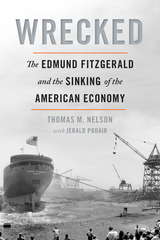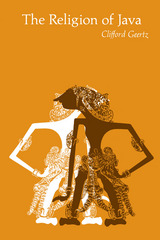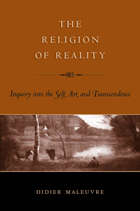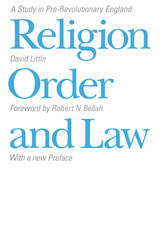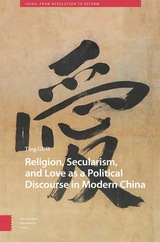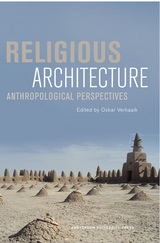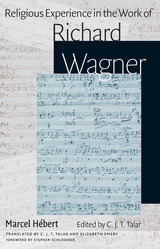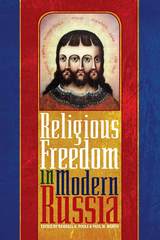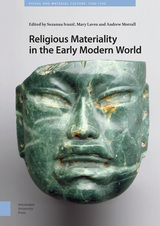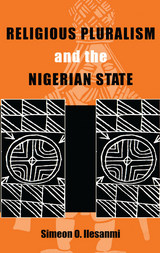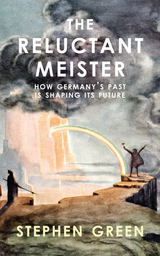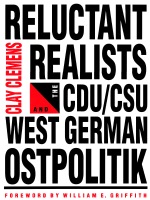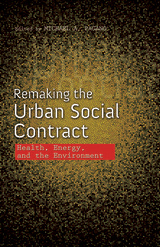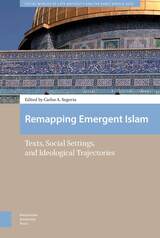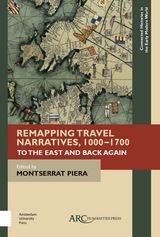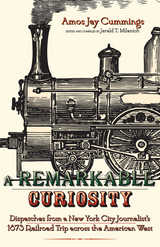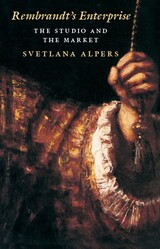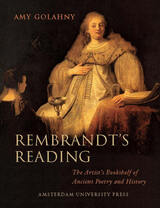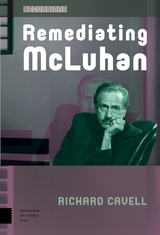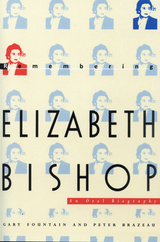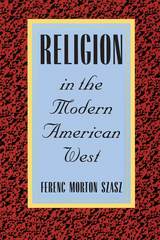 Religion in the Modern American West
Ferenc Morton Szasz
University of Arizona Press, 2000 When Americans migrated west, they carried with them not only their hopes for better lives but their religious traditions as well. Yet the importance of religion in the forging of a western identity has seldom been examined. In this first historical overview of religion in the modern American West, Ferenc Szasz shows the important role that organized religion played in the shaping of the region from the late-nineteenth to late-twentieth century. He traces the major faiths over that time span, analyzes the distinctive response of western religious institutions to national events, and shows how western cities became homes to a variety of organized faiths that cast only faint shadows back east. While many historians have minimized the importance of religion for the region, Szasz maintains that it lies at the very heart of the western experience. From the 1890s to the 1920s, churches and synagogues created institutions such as schools and hospitals that shaped their local communities; during the Great Depression, the Latter-day Saints introduced their innovative social welfare system; and in later years, Pentecostal groups carried their traditions to the Pacific coast and Southern Baptists (among others) set out in earnest to evangelize the Far West. Beginning in the 1960s, the arrival of Asian faiths, the revitalization of evangelical Protestantism, the ferment of post-Vatican II Catholicism, the rediscovery of Native American spirituality, and the emergence of New Age sects combined to make western cities such as Los Angeles and San Francisco among the most religiously pluralistic in the world. Examining the careers of key figures in western religion, from Rabbi William Friedman to Reverend Robert H. Schuller, Szasz balances specific and general trends to weave the story of religion into a wider social and cultural context. Religion in the Modern American West calls attention to an often-overlooked facet of regional history and broadens our understanding of the American experience.
Religion in the New Europe
Krzysztof Michalski
Central European University Press, 2006 The articles in this volume deal with the role of Christianity in the definition of European identity. Europeans often identify advanced civilizations with secularity. But religion is very much alive in other fast developing countries of the world. In Europe, nevertheless, the organized churches very much wanted to stress the Christian character of European identity, and this engendered a lively protest focusing on the perceived threat to the secular European tradition. Also, Europe is facing its greatest cultural challenge in the demand of Turkey to be admitted as a member, and in the demand of many Muslims in Europe, often citizens of the countries in which they live, to be recognized in their difference and at the same time integrated in the European national and supranational institutions.
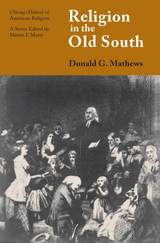 Religion in the Old South
Donald G. Mathews
University of Chicago Press, 1979 "A major study of American cultural history, a book distinguished both for its careful research and for its innovative interpretations. . . . Professor Mathews's book is an explanation of what religion meant in the everyday lives of southern whites and blacks. It is indispensable reading not just for those who want to know more about the Old South but for anyone who wants to understand the South today."—David Herbert Donald, Harvard University
"A major achievement—a magnificently provocative contribution to the understanding of the history of religion in America."—William G. McLoughlin, Book Reviews
"A meticulous and well-documented study . . . In the changing connotations of the word 'liberty' lie most of the dilemmas of Southern (and American) history, dilemmas Dr. Mathews analyses with considerable penetration."—Times Literary Supplement
"The most compact and yet comprehensive view of the Old South in its religious dimension that is presently available. This is a pioneering work by one who is widely read in the sources and is creative enough to synthesize and introduce fresh themes. . . . He makes a unique contribution to southern historiography which will act as a corrective upon earlier works. . . . Boldly stated, every library that consults Choice should purchase this volume."—Choice
"Mathews presents us with the findest and grandest history of old southern religion that one could imagine finding in so short a book on so large a topic. . . . Here stands in its own right a masterpiece of regional historiography of religion in America."—William A. Clebsch, Reviews in American History
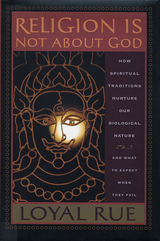 Religion is Not about God: How Spiritual Traditions Nurture our Biological Nature and What to Expect When They Fail
Loyal Rue
Rutgers University Press, 2006 Thousands of religious traditions have appeared over the course of human history but only a relative few have survived. Some speak of a myriad of gods, others of only one, and some recognize no gods at all. Volumes have been written attempting to prove the existence or nonexistence of supernatural being(s). So, if religion is not about God, then what is it about? In this provocative book, Loyal Rue contends that religion, very basically, is about us. Successful religions are narrative (myth) traditions that influence human nature so that we might think, feel, and act in ways that are good for us, both individually and collectively. Through the use of images, symbols, and rituals, religion promotes reproductive fitness and survival through the facilitation of harmonious social relations. Drawing on examples from the major traditions—Judaism, Christianity, Islam, Hinduism, and Buddhism—Rue shows how each religion, in its own way, has guided human behavior to advance the twin goals of personal fulfillment and social coherence. As all faiths are increasingly faced with a crisis of intellectual plausibility and moral relevance, this book presents a compelling and positive view of the centrality and meaning of religion.
 Religion is Not about God: How Spiritual Traditions Nurture our Biological Nature and What to Expect When They Fail
Loyal Rue
Rutgers University Press, 2006 2006 Choice Outstanding Academic Title
Thousands of religious traditions have appeared over the course of human history but only a relative few have survived. Some speak of a myriad of gods, others of only one, and some recognize no gods at all. Volumes have been written attempting to prove the existence or nonexistence of supernatural being(s). So, if religion is not about God, then what is it about? In this provocative book, Loyal Rue contends that religion, very basically, is about us. Successful religions are narrative (myth) traditions that influence human nature so that we might think, feel, and act in ways that are good for us, both individually and collectively. Through the use of images, symbols, and rituals, religion promotes reproductive fitness and survival through the facilitation of harmonious social relations. Drawing on examples from the major traditions—Judaism, Christianity, Islam, Hinduism, and Buddhism—Rue shows how each religion, in its own way, has guided human behavior to advance the twin goals of personal fulfillment and social coherence. As all faiths are increasingly faced with a crisis of intellectual plausibility and moral relevance, this book presents a compelling and positive view of the centrality and meaning of religion.
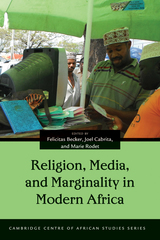 Religion, Media, and Marginality in Modern Africa
Felicitas Becker
Ohio University Press, 2018 In recent years, anthropologists, historians, and others have been drawn to study the profuse and creative usages of digital media by religious movements. At the same time, scholars of Christian Africa have long been concerned with the history of textual culture, the politics of Bible translation, and the status of the vernacular in Christianity. Students of Islam in Africa have similarly examined politics of knowledge, the transmission of learning in written form, and the influence of new media. Until now, however, these arenas—Christianity and Islam, digital media and “old” media—have been studied separately. Religion, Media, and Marginality in Modern Africa is one of the first volumes to put new media and old media into significant conversation with one another, and also offers a rare comparison between Christianity and Islam in Africa. The contributors find many previously unacknowledged correspondences among different media and between the two faiths. In the process they challenge the technological determinism—the notion that certain types of media generate particular forms of religious expression—that haunts many studies. In evaluating how media usage and religious commitment intersect in the social, cultural, and political landscapes of modern Africa, this collection will contribute to the development of new paradigms for media and religious studies. Contributors: Heike Behrend, Andre Chappatte, Maria Frahm-Arp, David Gordon, Liz Gunner, Bruce S. Hall, Sean Hanretta, Jorg Haustein, Katrien Pype, and Asonzeh Ukah.
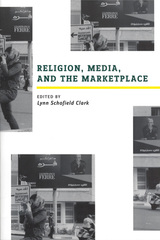 Religion, Media, and the Marketplace
Clark, Lynn Schofield
Rutgers University Press, 2007 Religion is infiltrating the arena of consumer culture in increasingly visible ways. We see it in a myriad of forms-in movies, such as Mel Gibson's The Passion of the Christ, on Internet shrines and kitschy Web "altars," and in the recent advertising campaign that attacked fuel-guzzling SUVs by posing the question: What would Jesus drive? In Religion, Media, and the Marketplace, scholars in history, media studies, and sociology explore this intersection of the secular and the sacred. Topics include how religious leaders negotiate between the competing aims of the mainstream and the devout in the commercial marketplace, how politics and religious beliefs combine to shape public policy initiatives, how the religious "other" is represented in the media, and how consumer products help define the practice of different faiths. At a time when religious fundamentalism in the United States and throughout the world is inseparable from political aims, this interdisciplinary look at the mutual influences between religion and the media is essential reading for scholars from a wide variety of disciplines.
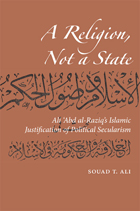 A Religion, Not a State: Ali 'Abd al-Raziq's Islamic justification of Political Secularism
Souad T Ali
University of Utah Press, 2009 Utah Series in Middle East Studies
In this notable work, Souad T. Ali examines the seminal writings of Egyptian reformist scholar Ali'Abd al-Raziq, often regarded as the intellectual father of Islamic secularism, and his controversial argument that the caliphate should be considered a human innovation, rather than a religious imperative. 'Abd al Raziq contended that Islam is "a religion, not a state; a message, not a government," a major departure from the traditional view that religious and political spheres are intertwined and inseparable in Islam. Opponents denounced 'Abd al-Raziq's ideas as a foreign corruption imported from the West. Ali's careful, objective, and scholarly examination of 'Abd al-Raziq's work, however, reveals that his arguments are not based in Western thought. Rather, they sit firmly within the dictates of Islam's sacred texts, particularly the Quran and Hadith, and also enjoy considerable support from the historical record. This analysis critically challenges prevalent misinterpretations of Islam that have endured for centuries. Ali recognizes the varied models and discourses that have arisen throughout different epochs, especially so the role that Western intervention has played in placing the question of Islam's modernity at the forefront of intellectual debate. Throughout, the study emphasizes the atmosphere of openness and tolerance that is a requisite for free, intelligent debate.
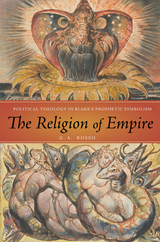 The Religion of Empire: Political Theology in Blake's Prophetic Symbolism
G. A. Rosso
Ohio State University Press, 2016 The Religion of Empire: Political Theology in Blake’s Prophetic Symbolism is the first full-length study devoted to interpreting Blake’s three long poems, showing the ways in which the Bible, myth, and politics merge in his prophetic symbolism. In this book, G. A. Rosso examines the themes of empire and religion through the lens of one of Blake’s most distinctive and puzzling images, Rahab, a figure that anchors an account of the development of Blake’s political theology in the latter half of his career. Through the Rahab figure, Rosso argues, Blake interweaves the histories of religion and empire in a wide-ranging attack on the conceptual bases of British globalism in the long eighteenth century. This approach reveals the vast potential that the question of religion offers to a reconsideration of Blake’s attitude to empire.
The Religion of Empire also reevaluates Blake’s relationship with Milton, whose influence Blake both affirms and contests in a unique appropriation of Milton’s prophetic legacy. In this context, Rosso challenges recent views of Blake as complicit with the nationalism and sexism of his time, expanding the religion-empire nexus to include Blake’s esoteric understanding of gender. Foregrounding the role of female characters in the longer prophecies, Rosso discloses the variegated and progressive nature of Blake’s apocalyptic humanism.
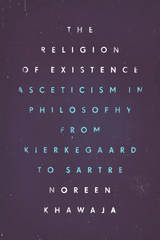 The Religion of Existence: Asceticism in Philosophy from Kierkegaard to Sartre
Noreen Khawaja
University of Chicago Press, 2016 TheReligion of Existence reopens an old debate on an important question: What was existentialism?
At the heart of existentialism, Noreen Khawaja argues, is a story about secular thought experimenting with the traditions of European Christianity. This book explores how a distinctly Protestant asceticism formed the basis for the chief existentialist ideal, personal authenticity, which is reflected in approaches ranging from Kierkegaard’s religious theory of the self to Heidegger’s phenomenology of everyday life to Sartre’s global mission of atheistic humanism. Through these three philosophers, she argues, we observe how ascetic norms have shaped one of the twentieth century’s most powerful ways of thinking about identity and difference—the idea that the “true” self is not simply given but something that each of us is responsible for producing.
Engaging with many central figures in modern European thought, this book will appeal to philosophers and historians of European philosophy, scholars of modern Christianity, and those working on problems at the intersection of religion and modernity.
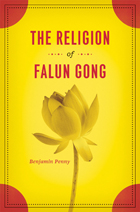 The Religion of Falun Gong
Benjamin Penny
University of Chicago Press, 2012 In July 1999, a mere seven years after the founding of the religious movement known as the Falun Gong, the Chinese government banned it. Falun Gong is still active in other countries, and its suppression has become a primary concern of human rights activists and is regularly discussed in dealings between the Chinese government and its Western counterparts. But while much has been written on Falun Gong’s relation to political issues, no one has analyzed in depth what its practitioners actually believe and do. The Religion of Falun Gong remedies that omission, providing the first serious examination of Falun Gong teachings. Benjamin Penny argues that in order to understand Falun Gong, one must grasp the beliefs, practices, and texts of the movement and its founder, Li Hongzhi. Contextualizing Li’s ideas in terms of the centuries-long Chinese tradition of self-cultivation and the cultural world of 1980s and ’90s China—particularly the upwelling of biospiritual activity and the influx of translated works from the Western New Age movement—Penny shows how both have influenced Li’s writings and his broader view of the cosmos. An illuminating look at this controversial movement, The Religion of Falun Gong opens a revealing window into the nature and future of contemporary China.
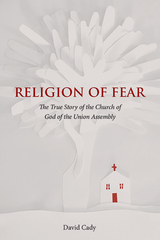 Religion of Fear: The True Story of the Church of God of the Union Assembly
David Cady
University of Tennessee Press, 2019 Religion of Fear reveals the story of how a Pentecostal sect, the Church of God of the Union Assembly, a small splinter group of the holiness Church of God movement, evolved into one of the largest and wealthiest cults in America. At its height in 1995, the Union Assembly included fifty-four churches spread across nineteen states. Spanning nearly a hundred years and three generations of family leadership and relying on hundreds of interviews with members and former members, David Cady’s groundbreaking investigation begins, in 1917, with the Church’s illiterate but magnetic founder, Charlie (C. T.) Pratt, summoning a congregation of resilient followers with little more than a flair for spectacle. As power dynamics stir within the maturing Church, Cady turns to C. T.’s fourth son, Jesse, who conspires to wrest the Union Assembly from his five brothers and dismiss his own parents from the church they had created. Jesse dominated the Church with fear and a demand of total obedience from its nearly 15,000 members until his mysterious death at age fifty-six.
As Cady reveals, this event triggered a succession crisis in the Pratt-family ranks as Jesse’s wife fostered her son Jesse Junior’s rise to power and spurned other heirs presumptive to the Church. Jesse Junior turned out to be a tormented leader who drove his followers to the brink of poverty with an uncompromising demand that they give their all to God—and to him. The church’s fortune squandered and its future under threat, Jesse Junior’s mother was finally forced to have her favored son removed and defrocked. For all its troubling twists and turns, Cady’s chronicle ends with a minor miracle, as Jesse’s younger brother, Charlie T. Pratt III, takes over leadership and manages to expel the oppressive air of authoritarianism from the body of the Church and hold the community together in the process.
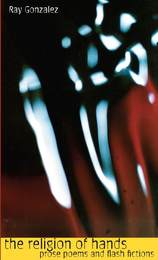 The Religion of Hands: Prose Poems and Flash Fictions
Ray Gonzalez
University of Arizona Press, 2005 "A man doesn’t sleep with the moon. He sleeps with his hunger, gathers bowls of avocados and wipes his lips with his sins."
The Religion of Hands does not foster sleep. Look quickly and you will catch the hint of a fox streaking in front of your car’s headlights at night. Look more carefully out your bedroom window and you may see your life going by, lost loved ones waving hello.
"Who were you when the stars were misinterpreted as the fingertips of God?"
Ray Gonzalez blends symbolic play with lyrical beauty as he works from a vast and complex palette to infuse popular culture with myth. The Religion of Hands is imbued with magical realism: a suffocating dream of tamales, mysterious reptilian allusions, a man who "finds God walking down the stairs to hand him an old, tattered phonebook from the year he was born." It offers strange prophecies: "A steady vegetation will grow across the empire as more homeboys are killed in drive-bys. . . . Microscopic scratches on an old vinyl record will form a message discovered in twenty more years when the album is bought at a garage sale." And in 14 flash fictions, it tells of a tiny old man kept in a glass jar, an accordion stored in an old family trunk, tales of sharks and bandits. The religion of hands has its own unspoken sacraments. "The fingers take over, teaching whoever holds the moment that the rapid weight of the open hands is a dangerous way to live."
Seamlessly, effortlessly, multi-dexterously, Ray Gonzalez spins words that speak our very dreams.
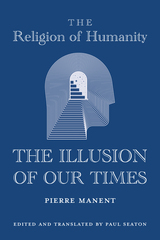 The Religion of Humanity: The Illusion of Our Times
Pierre Manent
St. Augustine's Press, 2022 "Is not modern democracy the finally-found form of the religion of Humanity?" (2007)
The Religion of Humanity: The Illusion of Our Time is the first anthology in any language of the writings of the contemporary French political philosopher, Pierre Manent, on “the religion of Humanity.” The striking phrase comes from nineteenth-century French thinker, Auguste Comte (1798–1857). Comte coined the phrase and indeed created an atheistic religion of a self-adoring Humanity. In the aftermath of the Cold War, Manent observed victorious democracy interpreting itself in a similar framework. He took it upon himself to track this development, analyze it, and warn his fellow Europeans of its deleterious political, intellectual, moral, and spiritual effects. With conceptual precision and (most often) a sober tone, many contemporary sacred cows were gored. But in addition to cursing the humanitarian darkness, he also lit many candles of judicious political, philosophical, moral, and spiritual analysis. This anthology is thus almost unique in its subject matter, and certainly unique in its treatment of the subject. It is a rarity and gem: a first-rate work of political philosophy.
The Religion of Java
Clifford Geertz
University of Chicago Press, 1976 Written with a rare combination of analysis and speculation, this comprehensive study of Javanese religion is one of the few books on the religion of a non-Western people which emphasizes variation and conflict in belief as well as similarity and harmony. The reader becomes aware of the intricacy and depth of Javanese spiritual life and the problems of political and social integration reflected in the religion.
The Religion of Java will interest specialists in Southeast Asia, anthropologists and sociologists concerned with the social analysis of religious belief and ideology, students of comparative religion, and civil servants dealing with governmental policy toward Indonesia and Southeast Asia.
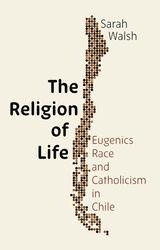 The Religion of Life: Eugenics, Race, and Catholicism in Chile
Sarah Walsh
University of Pittsburgh Press, 2021 The Religion of Life examines the interconnections and relationship between Catholicism and eugenics in early twentieth-century Chile. Specifically, it demonstrates that the popularity of eugenic science was not diminished by the influence of Catholicism there. In fact, both eugenics and Catholicism worked together to construct the concept of a unique Chilean race, la raza chilena. A major factor that facilitated this conceptual overlap was a generalized belief among historical actors that male and female gender roles were biologically determined and therefore essential to a functioning society. As the first English-language study of eugenics in Chile, The Religion of Life surveys a wide variety of different materials (periodicals, newspapers, medical theses, and monographs) produced by Catholic and secular intellectuals from the first half of the twentieth century. What emerges from this examination is not only a more complex rendering of the relationship between religion and science but also the development of White supremacist logics in a Latin American context.
The Religion of Reality: Inquiry into the Self, Art, and Transcendence
Didier Maleuvre
Catholic University of America Press, 2006 The book first argues that religious feeling persists in the secular western mind; that it has taken refuge in the unlikeliest of camps, indeed with the supposed debunker of religious creed: the rationalist existential ego.
The Religion of Science Fiction
Frederick A. Kreuziger
University of Wisconsin Press, 1986 Science fiction captures contemporary sentiment with its faith in a scientific/technological future, its explorations of the ultimate meaning of man’s existence. Kreuziger is interested particularly in the apocalyptic visions of science fiction compared to the biblical revelations of John and Daniel. For some time our confidence has been placed largely in science, which has practically become a religion. Science fiction articulates the consequences of a faith in a technological future.
Religion of Soldier and Sailor
Willard L. Sperry
Harvard University Press The four volumes in this series assess the moral and spiritual resources available to Americans confronted with the problems of the post-war world. What have the war years disclosed about the religious life of our people? What elements of strength have we found; what weaknesses discovered? What needs most to be done in those areas where religion can be of direct help? Some twenty writers, each a recognized specialist in his field or an accredited spokesman for his subject, attempt to ascertain the facts and suggest possible answers to these questions.
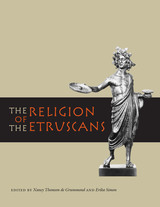 The Religion of the Etruscans
Edited by Nancy Thomson de Grummond and Erika Simon
University of Texas Press, 2006 Devotion to religion was the distinguishing characteristic of the Etruscan people, the most powerful civilization of Italy in the Archaic period. From a very early date, Etruscan religion spread its influence into Roman society, especially with the practice of divination. The Etruscan priest Spurinna, to give a well-known example, warned Caesar to beware the Ides of March. Yet despite the importance of religion in Etruscan life, there are relatively few modern comprehensive studies of Etruscan religion, and none in English. This volume seeks to fill that deficiency by bringing together essays by leading scholars that collectively provide a state-of-the-art overview of religion in ancient Etruria. The eight essays in this book cover all of the most important topics in Etruscan religion, including the Etruscan pantheon and the roles of the gods, the roles of priests and divinatory practices, votive rituals, liturgical literature, sacred spaces and temples, and burial and the afterlife. In addition to the essays, the book contains valuable supporting materials, including the first English translation of an Etruscan Brontoscopic Calendar (which guided priests in making divinations), Greek and Latin sources about Etruscan religion (in the original language and English translation), and a glossary. Nearly 150 black and white photographs and drawings illustrate surviving Etruscan artifacts and inscriptions, as well as temple floor plans and reconstructions.
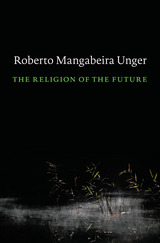 The Religion of the Future
Roberto Mangabeira Unger
Harvard University Press, 2014 How can we live in such a way that we die only once? How can we organize a society that gives us a better chance to be fully alive? How can we reinvent religion so that it liberates us instead of consoling us?
These questions stand at the center of Roberto Mangabeira Unger’s The Religion of the Future. Both a book about religion and a religious work in its own right, it proposes the content of a religion that can survive faith in a transcendent God and in life after death. According to this religion—the religion of the future—human beings can be more human by becoming more godlike, not just later, in another life or another time, but right now, on Earth and in their own lives.
Unger begins by facing the irreparable flaws in the human condition: our mortality, groundlessness, and insatiability. He goes on to discuss the conflicting approaches to existence that have dominated the last 2,500 years of the history of religion. Turning next to the religious revolution that we now require, he explores the political ideal of this revolution, an idea of deep freedom. And he develops its moral vision, focused on a refusal to squander life.
The Religion of the Future advances Unger’s philosophical program: a philosophy for which history is open, the new can happen, and belittlement need not be our fate.
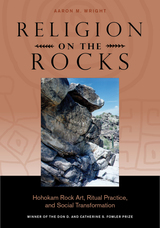 Religion on the Rocks: Hohokam Rock Art, Ritual Practice, and Social Transformation
Aaron M. Wright
University of Utah Press, 2014 Winner of the Don D. and Catherine S. Fowler Prize
We are nearly all intrigued by the petroglyphs and pictographs of the American Southwest, and we commonly ask what they “mean”. Religion on the Rocks redirects our attention to the equally important matter of what compelled ancient peoples to craft rock art in the first place. To examine this question, Aaron Wright presents a case study from Arizona's South Mountains, an area once flanked by several densely populated Hohokam villages. Synthesizing results from recent archaeological surveys, he explores how the mountains' petroglyphs were woven into the broader cultural landscape and argues that the petroglyphs are relics of a bygone ritual system in which people vied for prestige and power by controlling religious knowledge. The features and strategic placement of the rock art suggest this dimension of Hohokam ritual was participatory and prominent in village life. Around AD 1100, however, petroglyph creation and other ritual practices began to wane, denoting a broad transformation of the Hohokam social world. Wright’s examination of the South Mountains petroglyphs offers a novel narrative of how Hohokam villagers negotiated a concentration of politico-religious authority around platform mounds. Readers will come away with a better understanding of the Hohokam legacy and a greater appreciation for rock art's value to anthropology.
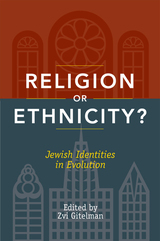 Religion or Ethnicity?: Jewish Identities in Evolution
Gitelman, Zvi
Rutgers University Press, 2009 Can someone be considered Jewish if he or she never goes to synagogue, doesn't keep kosher, and for whom the only connection to his or her ancestral past is attending an annual Passover seder? In Religion or Ethnicity? fifteen leading scholars trace the evolution of Jewish identity. The book examines Judaism from the Greco-Roman age, through medieval times, modern western and eastern Europe, to today. Jewish identity has been defined as an ethnicity, a nation, a culture, and even a race. Religion or Ethnicity? questions what it means to be Jewish. The contributors show how the Jewish people have evolved over time in different ethnic, religious, and political movements. In his closing essay, Gitelman questions the viability of secular Jewishness outside Israel but suggests that the continued interest in exploring the relationship between Judaism's secular and religious forms will keep the heritage alive for generations to come.
Religion or God?: The Dudleian Lecture for 1926 delivered in Harvard University
Edward S. Drown
Harvard University Press Dr. Drown discusses in this lecture the question whether religion is to be conceived as the self-product of human desires or as the revealing power of a living God. In the first case, religion becomes nothing more than the outward projection of human ideals and purposes, a reflection of one's self in a somewhat distorted mirror. In the second case, religion becomes a strengthening belief in a reality outside ourselves that can uphold and sustain us. The author reviews the arguments for the first view and rejects them as unsatisfactory, and then argues for the reality of God. His purpose is to direct attention to the problem and to the danger of letting “religion” usurp the place of the living God.
Religion, Order, and Law
David Little
University of Chicago Press, 1984 "The issue of the Protestant ethic and the spirit of capitalism has been debated endlessly, but few scholars have seriously continued Weber's own research into the Reformation sources of seventeenth-century England. David Little's study was one of the first to do so, and remains an important contribution."—Guenther Roth, University of Washington
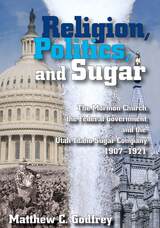 Religion, Politics, and Sugar: The LDS Church, the Federal Government, and the Utah-Idaho Sugar Company, 1907-1927
Matthew C. Godfrey
Utah State University Press, 2007 Mary Lois Walker Morris was a Mormon woman who challenged both American ideas about marriage and the U.S. legal system. Before the Manifesto provides a glimpse into her world as the polygamous wife of a prominent Salt Lake City businessman, during a time of great transition in Utah. This account of her life as a convert, milliner, active community member, mother, and wife begins in England, where her family joined the Mormon church, details her journey across the plains, and describes life in Utah in the 1880s. Her experiences were unusual as, following her first husband's deathbed request, she married his brother as a plural wife in the Old Testament tradition of levirate marriage. Mary Morris's memoir frames her 1879 to 1887 diary with both reflections on earlier years and passages that parallel entries in the day book, giving readers a better understanding of how she retrospectively saw her life. The thoroughly annotated diary offers the daily experience of a woman who kept a largely self-sufficient household, had a wide social network, ran her own business, wrote poetry, and was intellectually curious. The years of "the Raid" (federal prosecution of polygamists) led Mary and Elias Morris to hide their marriage on "the underground," and her to perjury during Elias's trial for unlawful cohabitation. The book ends with Mary Lois's arrival at the Salt Lake Depot after three years in exile in Mexico with a polygamist colony.
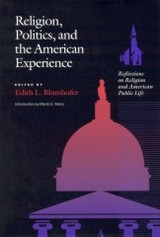 Religion, Politics and the American Experience: Reflections on Religion and American Public Life
Edith L. Blumhofer
University of Alabama Press, 2002 This challenging collection of essays offers a refreshing approach to the troubling--and timely--subject of religion and public policy in America, and the ways in which issues of church and state affect our national identity. The result of a series of conferences on religion and politics conducted by the Public Religion project at the University of Chicago, funded by a grant from the Pew Charitable Trust, this collection brings together an extraordinarily diverse set of contributors. Represented within its pages are the ideas and opinions of scholars, politicians, and religious leaders with backgrounds in law, politics, history, and divinity, among them Senator Paul Simon of Illinois. With its wide range of critical approaches and varied perspectives, this volume makes a vibrant contribution to the national dialogue on politics and religion. Chief among the essay topics are the evangelical roots of American political life; early conflicts between Enlightenment thinking and spiritual impulses in developing a national identity; the practical problems that today's politicians face in campaigning; the impact of constitutional and legal language regarding our definitions of religion; and the way in which the media's treatment of our spiriutal life frames our perceptions of it. These thought-provoking essays will inspire readers to rethink, argue, perhaps act, but most importantly, to converse about this timely and important issue. This volume will have wide cross-disciplinary appeal. Students and scholars of history, religious studies, and political science will find great value within its pages, as will scholars of divinity and law, and members of this general public concerned with the intersection of faith and politics in American life.
 Religion Politics Europe
James E. Bradley
University of Notre Dame Press, 2001 JAMES E. BRADLEY is Geoffrey W. Bromiley Professor of Church History at Fuller Theological Seminary.
DALE K. VAN KLEY is professor of early modern European history at Ohio State University.
----------
"... fascinatingly clear. The whole collection therefore constitutes a landmark in the recent rehabilitation of religion into our understanding of the eighteenth century and how it worked." --French History
"The editors, Dale Van Kley, a professor of history at Ohio State University, and James E. Bradley, a professor of church history at Fuller Seminary, have produced a remarkably coherent collection that should interest serious students of the Enlightenment. It is a carefully crafted book and will reward thoughtful reading" --History: Reviews of New Book
"In their focal coherence, these essays provide us with a model of the comparative study of religion during the Enlightenment." --Virginia Quarterly Review
"Bradly and Van Kley's splendid introduction provides a fascinating overview of the earlier literature on the subject and draws credible connections between the diverse accounts that follow. Each of the chapers is a substantial piece of work, written by seasoned scholars who command a broad array of primary sources in making their arguments."--The Journal of Religion
"This volume contains a superb collection of essays that will revolutionize current scholarship on religion, politics, and Enlightenment in eighteenth-century Europe." --Susan Rosa, associate professor of history, Northeastern Illinois University
"This book sets new standards for the comparative study of religion during the Enlightenment. It challenges us to correct the distorting effects of 1789, to consider the religious rationales of the anciens regimes, and to weigh the challenges that orthodoxy and heterodoxy posed to them. It is certain to be the starting point for many debates." --Jonathan Clark, author of English Society 1660-1832 and The Language of Liberty 1660-1832
"This is a beautifully conceived collection of essays, remarkably coherent in its argument for the centrality of religious debates in the genesis of political dissent in the eighteenth century. Constitutional government, representative institutions, and respect for individual rights have long been viewed as flowing primarily from heretical and enlightened sources that challenged Christian orthodoxy and political absolutism. The contributors to this volume show how debates within Christian churches were equally significant as a source for ideas and institutions that challenged religious and political authority.… This book is a model for how comparative studies can succeed in opening up questions of the greatest interest to historians of Europe." --Thomas Kselman, professor of history, University of Notre Dame
"A fascinating journey through the Europe of the Enlightenment . . . in this important volume an extraordinarily incisive picture is offered to the reader. Religion and Politics in Enlightenment Europe is a fundamental work that solicits a renewed reflection on the great changes in progress in European society before the French Revolution and on the deeply dynamic role played by religion and particularly by religious dissent to facilitate the difficult passage from the Ancien Régime to the modern world." --Professor Mario Rosa, Sculoa Normale Superiore
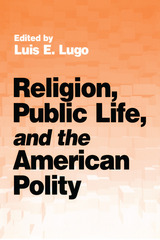 Religion, Public Life, and the American Polity
Luis F. Lugo
University of Tennessee Press, 2003 Religion, Public Life, and the American Polity brings together ten essays exploring the continuing vitality of religion in American public life. Featuring contributions by leading political scientists and legal scholars, the volume locates current debates within the broader contexts of history, society, and constitutional theory.
The book opens with an investigation of the contending positions on church-state relations in current American thought. The next section offers fresh reappraisals of the thinking of the Founders, especially the contributions of Madison and Jefferson; some important challenges to conventional wisdom—including the common view of Jefferson as a strict separationist—emerge from this section. The essays in the third section examine the relationship between religion and the law, showing that the courts’ decisions in First Amendment cases reveal a tendency toward incoherence and majoritarian bias. In the final section, the discussion extends to the more indirect and subtle ways in which religion and American liberal culture influence each other—for better and for worse.
Taken together, these essays shed a much-needed light on how the state can accommodate the multiplicity of faiths held by its citizens, especially as those faiths take on public expression beyond the institutional church.
 Religion, Scholarship, and Higher Education: Perspectives, Models, and Future Prospects
Andrea Sterk
University of Notre Dame Press, 2002 Religion, Scholarship, and Higher Education explores foundational issues surrounding the interaction of religion and the academy in the twenty-first century. Featuring the work of eighteen scholars from diverse institutional, disciplinary, and religious backgrounds, this outstanding collection of essays issues from a three-year Lilly Seminar on Religion and Higher Education. Reflecting the diversity of the seminar participants, this insightful volume presents a wide variety of viewpoints on the role of religion in higher education and different approaches to religiously informed scholarship and teaching.
Religion, Scholarship, and Higher Education is distinct in its orientation toward the personal and the practical. Contributors use personal examples to demonstrate how individual religious beliefs and backgrounds shape the way an educator approaches research and teaching.
The first part of the book addresses foundational issues, offering a range of perspectives on the current state of affairs and future prospects for the interrelation of religion and academic endeavor. Part II treats specific academic disciplines as they relate to religion and research and provides several models of scholarship grounded in or informed by religious traditions. The final section of the volume presents five different approaches to teaching. Contributors reflect on how religious perspectives or commitments influence the way in which they understand their role as university or college teachers and carry out their responsibilities in the classroom.
Sure to capture the interest of scholars, teachers, and administrators alike, this volume features essays from Nicholas Wolterstorff, James Turner, Alan Wolfe, David A. Hollinger, Mark R. Schwehn, John McGreevy, Nancy T. Ammerman, Roger Lundin, Brian E.Daley, S.J., Clarke E. Cochran, Serene Jones, Richard J. Bernstein, Mark A. Noll, Denis Donoghue, Robert Wuthnow, Jean Bethke Elshtain, Susan Handelman, and Francis Oakley.
Religion, Secularism, and Love as a Political Discourse in Modern China
Ting Guo
Amsterdam University Press, 2025 What is the meaning of love in modern Chinese politics? Why has ai . (love) been a crucial political discourse for secular nationalism for generations of political leaders as a powerful instrument to the present day? This book offers the first systematic examination of the ways in which the notion of love has been introduced, adapted, and engineered as a political discourse for the building and rebuilding of a secular modern nation, all the while appropriating Confucianism, Christianity, popular religion, ghost stories, political religion, and their religious affects. The insights of this exploration expand not only the discussion of the role of emotions in the project of Chinese modernity, but also the study of affective governance and religious nationalisms around the world today.
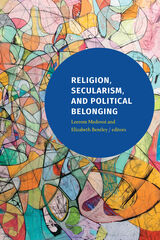 Religion, Secularism, and Political Belonging
Leerom Medovoi and Elizabeth Bentley, editors
Duke University Press, 2021 Working in four scholarly teams focused on different global regions—North America, the European Union, the Middle East, and China—the contributors to Religion, Secularism, and Political Belonging examine how new political worlds intersect with locally specific articulations of religion and secularism. The chapters address many topics, including the changing relationship between Islam and politics in Tunisia after the 2010 revolution, the influence of religion on the sharp turn to the political right in Western Europe, understandings of Confucianism as a form of secularism, and the alliance between evangelical Christians and neoliberal business elites in the United States since the 1970s. This volume also provides a methodological template for how humanities scholars around the world can collaboratively engage with sweeping issues of global significance.
Contributors. Markus Balkenhol, Elizabeth Bentley, Kambiz GhaneaBassiri, David N. Gibbs, Ori Goldberg, Marcia Klotz, Zeynep Kurtulus Korkman, Leerom Medovoi, Eva Midden, Mohanad Mustafa, Mu-chou Poo, Shaul Setter, John Vignaux Smith, Pooyan Tamimi Arab, Ernst van den Hemel, Albert Welter, Francis Ching-Wah Yip, Raef Zreik
 Religion: The Classical Theories
James Thrower
Georgetown University Press This comprehensive introduction to theories of religion is the first single-volume exploration of ideas put forward by both believers and non-believers. James Thrower analyzes the different types of explanations of religion, not just the thoughts of individuals, advanced primarily—but not exclusively—from within the Western tradition. He begins by looking at religious explanations of religion, which define religion as revelation, experience or philosophy (Plato, Kant, and Hegel). He then examines the naturalist, or nonreligious, explanations, from the disciplines of anthropology, psychology, and sociology, including the "masters of suspicion" (including Feurbach, Nietzsche, Marx, Tylor, Frazer, and Freud). The scope of this book ranges from the classical, Semitic, and Indian religious traditions through contemporary thinkers. Thrower concludes by considering the future of the religions of the world in light of the increasingly close inter-religious encounters that are becoming a feature of the global village of the twenty-first century.
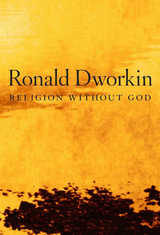 Religion without God
Ronald Dworkin
Harvard University Press, 2013 In his last book, Ronald Dworkin addresses questions that men and women have asked through the ages: What is religion and what is God’s place in it? What is death and what is immortality? Based on the 2011 Einstein Lectures, Religion without God is inspired by remarks Einstein made that if religion consists of awe toward mysteries which “manifest themselves in the highest wisdom and the most radiant beauty, and which our dull faculties can comprehend only in the most primitive forms,” then, he, Einstein, was a religious person.
Dworkin joins Einstein’s sense of cosmic mystery and beauty to the claim that value is objective, independent of mind, and immanent in the world. He rejects the metaphysics of naturalism—that nothing is real except what can be studied by the natural sciences. Belief in God is one manifestation of this deeper worldview, but not the only one. The conviction that God underwrites value presupposes a prior commitment to the independent reality of that value—a commitment that is available to nonbelievers as well. So theists share a commitment with some atheists that is more fundamental than what divides them. Freedom of religion should flow not from a respect for belief in God but from the right to ethical independence.
Dworkin hoped that this short book would contribute to rational conversation and the softening of religious fear and hatred. Religion without God is the work of a humanist who recognized both the possibilities and limitations of humanity.
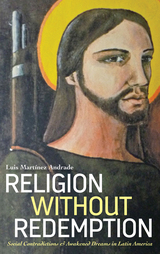 Religion Without Redemption: Social Contradictions and Awakened Dreams in Latin America
Luis Martinez Andrade
Pluto Press, 2015 The world’s eyes are on Latin America as a place of radical political inspiration, offering alternatives to the neoliberal model. Religion Without Redemption examines the history of religious and political ideas in Latin America, in order to show how and why the continent’s politics and economics work as they do.
Martínez Andrade focuses on the central role of religion in the region and how it influences people’s interaction with changes in modern economics. Capitalism in Latin America, Martínez Andrade argues, has taken on religious characteristics, with places of worship—shopping malls and department stores—as well as its own prophets. This form of cultural religion is often contradictory in surprising ways: not only does it legitimate oppression, it can also be a powerful source of rebellion, unveiling a subversive side to the status quo. Religion Without Redemption advances the ideas of liberation theory, and challenges the provincialism to which many Latin American thinkers are usually consigned.
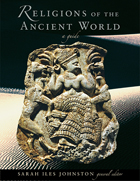 Religions of the Ancient World: A Guide
Sarah Iles Johnston, General Editor
Harvard University Press, 2004 Religious beliefs and practices, which permeated all aspects of life in antiquity, traveled well-worn routes throughout the Mediterranean: itinerant charismatic practitioners journeying from place to place peddled their skills as healers, purifiers, cursers, and initiators; and vessels decorated with illustrations of myths traveled with them. New gods encountered in foreign lands by merchants and conquerors were sometimes taken home to be adapted and adopted. A full understanding of this complex spiritual world unfolds in Religions of the Ancient World, the first basic reference work that collects and organizes available information to offer an expansive, comparative perspective.
At once sweeping in scope and groundbreaking in format, the Guide eschews the usual encyclopedic approach, instead presenting, side by side, materials from ten cultures and traditions. Thus specific beliefs, cults, gods, and ritual practices that arose and developed in Mediterranean religions--of Egypt, Anatolia and the Near East, Mesopotamia, Iran, Greece, and the Roman world, from the third millennium to the fourth century C.E.--are interpreted in comparison with one another, and with reference to aspects that crisscross cultural boundaries, such as Cosmology, Myth, Law and Ethics, and Magic. Written by leading scholars of ancient religion, the essays in this guide sketch the various religious histories, raise central theoretical issues, and examine individual topics such as Sacred Times and Spaces; Prayers, Hymns, Incantations, and Curses; Sin, Pollution, and Purity; Death, the Afterlife, and Other Last Things; Divination and Prophecy; Deities and Demons; and Sacred Texts and Canonicity.
Clearly and stylishly written, grandly illustrated, this comprehensive work welcomes readers as never before into the diversity and interconnections of religion in the ancient world.
The Religions of the People in Sixteenth-Century Champagne
A. N. Galpern
Harvard University Press, 1976 This study in religious anthropology explores the social history of popular belief. The book begins with an evocation of the river towns, open fields, and vineyards of Champagne. In addition to the historical geography and quantitative material that are hallmarks of the French tradition, the author studies the rich artistic evidence that still graces the provincial churches.
Galpern interprets religious behavior at the beginning of the century as a lingering response to difficulties of the late Middle Ages. The nascent Protestant movement highlights the ways in which many Catholics modified their practices, yet remained orthodox. The book charts the paths of antipathy that converged in civil war, and concludes with a discussion of the late-sixteenth-century atmosphere of revivalism, which mimicked the earlier spiritualclimate.
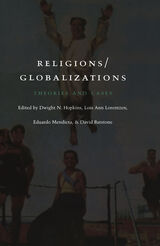 Religions/Globalizations: Theories and Cases
Dwight N. Hopkins, Lois Ann Lorentzen, Eduardo Mendieta, and David Batstone, eds.
Duke University Press, 2001 For the majority of cultures around the world, religion permeates and informs everyday rituals of survival and hope. But religion also has served as the foundation for national differences, racial conflicts, class exploitation, and gender discrimination. Indeed, religious spirituality, having been transformed by contemporary economic and political events, remains both empowering and controversial. Religions/Globalizations examines the extent to which globalization and religion are inseparable terms, bound up with each other in a number of critical and mutually revealing ways. As the contributors to this work suggest, a crucial component of globalization—the breakdown of familiar boundaries and power balances—may open a space in which religion can be deployed to help refabricate new communities. Examples of such deployments can be found in the workings of liberation theology in Latin America. In other cases, however, the operations of globalization have provided a space for strident religious nationalism and identity disputes to flourish. Is there in fact a dialectical tension between religion and globalization, a codependence and codeterminism? While religion can be seen as a globalizing force, it has also been transformed and even victimized by globalization. A provocative assessment of a contemporary phenomenon with both cultural and political dimensions, Religions/Globalizations will interest not only scholars in religious studies but also those studying Latin America, the Middle East, South Asia, and Africa. Contributors. David Batstone, Berit Bretthauer, Enrique Dussel, Dwight N. Hopkins, Mark Juergensmeyer, Lois Ann Lorentzen, Eduardo Mendieta, Vijaya Rettakudi Nagarajan, Kathryn Poethig, Lamin Sanneh, Linda E. Thomas
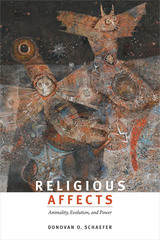 Religious Affects: Animality, Evolution, and Power
Donovan O. Schaefer
Duke University Press, 2015 In Religious Affects Donovan O. Schaefer challenges the notion that religion is inextricably linked to language and belief, proposing instead that it is primarily driven by affects. Drawing on affect theory, evolutionary biology, and poststructuralist theory, Schaefer builds on the recent materialist shift in religious studies to relocate religious practices in the affective realm—an insight that helps us better understand how religion is lived in conjunction with systems of power. To demonstrate religion's animality and how it works affectively, Schaefer turns to a series of case studies, including the documentary Jesus Camp and contemporary American Islamophobia. Placing affect theory in conversation with post-Darwinian evolutionary theory, Schaefer explores the extent to which nonhuman animals have the capacity to practice religion, linking human forms of religion and power through a new analysis of the chimpanzee waterfall dance as observed by Jane Goodall. In this compelling case for the use of affect theory in religious studies, Schaefer provides a new model for mapping relations between religion, politics, species, globalization, secularism, race, and ethics.
Religious Architecture: Anthropological Perspectives
Edited by Oskar Verkaaik
Amsterdam University Press, 2013 Borrowing from a range of theories on spacemaking and material religion, and with contributions from anthropologists working in the United Kingdom, Mali, Brazil, Spain, and Italy, this fascinating and comprehensive study develops an anthropological perspective on modern religious architecture including mosques, churches, and synagogues. Religious Architecture examines how religious buildings take their place in opposition to their secular surroundings and, in so doing, function not only as community centers in urban daily life, but also as evocations of the sublime that help believers to move beyond the boundaries of modern subjectivity.
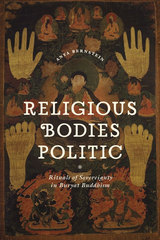 Religious Bodies Politic: Rituals of Sovereignty in Buryat Buddhism
Anya Bernstein
University of Chicago Press, 2013 Religious Bodies Politic examines the complex relationship between transnational religion and politics through the lens of one cosmopolitan community in Siberia: Buryats, who live in a semiautonomous republic within Russia with a large Buddhist population. Looking at religious transformation among Buryats across changing political economies, Anya Bernstein argues that under conditions of rapid social change—such as those that accompanied the Russian Revolution, the Cold War, and the fall of the Soviet Union—Buryats have used Buddhist “body politics” to articulate their relationship not only with the Russian state, but also with the larger Buddhist world. During these periods, Bernstein shows, certain people and their bodies became key sites through which Buryats conformed to and challenged Russian political rule. She presents particular cases of these emblematic bodies—dead bodies of famous monks, temporary bodies of reincarnated lamas, ascetic and celibate bodies of Buddhist monastics, and dismembered bodies of lay disciples given as imaginary gifts to spirits—to investigate the specific ways in which religion and politics have intersected. Contributing to the growing literature on postsocialism and studies of sovereignty that focus on the body, Religious Bodies Politic is a fascinating illustration of how this community employed Buddhism to adapt to key moments of political change.
Religious Change in America
Andrew Greeley
Harvard University Press, 1996 Many observers assume that America is a much less religious nation than it was forty years ago. According to Andrew Greeley, however, this is simply not true. Carefully analyzing surveys conducted over the past half-century, Greeley concludes that rates of church attendance, prayer, church membership, activity in church organizations, belief in life after death, and other measures of religious involvement have remained surprisingly constant.
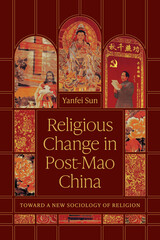 Religious Change in Post-Mao China: Toward a New Sociology of Religion
Yanfei Sun
University of Chicago Press, 2026 A sweeping examination of how the religious landscape has changed in post-Mao China.
In Religious Change in Post-Mao China, sociologist Yanfei Sun examines the transformation of major religions and the broader religious ecology in China in the wake of the death of Mao Zedong. Drawing on two decades of research that integrates ethnographic, historical, and comparative methods, this book explores the remarkable rise of Protestantism, the challenges faced by Catholicism, the revival of Chinese popular religion, the complex dynamics of Chinese Buddhism, and the unrealized potential of new religious movements. Why do some religions thrive and others struggle in post-Mao China? Sun describes both the internal institutional factors that allow some religions to flourish and the wider sociopolitical context that supports or discourages religious expansion. She thereby introduces an ambitious theoretical framework—one whose applicability extends beyond China, offering a template for analyzing religious dynamics in other parts of the world.
A must-read for scholars of religious studies, sociology, and China studies, Religious Change in Post-Mao China not only provides critical insights into China’s evolving religious landscape but also offers a powerful lens for examining the forces behind religious change, both past and present.
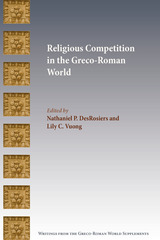 Religious Competition in the Greco-Roman World
Nathaniel P. DesRosiers
SBL Press, 2016 Essays that broaden the historical scope and sharpen the parameters of competitive discourses
Scholars in the fields of late antique Christianity, neoplatonism, New Testament, art history, and rabbinics examine issues related to authority, identity, and change in religious and philosophical traditions of late antiquity. The specific focus of the volume is the examination of cultural producers and their particular viewpoints and agendas in an attempt to shed new light on the religious thinkers, texts, and material remains of late antiquity. The essays explore the major creative movements of the era, examining the strategies used to develop and designate orthodoxies and orthopraxies. This collection of essays reinterprets dialogues between individuals and groups, illuminating the mutual competition and influence among these ancient thinkers and communities.
Features:
- Essays feature competitive discourse as the central organizing theme
- Articles present unique theoretical models that are adaptable to different contexts and highly applicable to religious discourses before and after the Late Antique Period
- Scholars cover a much wider range of traditions including Judaism, Christianity, paganism, and philosophy in order to provide the most complete portrait of the religious landscape
-
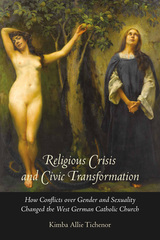 Religious Crisis and Civic Transformation: How Conflicts over Gender and Sexuality Changed the West German Catholic Church
Kimba Allie Tichenor
Brandeis University Press, 2016 This book offers a fresh interpretation of the connection between the West German Catholic Church and post-1950s political debates on women’s reproductive rights and the protection of life in West Germany. According to Tichenor, Catholic women in West Germany, influenced by the culture of consumption, the sexual revolution, Vatican II reforms, and feminism, sought to renegotiate their relationship with the Church. They demanded a more active role in Church ministries and challenged the Church’s hierarchical and gendered view of marriage and condemnation of artificial contraception. When the Church refused to compromise, women left en masse. In response, the Church slowly stitched together a new identity for a postsecular age, employing an elaborate nuptial symbolism to justify its stance on celibacy, women’s ordination, artificial contraception, abortion, and reproductive technologies. Additionally, the Church returned to a radical interventionist agenda that embraced issue-specific alliances with political parties other than the Christian parties. In her conclusion, Tichenor notes more recent setbacks to the German Catholic Church, including disappointment with the reactionary German Pope Benedict XVI and his failure in 2010 to address over 250 allegations of sexual abuse at twenty-two of Germany’s twenty-seven dioceses. How the Church will renew itself in the twenty-first century remains unclear. This closely observed case study, which bridges religious, political, legal, and women’s history, will interest scholars and students of twentieth-century European religious history, modern Germany, and the intersection of Catholic Church practice and women’s issues.
 Religious Education in German Schools: An Historical Approach
Ernst Christian Helmreich
Harvard University Press Religious education in the German school curriculum has been a concern of the churches as well as of the governments of Germany since the Middle Ages. This is a carefully detailed account of religious instruction as it developed historically in the curriculum of German elementary and secondary schools. It emphasizes the relations of church, state, and school; the problem of a confessional or interdenominational basis for public schools; and the training of teachers, the content of the curriculum, and the method of instruction. Although it begins with the early origins of the school, major emphasis is given to the period after 1871. The book concludes with an up-to-date description of the present-day situation in East and West Germany, and in East and West Berlin. German experience with the vexing political and religious problems of religious education in public schools affords interesting comparisons and contrasts to conditions in other countries.
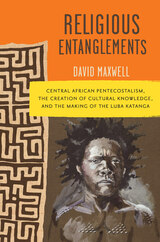 Religious Entanglements: Central African Pentecostalism, the Creation of Cultural Knowledge, and the Making of the Luba Katanga
David Maxwell
University of Wisconsin Press, 2023 Under the leadership of William F. P. Burton and James Salter, the Congo Evangelistic Mission (CEM) grew from a simple faith movement founded in 1915 into one of the most successful classical Pentecostal missions in Africa, today boasting more than one million members in the Democratic Republic of the Congo. Drawing on artifacts, images, documents, and interviews, David Maxwell examines the roles of missionaries and their African collaborators—the Luba-speaking peoples of southeast Katanga—in producing knowledge about Africa.
Through the careful reconstruction of knowledge pathways, Maxwell brings into focus the role of Africans in shaping texts, collections, and images as well as in challenging and adapting Western-imported presuppositions and prejudices. Ultimately, Maxwell illustrates the mutually constitutive nature of discourses of identity in colonial Africa and reveals not only how the Luba shaped missionary research but also how these coproducers of knowledge constructed and critiqued custom and convened new ethnic communities.
Making a significant intervention in the study of both the history of African Christianity and the cultural transformations effected by missionary encounters across the globe, Religious Entanglements excavates the subculture of African Pentecostalism, revealing its potentiality for radical sociocultural change.
 Religious Enthusiasm in the New World: Heresy to Revolution
David S. Lovejoy
Harvard University Press, 1985 In seventeenth- and eighteenth-century England and America, established society branded as "enthusiasts" those unconventional but religiously devout extremists who stepped across orthodox lines and claimed an intimate, emotional relationship with God. John of Leyden, Anne Hutchinson, William Penn, and George Whitefield all shared the label "enthusiast." This book is a study of the enthusiasts who migrated to the American colonies as well as those who emergedthere--from Pilgrim Fathers to pietistic Moravians, from the martyr-bound Quakers to heaven-bent revivalists of the 1740s.
This study of the role of religious enthusiasm in early America tells us much about English attitudes toward religion in the New World and about the vital part it played in the lives of the colonists. Both friends and enemies of enthusiasm revealed in their arguments and actions their own conceptions of the America they inhabited. Was religion in America to be an extension of Old World institutions or truly a product of the New World? Would enthusiasm undermine civilized institutions, not only established churches, but government, social structure, morality, and the economy as well? Calling enthusiasts first heretics, then subversives and conspirators, conventional society sought ways to suppress or banish them. By 1776 enthusiasm had spilled over into politics and added a radical dimension to the revolutionary struggle.
This timely exploration of the effect of radical religion on the course of early American history provides essential historical perspective to the current interest in popular religion.
Religious Experience in the Work of Richard Wagner
Marcel Hebert
Catholic University of America Press, 2015 Philosopher Marcel Hébert developed his Religious Experience in the Work of Richard Wagner (1895) from this background of sustained popular interest in Wagner, an interest that had intensified with the return of his operas to the Paris stage. Newspaper debates about the impact of Wagner's ideas on French society often stressed the links between Wagner and religion. These debates inspired works like Hébert's, intended to explain the complex myth and allegory in Wagner's work and to elucidate it for a new generation of French spectators.
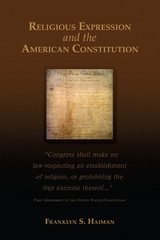 Religious Expression and the American Constitution
Franklyn S. Haiman
Michigan State University Press, 2003 First Amendment rights have been among the most fiercely debated topics in the aftermath of 9/11. In the current environment and fervor for “homeland security,” personal freedoms in exchange for security are coming under more scrutiny. Among these guaranteed freedoms are the protection of religious expression given by the U.S. Constitution and the constitutional prohibitions against behaviors that violate the separation of church and state. The mandate that the government “shall make no law respecting an establishment of religion, or prohibiting the free exercise thereof” is a general principle that has guided American courts in interpreting the original intent of the First Amendment. In Religious Expression and the American Constitution, Haiman focuses on the current state of American law with respect to a broad range of controversial issues affecting religious expression, both verbal and nonverbal, along with a review of the recent history of each issue to provide a full understanding.
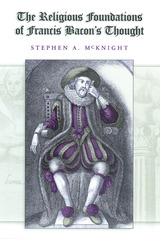 The Religious Foundations of Francis Bacon's Thought
Stephen A. McKnight
University of Missouri Press, 2006
In this important study, Stephen A. McKnight investigates the relation of Francis Bacon’s religious views to his “instauration,” or program for reforming and advancing learning in order to bring “relief to man’s estate.” McKnight provides close textual analyses of eight of Bacon’s texts in order to establish the religious themes and motifs that pervade his writings from 1603 to 1626. Such analysis is necessary because there are so many contradictory interpretations of the same key texts and because prevailing scholarship often ignores Bacon’s religious ideas or dismisses them as part of the cultural images that Bacon supposedly manipulated to conceal or disguise his modern, secular, materialistic, and rationalistic views.
McKnight begins with the New Atlantis because it offers the fullest articulation of Bacon’s vision of instauration and because the principal religious themes in Bacon’s writings are all contained within it. Next, he turns to The Great Instauration and The New Organon to show the centrality of religious concepts in two of Bacon’s major philosophical works. He then examines five of Bacon’s early published and unpublished works, including The Advancement of Learning and Wisdom of the Ancients, to demonstrate that religious imagery and biblical themes permeate Bacon’s program of reform from the outset.
McKnight maintains that Bacon’s vision of reform is drawn from the Judeo-Christian Scriptures, particularly the Genesis account of the Creation and the Fall; from apocalyptic expectation of renewal in the Old Testament; and from salvation themes of the New Testament. He also demonstrates that Bacon’s Christian ideas are augmented and transmuted by related themes and imagery found in the prisca theologia, a mixture of Neoplatonism, Hermeticism, alchemy, magic, and Jewish esoteric traditions. According to McKnight, Bacon believed that scholastic error and ecclesiastical dogma obscured religious truth and required a search for a truer, deeper level of understanding of the Scriptures and of God’s saving acts in history.
The Religious Foundations of Francis Bacon’s Thought attempts to correct the persistent misconception of Bacon as a secular modern who dismissed religion in order to promote the human advancement of knowledge. This exploration suggests that the origins of modernity are much more complex than many current approaches allow and that modernity and the goals of science cannot be separated from the dream of a restoration of a prelapsarian relation of humanity, God, and nature.
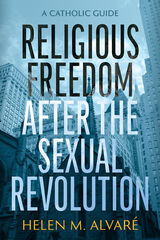 Religious Freedom after the Sexual Revolution: A Catholic Guide
Helen Alvare
Catholic University of America Press, 2022 Laws mandating cooperation with the state’s new sexual orthodoxy are among the leading contemporary threats to the religious freedom of Catholic institutions in the United States. These demand that Catholic schools, health-care providers, or social services cooperate with contraception, cohabitation, abortion, same-sex marriage, or transgender identity and surgeries.
But Catholic institutions’ responses seem thin and uninspiring to many. They are criticized as legalistic, authoritarian, bureaucratic, retrograde and hurtful to women and to persons who identify as LGBTQ. They are even called “un-Christian.” They invite disrespect both for Catholic sexual responsibility norms and for religious freedom generally, not only among lawmakers and judges, but also in the court of public opinion, which includes skeptical Catholics.
The U.S. Constitution protects Catholic institutions’ “autonomy” – their authority over faith and doctrine, internal operations, and the personnel involved in personifying and transmitting the faith. Other constitutional and statutory provisions also safeguard religious freedom, if not always perfectly. Catholic institutions could take far better advantage of all of these existing protections if they communicated, first, how they differ from secular institutions: how their missions emerge from their faith in Jesus Christ, and their efforts both to make his presence felt in the world today, and to display the inbreaking of the Kingdom of God. Second, they need to draw out the link between their teachings on sexual responsibility and love of God and neighbor.
Drawing upon Scripture, tradition, history, theology and empirical evidence, Helen Alvaré frames a more complete, inspiring and appealing response to current laws’ attempts to impose a new sexual orthodoxy upon Catholic institutions. It clarifies the “ecclesial” nature of Catholic schools, hospitals and social services. It summarizes the empirical evidence supporting the link between personnel decisions and mission, and between Catholic sexual responsibility norms and human flourishing. It grounds Catholic sexual responsibility teachings in the same love of God and neighbor that animate the existence, operations, and services of Catholic institutions.
 Religious Freedom and the Constitution
Christopher L. Eisgruber and Lawrence G. Sager
Harvard University Press, 2010 Religion has become a charged token in a politics of division. In disputes about faith-based social services, public money for religious schools, the Pledge of Allegiance, Ten Commandments monuments, the theory of evolution, and many other topics, angry contestation threatens to displace America's historic commitment to religious freedom. Part of the problem, the authors argue, is that constitutional analysis of religious freedom has been hobbled by the idea of "a wall of separation" between church and state. That metaphor has been understood to demand that religion be treated far better than other concerns in some contexts, and far worse in others. Sometimes it seems to insist on both contrary forms of treatment simultaneously. Missing has been concern for the fair and equal treatment of religion. In response, the authors offer an understanding of religious freedom called Equal Liberty.
Equal Liberty is guided by two principles. First, no one within the reach of the Constitution ought to be devalued on account of the spiritual foundation of their commitments. Second, all persons should enjoy broad rights of free speech, personal autonomy, associative freedom, and private property. Together, these principles are generous and fair to a wide range of religious beliefs and practices.
With Equal Liberty as their guide, the authors offer practical, moderate, and appealing terms for the settlement of many hot-button issues that have plunged religious freedom into controversy. Their book calls Americans back to the project of finding fair terms of cooperation for a religiously diverse people, and it offers a valuable set of tools for working toward that end.
 Religious Freedom in an Egalitarian Age
Nelson Tebbe
Harvard University Press, 2017 Tensions between religious freedom and equality law are newly strained in America. As lawmakers work to protect LGBT citizens and women seeking reproductive freedom, religious traditionalists assert their right to dissent from what they see as a new liberal orthodoxy. Some religious advocates are going further and expressing skepticism that egalitarianism can be defended with reasons at all. Legal experts have not offered a satisfying response—until now.
Nelson Tebbe argues that these disputes, which are admittedly complex, nevertheless can be resolved without irrationality or arbitrariness. In Religious Freedom in an Egalitarian Age, he advances a method called social coherence, based on the way that people reason through moral problems in everyday life. Social coherence provides a way to reach justified conclusions in constitutional law, even in situations that pit multiple values against each other. Tebbe contends that reasons must play a role in the resolution of these conflicts, alongside interests and ideologies. Otherwise, the health of democratic constitutionalism could suffer.
Applying this method to a range of real-world cases, Tebbe offers a set of powerful principles for mediating between religion and equality law, and he shows how they can lead to workable solutions in areas ranging from employment discrimination and public accommodations to government officials and public funding. While social coherence does not guarantee outcomes that will please the liberal Left, it does point the way toward reasoned, nonarbitrary solutions to the current impasse.
Religious Freedom in Modern Russia
Randall A. Poole & Paul W. Werth
University of Pittsburgh Press, 2018 Despite Russia’s religiously diverse population and the strong connection between the Russian state and the Orthodox Church, the problem of religious freedom has been a driving force in the country’s history. This volume gathers leading scholars to provide an extensive exploration of the evolution, experience, and contested meanings of religious freedom in Russia from the early modern period to the present, with a particular focus on the nineteenth century. Addressing different spiritual traditions, clerics and revolutionaries, ideas and lived experience, Religious Freedom in Modern Russia explores the various meanings that religious freedom, toleration, and freedom of conscience had in Russia among nonstate actors.
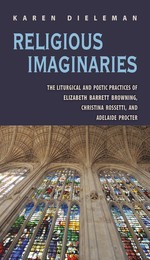 Religious Imaginaries: The Liturgical and Poetic Practices of Elizabeth Barrett Browning, Christina Rossetti, and Adelaide Procter
Karen Dieleman
Ohio University Press, 2012 Explores liturgical practice as formative for how three Victorian women poets imagined the world and their place in it and, consequently, for how they developed their creative and critical religious poetics. This new study rethinks several assumptions in the field: that Victorian women’s faith commitments tended to limit creativity; that the contours of church experiences matter little for understanding religious poetry; and that gender is more significant than liturgy in shaping women’s religious poetry.
Exploring the import of bodily experience for spiritual, emotional, and cognitive forms of knowing, Karen Dieleman explains and clarifies the deep orientations of different strands of nineteenth-century Christianity, such as Congregationalism’s high regard for verbal proclamation, Anglicanism’s and Anglo-Catholicism’s valuation of manifestation, and revivalist Roman Catholicism’s recuperation of an affective aesthetic. Looking specifically at Elizabeth Barrett Browning, Christina Rossetti, and Adelaide Procter as astute participants in their chosen strands of Christianity, Dieleman reveals the subtle textures of these women’s religious poetry: the different voices, genres, and aesthetics they create in response to their worship experiences. Part recuperation, part reinterpretation, Dieleman’s readings highlight each poet’s innovative religious poetics.
Dieleman devotes two chapters to each of the three poets: the first chapter in each pair delineates the poet’s denominational practices and commitments; the second reads the corresponding poetry. Religious Imaginaries has appeal for scholars of Victorian literary criticism and scholars of Victorian religion, supporting its theoretical paradigm by digging deeply into primary sources associated with the actual churches in which the poets worshipped, detailing not only the liturgical practices but also the architectural environments that influenced the worshipper’s formation. By going far beyond descriptions of various doctrinal positions, this research significantly deepens our critical understanding of Victorian Christianity and the culture it influenced.
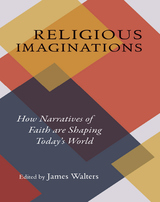 Religious Imaginations: How Narratives of Faith are Shaping Today’s World
Edited by James Walters
Gingko, 2018 Market globalization, technology, climate change, and postcolonial political forces are together forging a new, more modern world. However, caught up in the mix are some powerful religious narratives that are galvanizing peoples and reimagining – and sometimes stifling – the political and social order. Some are repressive, fundamentalist imaginations, such as the so-called Islamic Caliphate. Others could be described as post-religious, such as the evolution of universal human rights out of the European Christian tradition. But the question of the compatibility of these religious worldviews, particularly those that have emerged out of the Abrahamic faith traditions, is perhaps the most pressing issue in global stability today. What scope for dialogue is there between the Jewish, Muslim, and Christian ways of imagining the future? How can we engage with these multiple imaginations to create a shared and peaceful global society? Religious Imaginations is an interdisciplinary volume of both new and well-known scholars exploring how religious narratives interact with the contemporary geopolitical climate.
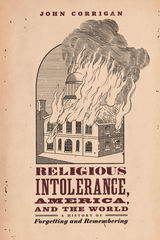 Religious Intolerance, America, and the World: A History of Forgetting and Remembering
John Corrigan
University of Chicago Press, 2020 As the news shows us every day, contemporary American culture and politics are rife with people who demonize their enemies by projecting their own failings and flaws onto them. But this is no recent development. Rather, as John Corrigan argues here, it’s an expression of a trauma endemic to America’s history, particularly involving our long domestic record of religious conflict and violence.
Religious Intolerance, America, and the World spans from Christian colonists’ intolerance of Native Americans and the role of religion in the new republic’s foreign-policy crises to Cold War witch hunts and the persecution complexes that entangle Christians and Muslims today. Corrigan reveals how US churches and institutions have continuously campaigned against intolerance overseas even as they’ve abetted or performed it at home. This selective condemnation of intolerance, he shows, created a legacy of foreign policy interventions promoting religious freedom and human rights that was not reflected within America’s own borders. This timely, captivating book forces America to confront its claims of exceptionalism based on religious liberty—and perhaps begin to break the grotesque cycle of projection and oppression.
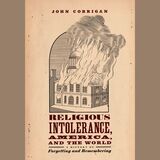 Religious Intolerance, America, and the World: A History of Forgetting and Remembering
John Corrigan
University of Chicago Press, 2020 This is an auto-narrated audiobook edition of this book. As the news shows us every day, contemporary American culture and politics are rife with people who demonize their enemies by projecting their own failings and flaws onto them. But this is no recent development. Rather, as John Corrigan argues here, it’s an expression of a trauma endemic to America’s history, particularly involving our long domestic record of religious conflict and violence.
Religious Intolerance, America, and the World spans from Christian colonists’ intolerance of Native Americans and the role of religion in the new republic’s foreign-policy crises to Cold War witch hunts and the persecution complexes that entangle Christians and Muslims today. Corrigan reveals how US churches and institutions have continuously campaigned against intolerance overseas even as they’ve abetted or performed it at home. This selective condemnation of intolerance, he shows, created a legacy of foreign policy interventions promoting religious freedom and human rights that was not reflected within America’s own borders. This timely, captivating book forces America to confront its claims of exceptionalism based on religious liberty—and perhaps begin to break the grotesque cycle of projection and oppression.
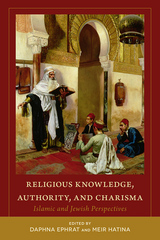 Religious Knowledge, Authority, and Charisma: Islamic and Jewish Perspectives
Daphna Ephrat
University of Utah Press, 2014 Utah Series in Middle East Studies
The issue of religious authority has long fascinated and ignited scholars across a range of disciplines: history, anthropology, the sociology of religion, and political science. Religious Knowledge, Authority, and Charisma juxtaposes religious leadership in premodern and modern Islam with examples from the Judaic tradition. By illustrating various iterations of authority in numerous historical and cultural contexts, this volume offers fresh insights into the nature of institutions of learning and other systems of establishing and disseminating authority, the mechanisms for cultivating committed adherents, and the processes by which religious leadership is polarized and fragmented.
Contributors tease out the sources and types of authority that emerged out of the Sunni and Shi'i milieu and the evolution of Muslim elites who served as formulators and disseminators of knowledge and practice. Comparative insights are provided by the examination of ideological and historical developments among Jewish sages who inculcated similar modes of authority from within their traditions. The rigorous exploration of the dynamic interface of knowledge and power in Islam and Judaism serves to highlight a number of present tensions common to both religions. By intertwining a historical span that traces trajectories of continuity and change, integrative discussion of cross-sectional themes, and comparative perspectives, this volume makes a distinct contribution.
 Religious Landscapes in Contemporary Spain: The Impact of Secularization on Religious Pluralism
Edited by Julio de la Cueva, Ana I. Planet Contreras, and Miguel Hernando de Larramendi
Sussex Academic Press, 2023 A historically informed and nuanced look at the growing religious diversity of contemporary Spain.
Contemporary Spain is no longer exclusively identified with Catholicism. This book sets out to understand the social dynamics of twenty-first-century Spain through the perspective of religion and religious pluralism in the country, addressing both the recent history and contemporary landscape of secularism, Christianity, and Islam in Spain.
The book is divided into three parts. The first part analyzes Spanish secularization during the twentieth and twenty-first centuries. It pays particular attention to the process of secularization during the Second Republic and to the “quiet” secularization of society that began under Franco’s regime. The second part addresses changes that have taken place within Catholicism and the reaction of the Protestant minority to increasingly rapid shifts in social mores. The final part addresses questions such as the history of Islam in Spain’s colonial management, how Islam is viewed by other religions, the impact of the March 11, 2004 attacks, and Islamophobic discourse in Spain. Religious Landscapes in Contemporary Spain is essential reading for scholars and students in history and contemporary affairs.
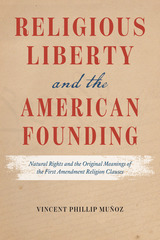 Religious Liberty and the American Founding: Natural Rights and the Original Meanings of the First Amendment Religion Clauses
Vincent Phillip Muñoz
University of Chicago Press, 2022 An insightful rethinking of the meaning of the First Amendment’s protection of religious freedom.
The Founders understood religious liberty to be an inalienable natural right. Vincent Phillip Muñoz explains what this means for church-state constitutional law, uncovering what we can and cannot determine about the original meanings of the First Amendment’s Religion Clauses and constructing a natural rights jurisprudence of religious liberty.
Drawing on early state constitutions, declarations of religious freedom, Founding-era debates, and the First Amendment’s drafting record, Muñoz demonstrates that adherence to the Founders’ political philosophy would lead neither to consistently conservative nor consistently liberal results. Rather, adopting the Founders’ understanding would lead to a minimalist church-state jurisprudence that, in most cases, would return authority from the judiciary to the American people. Thorough and convincing, Religious Liberty and the American Founding is key reading for those seeking to understand the Founders’ political philosophy of religious freedom and the First Amendment Religion Clauses.
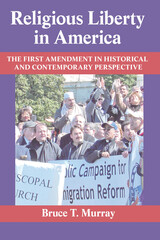 Religious Liberty in America: The First Amendment in Historical and Contemporary Perspective
Bruce T. Murray
University of Massachusetts Press, 2008 A nation founded on church-state separation is still debating where the line is drawn
In recent years a series of highly publicized controversies has focused attention on what are arguably the sixteen most important words in the U.S. Constitution: "Congress shall make no law respecting an establishment of religion, or prohibiting the free exercise thereof." The ongoing court battles over the inclusion of the words "under God" in the Pledge of Allegiance, the now annual cultural quarrel over "Merry Christmas" vs. "Happy Holidays," and the political promotion of "faith-based initiatives" to address social problems—all reflect competing views of the meaning of the religious liberty clauses of the First Amendment.
Such disputes, as Bruce T. Murray shows, are nothing new. For more than two hundred years Americans have disagreed about the proper role of religion in public life and where to draw the line between church and state. In this book, he reexamines these debates and distills the volumes of commentary and case law they have generated. He analyzes not only the changing contours of religious freedom but also the phenomenon of American civil religion, grounded in the notion that the nation's purpose is sanctified by a higher authority—an idea that can be traced back to the earliest New England colonists and remains deeply ingrained in the American psyche.
Throughout the book, Murray connects past and present, tracing the historical roots of contemporary controversies. He considers why it is that a country founded on the separation of church and state remains singularly religious among nations, and concludes by showing how the Supreme Court's thinking about the religious liberty clauses has evolved since the late eighteenth century.
Religious Materiality in the Early Modern World
Suzanna Ivanic
Amsterdam University Press, 2020 This collection of essays offers a comparative perspective on religious materiality across the early modern world. Setting out from the premise that artefacts can provide material evidence of the nature of early modern religious practices and beliefs, the volume tests and challenges conventional narratives of change based on textual sources. Religious Materiality in the Early Modern World brings together scholars of Catholic, Protestant, Jewish, Islamic and Buddhist practices from a range of fields, including history, art history, museum curatorship and social anthropology. The result is an unprecedented account of the wealth and diversity of devotional objects and environments, with a strong emphasis on cultural encounters, connections and exchanges.
 Religious Movements in the Middle Ages
Herbert Grundmann
University of Notre Dame Press, 1995
Medievalists, historians, and women's studies specialists will welcome this translation of Herbert Grundmann's classic study of religious movements in the Middle Ages because it provides a much-needed history of medieval religious life--one that lies between the extremes of doctrinal classification and materialistic analysis--and because it represents the first major effort to underline the importance of women in the development of the language and practice of religion in the Middle Ages.
Religious Movements in the Middle Ages describes a lay religious movement of the eleventh and twelfth centuries that emphasized the centrality of lifestyle rather than doctrine. The religious groups that developed and solidified out of this movement were considered heterodox by some standards, orthodox by others. However, despite initial condemnation, these groups, among them any women's groups, were given permissive rules to suit their peculiarities. Grundmann explicates the doctrines that lay behind these religious movements and captures the material contexts that fostered them. Most importantly, he is able to recapture the dynamism of the groups themselves and to identify the historically contingent events that carried them along their various paths. Perhaps the greatest synthetic daring of Grundmann's study is his emphasis on the common point of departure shared by the religious groups that were ultimately to become located on either side of orthodoxy as defined by the pope. Prior to Grundmann's study, scholars had only discussed either high medieval heresy or new orders within the Church, but never, as Grundmann does here, the common inspiration that lay behind both. Thus, this enduring study has become the foundation for the historical study of medieval religious life, and scholars agree that it remains as challenging and exciting s it was when originally published in 1935.
 Religious Objects as Psychological Structures
Moshe Halevi Spero
University of Chicago Press, 1992 In this original work, Moshe Halevi Spero makes a two-pronged effort to integrate the psychological and religious perspectives of contemporary psychoanalytic object relations theory with the system of Jewish ethics known as Halakhah. Religious Objects as Psychological Structures represents the first comprehensive theoretical and clinical integration of psychology and Judaism within the larger understanding of the religious nature of psychotherapy and the psychotherapeutic nature of religion.
By constructing a halakhic metapsychology within which psychological phenomena can be given specific halakhic identities, Spero arrives at a unique perspective on the development of religious objects and God representations. He traces two lines of development: one for relationships between humans, anthropocentric, and another for relationships between God and humans, deocentric. The second aspect of his argument is that these two distinct but parallel lines allow one to conceptualize the revolutionary possibility of transference displacements—the shift of religious symbology—not only from interpersonal relationships onto the God concept (Freud's model) but also from an objective human-God relationship onto interpersonal relationships. Filled with clinical as well as theoretical illustrations, Spero's work is a rich resource for both the religious patient and the religious therapist.
In the last few decades, a great deal of literature has been written on the relationship between theology and psychotherapy; none of this work, however, has addressed its subject using Judaism as a point of reference. Spero successfully takes up the task of bridging this gap in previous scholarship.
Religious Philosophy: A Group of Essays
Harry Austryn Wolfson
Harvard University Press As Harry Austryn Wolfson deftly isolates and analyzes some of the most vital and often the most enigmatic ideas developed by the religious philosophers of the West, a cumulative and thoughtful continuity emerges from his interpretations. Philo, for example, appears as a dominant force throughout the sixteen centuries that preceded Spinoza's critique of his basic principles.
The ten essays which constitute the critical sequence of this penetrating book are derived from lectures, and from separate publications many of which are not readily available now. They include discussions of Immortality and Resurrection in the Philosophy of the Church Fathers; St. Augustine and the Pelagian Controversy; Causality and Freedom in Descartes, Leibniz and Hume. Wolfson concludes with a perceptive distillation of his personal wisdom in an essay contrasting the professed atheist with the “verbal theist.”
Religious Pluralism and the Nigerian State: Mis Af#66
Simeon O. Ilesanmi
Ohio University Press, 1996 In the case of Nigeria, scholarship on religious politics has not adequately taken into account the pluralistic context and the idealistic pretensions of the state that inhibit the possibility of forging an enduring civic amity among Nigeria’s diverse groups. Ilesanmi proposes a new philosophy or model of religio-political interaction, which he calls dialogic politics. Dialogic politics celebrates pluralism and suggests that religious institutions he construed as mediating structures functioning as buffers between individual citizens in search of existential meaning and cultural identity and the impersonal state, which tends to gravitate toward instrumental objectives. Ilesanmi’s study offers a fresh perspective on the complex relations between political attitudes and religious convictions.
 Religious Pluralism, Democracy, and the Catholic Church in Latin America
Frances Hagopian
University of Notre Dame Press, 2009
The Roman Catholic Church in Latin America faces significant and unprecedented challenges. Most prominent among them are secularization, globalizing cultural trends, intensifying religious competition, and pluralism of many kinds within what were once hegemonic Catholic societies. The substantial and original essays in this volume assess the ways in which the Catholic Church in Latin America is dealing with these political, religious, and social changes. Most importantly, they explore how democracy has changed the Catholic Church and, in turn, how religious changes have influenced democratic politics in Latin America.
Drawing on the experiences of several countries to illustrate broad themes and explain divergent religious responses to common challenges, the contributors advance the notion that the Catholic Church's effectiveness in the public sphere and even its long-term viability as a religious institution depend on the nature and extent of the relationship between the hierarchy and the faithful. The essays address the context of pluralist challenges, the ideational, institutional, and policy responses of the Catholic hierarchy, and the nature of both religious beliefs and democratic values at the individual level in Latin America today.
“Religious Pluralism, Democracy, and the Catholic Church in Latin America is a much needed volume. The book is highly original, relevant, and will stimulate new research on religion in Latin America.” —Kenneth Serbin, University of San Diego
“Religion and politics, two of the great topics of all time, stir intense passions and often deep conflicts—they have done so in Latin America's history. Hagopian's book thoughtfully examines religious pluralism in Latin America and its impact on politics and society, with special attention to cultural change, gender, the family, education, and beliefs about justice and morality as they bear on democracy. Hagopian's own three chapters frame the book and make it a cohesive and thought-provoking intellectual project.” —Jorge I. Domínguez, Harvard University
“This book makes an original contribution to our understanding of the challenges facing the Catholic Church in Latin America in the wake of democratic transitions and increasing religious pluralism. It also provides important insights into how church leaders are responding to these challenges in a number of key countries.” —Philip Williams, University of Florida
 Religious Politics in Latin America, Pentecostal vs. Catholic
Brian H. Smith
University of Notre Dame Press, 1998 Brian H. Smith's book surveys recent religious and political developments in Latin American Christianity, especially in the rapidly growing Pentecostal churches and in Catholicism. He finds that despite efforts by the Vatican to make the Latin American Church less involved in politics (in the wake of liberation theology) by the papal appointment of a whole new generation of conservative bishops since 1980, Catholicism is still very much a political force throughout the region.
Catholic bishops, in spite of their conservative religious ideology, have felt obligated to preach the social doctrine of the Church and have vigorously denounced new economic models for enriching a minority of the population at the cost of the majority who are poor. Bishops also have denounced corruption in governments that has grown to epidemic proportions in recent years, and have strongly opposed legislative proposals that are anti-Catholic. Regardless of these efforts by Catholic prelates to maintain government support for the Church's institutions and its traditional moral concerns in law, Protestantism—especially in Pentecostal denominations among low-income sectors—has grown at a significant rate in the past twenty years.
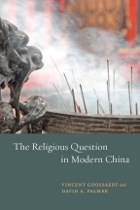 The Religious Question in Modern China
Vincent Goossaert and David A. Palmer
University of Chicago Press, 2011 Recent events—from strife in Tibet and the rapid growth of Christianity in China to the spectacular expansion of Chinese Buddhist organizations around the globe—vividly demonstrate that one cannot understand the modern Chinese world without attending closely to the question of religion. The Religious Question in Modern China highlights parallels and contrasts between historical events, political regimes, and cultural movements to explore how religion has challenged and responded to secular Chinese modernity, from 1898 to the present. Vincent Goossaert and David A. Palmer piece together the puzzle of religion in China not by looking separately at different religions in different contexts, but by writing a unified story of how religion has shaped, and in turn been shaped by, modern Chinese society. From Chinese medicine and the martial arts to communal temple cults and revivalist redemptive societies, the authors demonstrate that from the nineteenth century onward, as the Chinese state shifted, the religious landscape consistently resurfaced in a bewildering variety of old and new forms. The Religious Question in Modern China integrates historical, anthropological, and sociological perspectives in a comprehensive overview of China’s religious history that is certain to become an indispensible reference for specialists and students alike.
 Religious Responses to Violence: Human Rights in Latin America Past and Present
Alexander Wilde
University of Notre Dame Press, 2015 During the past half century, Latin America has evolved from a region of political instability and frequent dictatorships into one of elected governments. Although its societies and economies have undergone sweeping changes, high levels of violence have remained a persistent problem. Religious Responses to Violence: Human Rights in Latin America Past and Present offers rich resources to understand how religion has perceived and addressed different forms of violence, from the political and state violence of the 1970s and 1980s to the drug traffickers and youth gangs of today. The contributors offer many fresh insights into contemporary criminal violence and reconsider past interpretations of political violence, liberation theology, and human rights in light of new questions and evidence.
In contrast to many other studies of violence, this book explores its moral dimensions—up close in lived experience—and the real consequences of human agency. Alexander Wilde provides a thoughtful substantive introduction, followed by thematic chapters on "rights," "violence," and case studies of ten countries throughout the region. The book breaks new ground examining common responses as well as differences between Catholic and Evangelical pastoral accompaniment. These new studies focus on the specifically religious character of their responses—how they relate their mission and faith to violence in different contexts—to better understand how and why they have taken action.
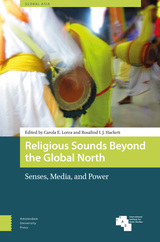 Religious Sounds Beyond the Global North: Senses, Media and Power
Carola Lorea
Amsterdam University Press, 2024 What makes sounds “religious”? How are communities shaped by the things they hear, play, or listen to? This book foregrounds connections between sounds, bodies, and media in the private and public life of communities beyond the Global North, analyzing diverse configurations of the category of sound and various sonic ontologies to usher in a more inclusive global anthro-history of religious sounds.
This edited volume implements a “sonic turn” in the study of religion by engaging with a diversity of auditory, musical, and embodied practices. Dislodging the Global North as the main point of reference for studies on religious sound, this volume proposes an acoustemology of the post-secular with an emphasis on Asia as method. Unsettling and expanding existing discussions on senses, media, and power, editors Carola E. Lorea and Rosalind I. J. Hackett present religious sounds as co-creating subjectivities and collectivities that coalesce around audible aesthetic formations. This volume demonstrates that religious sounds are not only produced by certain religious traditions but also produce communities, shaping the self and sensitivity of those who participate.
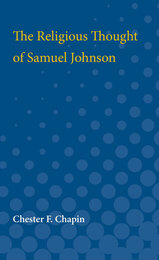 The Religious Thought of Samuel Johnson
Chester F. Chapin
University of Michigan Press, 1968 Starting from the youthful influences that helped to form Samuel Johnson's mature religious thought, Chester F. Chapin goes on to consider the development of this thought and its relation to Anglican orthodoxy and to social and political questions.The second and major part of the book is devoted to an analysis of Johnson's mature position on certain basic issues. Chapin considers Johnson's attitude toward evidences, arguing that Johnson attempted to establish revelation by grounding it in history. He maintains that Johnson did not distinguish between Christian and non-Christian ethics, and that it was the eschatology of Christianity that he valued particularly. The intensity of Johnson's fear of death and judgment is a measure of the intensity of his faith. Chapin considers problems of evil, of free will, and of foreknowledge and necessity as Johnson struggled with them. Writers that Johnson referred to argued that foreknowledge does not imply necessity, but Chapin maintains that Johnson was not convinced by these arguments. Experience, Johnson saw, was on the side of free will, and for him this took precedence over theory.The author then turns to Johnson's social and political attitudes. His loyalty to the Church shaped other conservative attitudes. Johnson did not assert that the ultimate conversion of all men to Christianity was part of God's plan, and his attitude toward the non-Christian world approached that of live and let live. Johnson was not a relativist. Since men have the ability to distinguish good from evil, it follows that there is an objective moral order in the world.Finally, Chapin reviews the problem of human life, which so occupied Johnson's mind, and states that for Johnson religion was the only rational solution to this problem.Chapin also presents the position of Hume and other 18th-century intellectuals and provides a carefully reasoned argument concerning various questions of theology.
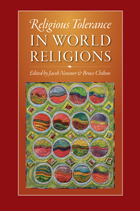 Religious Tolerance in World Religions
Jacob Neusner
Templeton Press, 2008
Today, and historically, religions often seem to be intolerant, narrow-minded, and zealous. But the record is not so one-sided. In Religious Tolerance in World Religions, numerous scholars offer perspectives on the "what" and "why" traditions of tolerance in world religions, beginning with the pre-Christian West, Greco-Roman paganism, and ancient Israelite Monotheism and moving into modern religions such as Christianity, Judaism, Islam, Buddhism, and Hinduism. By tolerance the authors mean "the capacity to live with religious difference, and by toleration, the theory that permits a majority religion to accommodate the presence of a minority religion."
The volume is introduced with a summary of a recent survey that sought to identify the capacity of religions to tolerate one another in theory and in practice. Eleven religious communities in seven nations were polled on questions that ranged from equality of religious practitioners to consequences of disobedience. The essays frame the provocative analysis of how a religious system in its political statement produces categories of tolerance that can be explained in that system’s logical context. Past and present beliefs, practices, and definitions of social order are examined in terms of how they support tolerance for other religious groups as a matter of public policy.
Religious Tolerance in World Religions focuses attention on the attitude "that the ’infidel’ or non-believer may be accorded an honorable position within the social order defined by Islam or Christianity or Judaism or Buddhism or Hinduism, and so on." It is a timely reference for colleges and universities and for makers of public policy.
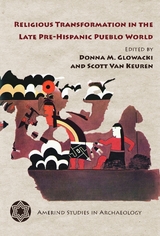 Religious Transformation in the Late Pre-Hispanic Pueblo World
Edited by Donna M. Glowacki and Scott Van Keuren
University of Arizona Press, 2012 The mid-thirteenth century AD marks the beginning of tremendous social change among Ancestral Pueblo peoples of the northern US Southwest that foreshadow the emergence of the modern Pueblo world. Regional depopulations, long-distance migrations, and widespread resettlement into large plaza-oriented villages forever altered community life. Archaeologists have tended to view these historical events as adaptive responses to climatic, environmental, and economic conditions. Recently, however, more attention is being given to the central role of religion during these transformative periods, and to how archaeological remains embody the complex social practices through which Ancestral Pueblo understandings of sacred concepts were expressed and transformed.
The contributors to this volume employ a wide range of archaeological evidence to examine the origin and development of religious ideologies and the ways they shaped Pueblo societies across the Southwest in the centuries prior to European contact. With its fresh theoretical approach, it contributes to a better understanding of both the Pueblo past and the anthropological study of religion in ancient contexts This volume will be of interest to both regional specialists and to scholars who work with the broader dimensions of religion and ritual in the human experience.
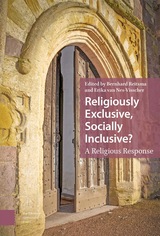 Religiously Exclusive, Socially Inclusive: A Religious Response
Bernhard Reitsma
Amsterdam University Press, 2023 Is it possible to be religiously exclusive and socially inclusive? How do we deal with those outside of our own religious community who have completely different and sometimes conflicting views on what should be considered true and right behaviour? What if a religious tradition orders the expulsion or killing of those who leave the faith community and adopt another worldview? This book focuses on biblical texts concerning exclusivity and apostasy, studying different interpretations of such texts. It starts with the Jewish and Christian tradition of the Hebrew Bible, continues with texts from the New Testament, and explores diverse social studies to find ways of understanding the relationship between exclusion and inclusion today. Part of this exploration is the interaction with Jewish and Islamic voices. The collection ends with a systematic and missiological reflection on the issues Christian churches and other religious communities must address today.
Reliquary
Abigail Wender
Four Way Books, 2021 An introspective lyric on how the opiate crisis alters families and futures
In her debut collection, Reliquary, Abigail Wender addresses losing a brother to prison and, ultimately, opiate addiction. The text also considers womanhood, motherhood, and marriage in lyric poems that confront the complicated nature of grief, the effects of illness on family, and how love—even bliss—figure into grief’s equation. The collection suspends time, as the speaker weaves between flashbacks and the present, assembling fragments and vignettes of her childhood and marriage. In the book’s moments of solace and interiority, such as in the poem, “Hiking,” Wender contemplates how to hold on and to what. In this particular poem’s reflection on forgiveness, the speaker asks “Are there words for us, / high on an uppermost branch?,” and the collection responds with a resounding yes.
 Reliving Golgotha: The Passion Play of Iztapalapa
Richard C. Trexler
Harvard University Press, 2003 In Reliving Golgotha, Richard Trexler brings an important new perspective to religious spectacle in an engrossing exploration of the annual passion play at Iztapalapa, the largest and poorest borough of Mexico City.
After tracing the history of European passion theater, Trexler examines the process by which representations of the passion were established in the Americas, especially in New Spain. Indeed, the Iztapalapan pageant can only be understood in the full historical context of Mexican church and state relations. Originally, this passion was a quintessential means by which the increasingly marginalized indigenous population marked its own culture from the mestizo ruling class. Early twentieth-century reenactments offered a tenaciously traditional spectacle, featuring Nahuatl-speaking actors, for a local audience who embraced it as a living protest against the pervasive power of the Church. A century later, political disorder and a suspicious church hierarchy often forced the suspension of the play in the aftermath of the Revolution. But by the middle of the century, political and religious authorities encouraged its development as a tourist event, and changes wrought by media coverage and the impact of government funding have further fractured the play's local identity.
In addition to offering valuable insights into the political, social, and psychological meanings of religious spectacle, Trexler illuminates the strong cultural forces that have helped provide a voice for some of Mexican society's most powerless members.
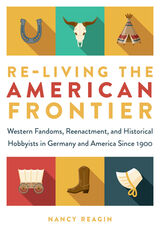 Re-living the American Frontier: Western Fandoms, Reenactment, and Historical Hobbyists in Germany and America Since 1900
Nancy Reagin
University of Iowa Press, 2021 The historic and mythic elements of the American Old West—covered wagon trains, herds of buffalo, teepee villages, Indigenous warriors on horseback, cowboys on open ranges, and white settlers “taming” a wilderness with their plows and log cabins—have exerted a global fascination for more than 200 years and became the foundation for fan communities who have endured for generations. This book examines some of those communities, particularly German fans inspired by the authors of Westerns such as Karl May, and American enthusiasts of Laura Ingalls Wilder’s Little House on the Prairie series.
But the Old West (like all visions of the past) proved to be shifting cultural terrain. In both Germany and the U. S., Western narratives of white settlement were once seen as “apolitical” and were widely accepted by white people. But during the Nazi period in Germany and in East Germany after 1945, the American West was reevaluated and politically repurposed. Then, during the late twentieth century, understandings of the West changed in the U. S. as well, while the violence of white settler colonialism and the displacement of Indigenous peoples became a flashpoint in the culture wars between right and left. Reagin shows that the past that fans seek to recreate is shaped by the changing present, as each new generation adapts and relives their own West.
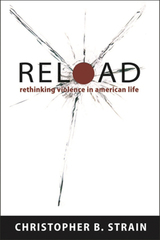 Reload: Rethinking Violence in American Life
Christopher B. Strain
Vanderbilt University Press, 2011 A Choice Outstanding Academic Title of 2011
When incidents of extreme violence flare in America, all too often they are framed as isolated aberrations. Nothing could be further from the truth, as Christopher Strain argues in his new book, Reload: Rethinking Violence in American Life. The unpleasant fact, as he reveals in this highly readable study, is that American violence is inextricably woven into the fabric of our national heritage and experience.
In Reload, Strain traces our modern-day conception of violence from the struggle to survive on the American frontier, through evolving gender roles in recent centuries, to the hysteria surrounding video and role-playing games and the more recent disturbing phenomenon of school shootings. Strain shapes nothing less than a profound meditation on American violence and a "primer" on understanding what can often appear to be a profoundly dangerous nation.
In addition to serving as a comprehensive overview of the state of violence in America, Reload also suggests ways of combating the trends that lead to tragedy.
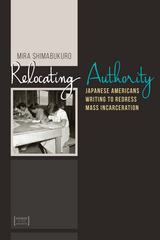 Relocating Authority: Japanese Americans Writing to Redress Mass Incarceration
Mira Shimabukuro
University Press of Colorado, 2015 Relocating Authority examines the ways Japanese Americans have continually used writing to respond to the circumstances of their community’s mass imprisonment during World War II. Using both Nikkei cultural frameworks and community-specific history for methodological inspiration and guidance, Mira Shimabukuro shows how writing was used privately and publicly to individually survive and collectively resist the conditions of incarceration. Examining a wide range of diverse texts and literacy practices such as diary entries, note-taking, manifestos, and multiple drafts of single documents, Relocating Authority draws upon community archives, visual histories, and Asian American history and theory to reveal the ways writing has served as a critical tool for incarcerees and their descendants. Incarcerees not only used writing to redress the “internment” in the moment but also created pieces of text that enabled and inspired further redress long after the camps had closed. Relocating Authority highlights literacy’s enduring potential to participate in social change and assist an imprisoned people in relocating authority away from their captors and back to their community and themselves. It will be of great interest to students and scholars of ethnic and Asian American rhetorics, American studies, and anyone interested in the relationship between literacy and social justice.
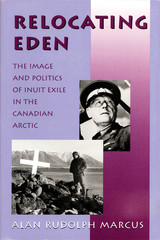 Relocating Eden: The Image and Politics of Inuit Exile in the Canadian Arctic
Alan Rudolph Marcus
Dartmouth College Press, 1995 In the early 1950s, a number of Inuit men, women, and children were loaded on ships and sent to live in the cold and barren lands of the Canadian High Arctic. Spurred by government agents’ promises of plentiful game, virgin land, and a lifestyle untainted by Western Influences, these “voluntary migrants,” who soon numbered nearly ninety, found instead isolation, hunting limited by game preserve regulations, three months of total darkness each winter, and a government suddenly deaf to their pleas to return home. The question, still unresolved forty years later, is whether these “experiments” were a well-intentioned governmental attempt to protect the Inuit way of life or a ploy to lure innocent people to exile, hunger, and deprivation in order to solidify Canada’s Cold War sovereignty in the far North. Alan Rudolph Marcus outlines the motives behind the relocation, case histories of two settlements, and the aftermath of the migration. Relocating Eden provides a timely and provocative inquiry into issues of continuing importance to Canada and all native peoples.
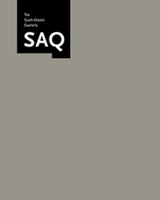 Relocating the Fault Lines: Turkey Beyond the East-West Divide, Volume 102
Güven Güzeldere and Sibel Irzik, eds.
Duke University Press Islamic but secular, ambivalent about its Ottoman past, and anxious for membership in the European Union, Turkey seems to be easily cast—in terms of its geographical and cultural situatedness—as a bridge between the East and the West. However, Relocating the Fault Lines asserts that contemporary Turkey can no longer be defined by such a simple framework. In recent decades, Turkish economy, society, and culture have undergone intense changes affected by influences other than Western modernity. Issues of national identity are being transformed by such phenomena as the rise of political Islam, integration into a global economy, ethnic conflict, and women’s struggles for autonomy. This special issue of SAQ explores how these redefinitions are occurring in the areas of art, literature, and popular culture as well as economy and politics. The essays examine the preoccupation of modern Turkish literature and popular culture with notions of imitation and authenticity, as well as the ways in which the country’s secularization serves to promote an "official Islam" Contributors. Hülya Adak, Meltem Ahiska, Ayse Gül Altinay, Tanil Bora, Ayse Bugra, Ümit Cizre, Menderes Çinar, Andrew Davison, Tuna Erdem, Suna Ertugrul, Kathy Ewing, Erdag Göknar, Nurdan Gülalp, Sibel Irzik, Orhan Koçak, Bruce Kuniholm, Jale Parla, Nükhet Sirman, Levent Soysal, Necmi Zeka
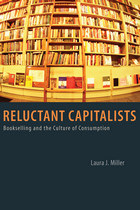 Reluctant Capitalists: Bookselling and the Culture of Consumption
Laura J. Miller
University of Chicago Press, 2006 Over the past half-century, bookselling, like many retail industries, has evolved from an arena dominated by independent bookstores to one in which chain stores have significant market share. And as in other areas of retail, this transformation has often been a less-than-smooth process. This has been especially pronounced in bookselling, argues Laura J. Miller, because more than most other consumer goods, books are the focus of passionate debate. What drives that debate? And why do so many people believe that bookselling should be immune to questions of profit?
In Reluctant Capitalists, Miller looks at a century of book retailing, demonstrating that the independent/chain dynamic is not entirely new. It began one hundred years ago when department stores began selling books, continued through the 1960s with the emergence of national chain stores, and exploded with the formation of “superstores” in the 1990s. The advent of the Internet has further spurred tremendous changes in how booksellers approach their business. All of these changes have met resistance from book professionals and readers who believe that the book business should somehow be “above” market forces and instead embrace more noble priorities.
Miller uses interviews with bookstore customers and members of the book industry to explain why books evoke such distinct and heated reactions. She reveals why customers have such fierce loyalty to certain bookstores and why they identify so strongly with different types of books. In the process, she also teases out the meanings of retailing and consumption in American culture at large, underscoring her point that any type of consumer behavior is inevitably political, with consequences for communities as well as commercial institutions.
 Reluctant Icon: Gladstone, Bulgaria, and the Working Classes, 1856–1878
Ann Pottinger Saab
Harvard University Press, 1991 Support of the Ottoman Empire was official British policy for some forty years following the Crimean War. A widespread and astonishing confidence prevailed in England: whatever past and continuing deficiencies might exist, the Ottoman Porte, as the government of the Empire was known in Europe, was determined to westernize and in fact was becoming more British every day. But reports of a series of alleged massacres by the Turks against their Bulgarian subjects scandalized Britain in 1876, igniting a firestorm of protest that shook the nation. Reluctant Icon tells the story of one of the most relentless social crusades of the Victorian era. Under the leadership of former prime minister William Ewart Gladstone, a loose coalition of Nonconformists, Radicals, and High Churchmen created a climate of indignation over the massacres that was strong enough to call into question the Disraeli government’s policy toward the Near East.
This absorbing analysis by Ann Pottinger Saab draws on contemporary newspaper accounts, parliamentary petitions, and the diaries and personal papers of Gladstone to recreate a pivotal episode in late nineteenth-century British history. Saab provides an informative historical backdrop to her study by tracing the multiple sources of strain in British–Ottoman relations that existed before the massacres. She then examines Gladstone’s evolving role as public idol and backstage adviser to a coterie of special groups that became bonded to him by a shared moral vision and a sense of continuing emergency. Through the lens of the Bulgarian agitation, Gladstone emerges as a man motivated more by his own complex emotional and political drives than by opportunism, a somewhat different picture from that presented by earlier historians. The heart of the book is Saab’s richly detailed exploration of the nascence and maturation of the militant, extra-parliamentary, multi-class protest movement itself, which mobilized the anger of groups previously outside politics such as newly enfranchised working men.
Reluctant Icon yields new insights on Gladstone, on the language of Victorian social protest, and on a national protest movement remarkable as much for its cohesiveness and longevity as for its fervor. It will be welcome reading for all those with an abiding interest in the Victorian age and especially for scholars and students of social, religious, and diplomatic history.
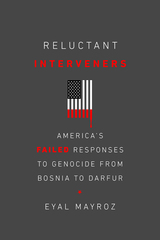 Reluctant Interveners: America's Failed Responses to Genocide from Bosnia to Darfur
Eyal Mayroz
Rutgers University Press, 2020 2020 Choice Outstanding Academic Title
Featured in the 2020 Association of University Presses Book, Jacket, and Journal Show
Why do we allow our governments to get away with “bystanding” to genocide? How can we, when alerted to the mass slaughter of innocents, still not take a stand? Reluctant Interveners provides the most comprehensive answers yet to these confronting questions, focusing on the complex relationships between the citizenry, the media, the political elites, and institutions in the most powerful nation in the world, the United States of America.
Eyal Mayroz offers a sobering account of the interactions between the governing and the governed, and the dynamics which transformed moral concerns for the lives of faraway “others” into cold political calculations. Exposed are the processes that turned the promise of “never again” to a recurring reality of ever again, the role of the office of the presidency in their advancement, and the resultant image of America as seen by the rest of the world. In a time of ubiquitous social media and populist revival, a greater role for the U.S. citizenry in decision-making on responses to genocide may be in the cards. The question is, in which directions will these trends take American foreign policy?
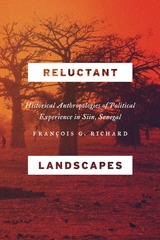 Reluctant Landscapes: Historical Anthropologies of Political Experience in Siin, Senegal
Francois G. Richard
University of Chicago Press, 2018 West African history is inseparable from the history of the Atlantic slave trade and colonialism. According to historical archaeologist François Richard, however, the dominance of this narrative not only colors the range of political discourse about Africa but also occludes many lesser-known—but equally important—experiences of those living in the region.
Reluctant Landscapes is an exploration of the making and remaking of political experience and physical landscapes among rural communities in the Siin province of Senegal between the late 1500s and the onset of World War II. By recovering the histories of farmers and commoners who made up African states’ demographic core in this period, Richard shows their crucial—but often overlooked—role in the making of Siin history. The book also delves into the fraught relation between the Seereer, a minority ethnic and religious group, and the Senegalese nation-state, with Siin’s perceived “primitive” conservatism standing at odds with the country’s Islamic modernity. Through a deep engagement with oral, documentary, archaeological, and ethnographic archives, Richard’s groundbreaking study revisits the four-hundred-year history of a rural community shunted to the margins of Senegal’s national imagination.
Reluctant Meister: How Germany's Past is Shaping Its European Future
Stephen Green
Haus Publishing, 2014 The Euro crisis has served as a stark reminder of the fundamental importance of Germany to the larger European project. But the image of Germany as the dominant power in Europe is at odds with much of its recent history. Reluctant Meister is a wide-ranging study of Germany from the Holy Roman Empire through the Second and Third Reichs, and it asks not only how such a mature and developed culture could have descended into the barbarism of Nazism but how it then rebuilt itself within a generation to become an economic powerhouse. Perhaps most important, Stephen Green examines to what extent Germany will come to dominate its relationship with its neighbors in the European Union, and what that will mean.
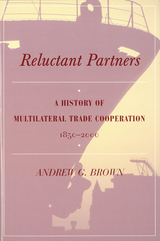 Reluctant Partners: A History of Multilateral Trade Cooperation, 1850-2000
Andrew G. Brown
University of Michigan Press, 2003 With globalization drawing countries closer together, greater international cooperation is essential for peace and stability. The collective arrangement made by governments to manage their trade relations is one of the few successes of globalization. This book assesses the progress of multilateral trade cooperation, exploring the interests at work and the issues raised in successive postwar rounds of negotiations. It traces how the narrow perception of reciprocity has gradually yielded to a broader evaluation of the benefits to the regime as a whole as the major trading nations have mutually reduced trade barriers. Andrew G. Brown demonstrates the increasing importance of rule making and shows the diversity of issues on which negotiations have focused, such as customs procedures, technical standards, subsidies, anti-dumping duties, intellectual property rights, and the treatment of foreign direct investment. Despite the progress, however, the regime has remained vulnerable. The book also analyzes the major sources of strain that have been evident.
This is a nontechnical book for those curious about the possibilities for cooperation among states and should be of interest to both the nonspecialist and the specialist. It draws on more than one discipline to interpret the events, lying in the triangle bounded by political science, economics, and history.
Andrew G. Brown is a former Director of the General Analysis and Policies Division for the United Nations, New York.
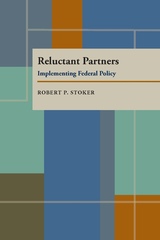 Reluctant Partners: Implementing Federal Policy
Robert P. Stoker
University of Pittsburgh Press, 1991
Constitutional principles at the core of the United States government divide authority between market and state and within the structure of the state itself. This diffusion of authority is valuable because it defends against the excesses of national government, causing federal policy initiatives to be more attuned to the concerns of local jurisdictions, and creating a context in which free enterprise may flourish.
However, this diffusion of authority weakens the control that federal officials enjoy over resources vital to the implementation of national policy. To implement their plans, federal policy formulators must often call upon autonomous participants such as state or local governments, advocacy groups, or commercial interests. When federal policy challenges the perspectives, interest, or priorities of these participants, they become reluctant partners. These implementation participants enjoy substantial autonomy, making their cooperation in pursuit of federal policy goals uncertain and difficult to achieve. How, then, can the federal government secure the cooperation it needs to implement policy when the act of implementation empowers potential adversaries?
Reluctant Partners explores these problems and proposes strategies to reduce the impediments to cooperation and promote policy coordination. Drawing upon theories of regime development and cooperation, Stoker suggests the “implementation regime framework” to analyze the difficulties of realizing cooperation in the implementation process. The framework is illustrated with numerous vignettes and two extensive case studies: the National School Lunch Program and federal nuclear waste disposal policy.
Reluctant Realists: The CDU/DSU and West German Ostpolitik
Clay Clemens
Duke University Press, 1989 This is a study of the evolution of the West German Christian Democratic Union/Christian Social Union (CDU/CSU) approach to relations with the Soviet bloc (and particularly East Germany), from fierce antagonism to any accommodation with Communist regimes in 1969 to the growing acceptance of the necessity for rapprochement in the 1980s. Clay Clemens, basing his analyses on interviews with leading political figures as well as on party documents, examines the party’s changing ostpolitik position during the period in which it was in opposition (1969-82) and assesses the factors—international, domestic, and interparty—that brought about a change in that policy. A concluding section deals with events since 1982.
Remain
Ioana B. Jucan
University of Minnesota Press, 2018 Engaging with remains and remainders of media cultures
As new, as current, as now—this is primarily our understanding of technologies and their mediating of our social constructions. But past media and past practices continue to haunt and inflect our present social and technical arrangements. To trace this haunting, two performance theorists and a media theorist engage in this volume with remains and remainders of media cultures through the lenses of theatre and performance studies and of media archaeology. They address the temporalities and materialities of remain(s), the production of obsolescence in relation to the live body, and considerations of cultural memory as well as of infrastructure and the natural history of media culture.
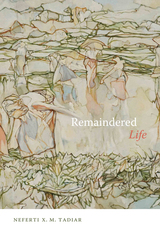 Remaindered Life
Neferti X. Tadiar
Duke University Press, 2022 In Remaindered Life Neferti X. M. Tadiar offers a new conceptual vocabulary and framework for rethinking the dynamics of a global capitalism maintained through permanent imperial war. Tracking how contemporary capitalist accumulation depends on producing life-times of disposability, Tadiar focuses on what she terms remaindered life—practices of living that exceed the distinction between life worth living and life worth expending. Through this heuristic, Tadiar reinterprets the global significance and genealogy of the surplus life-making practices of migrant domestic and service workers, refugees fleeing wars and environmental disasters, criminalized communities, urban slum dwellers, and dispossessed Indigenous people. She also examines artists and filmmakers in the Global South who render forms of various living in the midst of disposability. Retelling the story of globalization from the side of those who reach beyond dominant protocols of living, Tadiar demonstrates how attending to remaindered life can open up another horizon of possibility for a radical remaking of our present global mode of life.
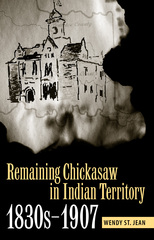 Remaining Chickasaw in Indian Territory, 1830s-1907
Wendy St. Jean
University of Alabama Press, 2011 In the early 1800s, the U.S. government attempted to rid the Southeast of Indians in order to make way for trading networks, American immigration, optimal land use, economic development opportunities, and, ultimately, territorial expansion westward to the Pacific. The difficult removal of the Chickasaw Nation to Indian Territory—later to become part of the state of Oklahoma— was exacerbated by the U.S. government’s unenlightened decision to place the Chickasaws on lands it had previously provided solely for the Choctaw Nation. This volume deals with the challenges the Chickasaw people had from attacking Texans and Plains Indians, the tribe’s ex-slaves, the influence on the tribe of intermarried white men, and the presence of illegal aliens (U.S. citizens) in their territory. By focusing on the tribal and U.S. government policy conflicts, as well as longstanding attempts of the Chickasaw people to remain culturally unique, St. Jean reveals the successes and failures of the Chickasaw in attaining and maintaining sovereignty as a separate and distinct Chickasaw Nation.
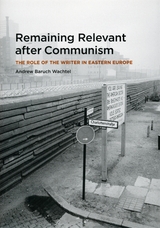 Remaining Relevant after Communism: The Role of the Writer in Eastern Europe
Andrew Baruch Wachtel
University of Chicago Press, 2005 More than any other art form, literature defined Eastern Europe as a cultural and political entity in the second half of the twentieth century. Although often persecuted by the state, East European writers formed what was frequently recognized to be a "second government," and their voices were heard and revered inside and outside the borders of their countries. This study by one of our most influential specialists on Eastern Europe considers the effects of the end of communism on such writers.
According to Andrew Baruch Wachtel, the fall of the Berlin Wall and the creation of fledgling societies in Eastern Europe brought an end to the conditions that put the region's writers on a pedestal. In the euphoria that accompanied democracy and free markets, writers were liberated from the burden of grandiose political expectations. But no group is happy to lose its influence: despite recognizing that their exalted social position was related to their reputation for challenging political oppression, such writers have worked hard to retain their status, inventing a series of new strategies for this purpose. Remaining Relevant after Communism considers these strategies—from pulp fiction to public service—documenting what has happened on the East European scene since 1989.
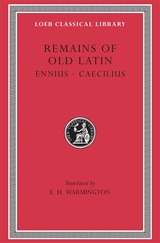 Remains of Old Latin, Volume I: Ennius. Caecilius
Translated by E. H. Warmington
Harvard University Press The Loeb edition of early Latin writings is in four volumes. The first three contain the extant work of seven poets and surviving portions of the Twelve Tables of Roman law. The fourth volume contains inscriptions on various materials (including coins), all written before 79 BCE.
Volume I. Q. Ennius (239–169) of Rudiae (Rugge), author of a great epic (Annales), tragedies and other plays, and satire and other works; Caecilius Statius (ca. 220–ca. 166), a Celt probably of Mediolanum (Milano) in N. Italy, author of comedies.
Volume II. L. Livius Andronicus (ca. 284–204) of Tarentum (Taranto), author of tragedies, comedies, a translation and paraphrase of Homer's Odyssey, and hymns; Cn. Naevius (ca. 270–ca. 200), probably of Rome, author of an epic on the 1st Punic War, comedies, tragedies, and historical plays; M. Pacuvius (ca. 220–ca. 131) of Brundisium (Brindisi), a painter and later an author of tragedies, a historical play and satire; L. Accius (170–ca. 85) of Pisaurum (Pisaro), author of tragedies, historical plays, stage history and practice, and some other works; fragments of tragedies by authors unnamed.
Volume III. C. Lucilius (180?–102/1) of Suessa Aurunca (Sessa), writer of satire; The Twelve Tables of Roman law, traditionally of 451–450.
Volume IV. Archaic Inscriptions: Epitaphs, dedicatory and honorary inscriptions, inscriptions on and concerning public works, on movable articles, on coins; laws and other documents.
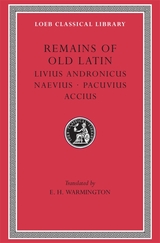 Remains of Old Latin, Volume II: Livius Andronicus. Naevius. Pacuvius. Accius
Translated by E. H. Warmington
Harvard University Press The Loeb edition of early Latin writings is in four volumes. The first three contain the extant work of seven poets and surviving portions of the Twelve Tables of Roman law. The fourth volume contains inscriptions on various materials (including coins), all written before 79 BCE.
Volume I. Q. Ennius (239–169) of Rudiae (Rugge), author of a great epic (Annales), tragedies and other plays, and satire and other works; Caecilius Statius (ca. 220–ca. 166), a Celt probably of Mediolanum (Milano) in N. Italy, author of comedies.
Volume II. L. Livius Andronicus (ca. 284–204) of Tarentum (Taranto), author of tragedies, comedies, a translation and paraphrase of Homer's Odyssey, and hymns; Cn. Naevius (ca. 270–ca. 200), probably of Rome, author of an epic on the 1st Punic War, comedies, tragedies, and historical plays; M. Pacuvius (ca. 220–ca. 131) of Brundisium (Brindisi), a painter and later an author of tragedies, a historical play and satire; L. Accius (170–ca. 85) of Pisaurum (Pisaro), author of tragedies, historical plays, stage history and practice, and some other works; fragments of tragedies by authors unnamed.
Volume III. C. Lucilius (180?–102/1) of Suessa Aurunca (Sessa), writer of satire; The Twelve Tables of Roman law, traditionally of 451–450.
Volume IV. Archaic Inscriptions: Epitaphs, dedicatory and honorary inscriptions, inscriptions on and concerning public works, on movable articles, on coins; laws and other documents.
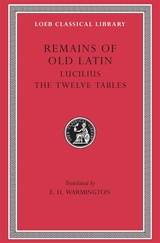 Remains of Old Latin, Volume III: Lucilius. The Twelve Tables
E. H. Warmington
Harvard University Press A miscellany of satire and law.
This edition of early Latin writings is in four volumes. The first three contain the extant work of seven poets and surviving portions of the Twelve Tables of Roman law. The fourth volume contains inscriptions on various materials (including coins), all written before 79 BC.
Volume I. Q. Ennius (239–169) of Rudiae (Rugge), author of a great epic (Annales), tragedies and other plays, and satire and other works; Caecilius Statius (ca. 220–ca. 166), a Celt probably of Mediolanum (Milano) in N. Italy, author of comedies.
Volume II. L. Livius Andronicus (ca. 284–204) of Tarentum (Taranto), author of tragedies, comedies, a translation and paraphrase of Homer’s Odyssey, and hymns; Cn. Naevius (ca. 270–ca. 200), probably of Rome, author of an epic on the 1st Punic War, comedies, tragedies, and historical plays; M. Pacuvius (ca. 220–ca. 131) of Brundisium (Brindisi), a painter and later an author of tragedies, a historical play and satire; L. Accius (170–ca. 85) of Pisaurum (Pisaro), author of tragedies, historical plays, stage history and practice, and some other works; fragments of tragedies by authors unnamed.
Volume III. C. Lucilius (180?–102/1) of Suessa Aurunca (Sessa), writer of satire; The Twelve Tables of Roman law, traditionally of 451–450.
Volume IV. Archaic Inscriptions: Epitaphs, dedicatory and honorary inscriptions, inscriptions on and concerning public works, on movable articles, on coins; laws and other documents.
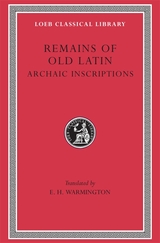 Remains of Old Latin, Volume IV: Archaic Inscriptions
E. H. Warmington
Harvard University Press Physical graffiti.
This edition of early Latin writings is in four volumes. The first three contain the extant work of seven poets and surviving portions of the Twelve Tables of Roman law. The fourth volume contains inscriptions on various materials (including coins), all written before 79 BC.
Volume I. Q. Ennius (239–169) of Rudiae (Rugge), author of a great epic (Annales), tragedies and other plays, and satire and other works; Caecilius Statius (ca. 220–ca. 166), a Celt probably of Mediolanum (Milano) in N. Italy, author of comedies.
Volume II. L. Livius Andronicus (ca. 284–204) of Tarentum (Taranto), author of tragedies, comedies, a translation and paraphrase of Homer’s Odyssey, and hymns; Cn. Naevius (ca. 270–ca. 200), probably of Rome, author of an epic on the 1st Punic War, comedies, tragedies, and historical plays; M. Pacuvius (ca. 220–ca. 131) of Brundisium (Brindisi), a painter and later an author of tragedies, a historical play and satire; L. Accius (170–ca. 85) of Pisaurum (Pisaro), author of tragedies, historical plays, stage history and practice, and some other works; fragments of tragedies by authors unnamed.
Volume III. C. Lucilius (180?–102/1) of Suessa Aurunca (Sessa), writer of satire; The Twelve Tables of Roman law, traditionally of 451–450.
Volume IV. Archaic Inscriptions: Epitaphs, dedicatory and honorary inscriptions, inscriptions on and concerning public works, on movable articles, on coins; laws and other documents.
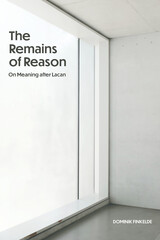 The Remains of Reason: On Meaning after Lacan
Dominik Finkelde
Northwestern University Press, 2025 Unpacking the central role of the unconscious in the relationship between mind and world Over a series of careful readings and accessible discussions, prefaced by a foreword from Eric Santner, Dominik Finkelde analyzes the central role of the unconscious in the relationship between mind and world. Moving beyond Freud, Kant, and Hegel and toward the contemporary work of the Ljubljana School, he explores how humans relate to facts and the influence of the unconscious on questions regarding truth, perception, and meaning. Aspects of recognition and unconscious processes of transference are at stake in these fundamental questions of perception and knowledge, though these have been widely ignored in epistemological and ontological debates in contemporary philosophy. Finkelde draws on both the continental and analytic traditions, ultimately building from the work of current-day interlocutors to interrogate questions concerning the influence of enigmatic signifiers, the role of sublime objects of ideology, the importance of fantasy cultivation and transgression, and the power of jouissance as an ontological factor.
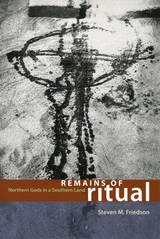 Remains of Ritual: Northern Gods in a Southern Land
Steven M. Friedson
University of Chicago Press, 2009 Remains of Ritual, Steven M. Friedson’s second book on musical experience in African ritual, focuses on the Brekete/Gorovodu religion of the Ewe people. Friedson presents a multifaceted understanding of religious practice through a historical and ethnographic study of one of the dominant ritual sites on the southern coast of Ghana: a medicine shrine whose origins lie in the northern region of the country. Each chapter of this fascinating book considers a different aspect of ritual life, demonstrating throughout that none of them can be conceived of separately from their musicality—in the Brekete world, music functions as ritual and ritual as music. Dance and possession, chanted calls to prayer, animal sacrifice, the sounds and movements of wake keeping, the play of the drums all come under Friedson’s careful scrutiny, as does his own position and experience within this ritual-dominated society.
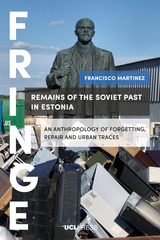 Remains of the Soviet Past in Estonia: An Anthropology of Forgetting, Repair and Urban Traces
Francisco Martinez
University College London, 2018 What happens to legacies that do not find any continuation? In Estonia, a new generation that does not remember the socialist era and is open to global influences has grown up. As a result, the impact of the Soviet memory in people's conventional values is losing its effective power, allowing for new opportunities for recuperation.
Francisco Martinez brings together a number of sites of interest to explore the vanquishing of the Soviet legacy in Estonia: a street market in Tallinn where concepts such as "market" and "employment" take on distinctly different meanings from their Western use; Linnahall, a multi-purpose venue, whose Soviet heritage now poses difficult questions of how to present the building’s history; Tallinn’s cityscape, where the social, spatial, and temporal coevolution of the city can be viewed and debated; Narva, a city that marks the border between the Russian Federation, NATO, and the European Union and represents a place of continual negotiation; and the new Estonian National Museum in Raadi, an area on the outskirts of Tartu that has avoided promoting a single narrative of the past.
By exploring these places of cultural and historical significance, which all contribute to our understanding of how the new generation in Estonia is not following the expectations and values of its predecessor, the book also demonstrates how we can understand generational change in a material sense.
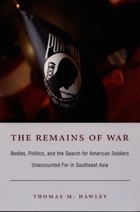 The Remains of War: Bodies, Politics, and the Search for American Soldiers Unaccounted For in Southeast Asia
Thomas M. Hawley
Duke University Press, 2005 The ongoing effort of the United States to account for its missing Vietnam War soldiers is unique. The United States requires the repatriation and positive identification of soldiers’ bodies to remove their names from the list of the missing. This quest for certainty in the form of the material, identified body marks a dramatic change from previous wars, in which circumstantial evidence often sufficed to account for missing casualties. In The Remains of War, Thomas M. Hawley considers why the body of the missing soldier came to assume such significance in the wake of the Vietnam War. Illuminating the relationship between the effort to account for missing troops and the political and cultural forces of the post-Vietnam era, Hawley argues that the body became the repository of the ambiguities and anxieties surrounding the U.S. involvement and defeat in Southeast Asia. Hawley combines the theoretical insights of Judith Butler, Michel Foucault, and Emmanuel Levinas with detailed research into the history of the movement to recover the remains of soldiers missing in Vietnam. He examines the practices that constitute the Defense Department’s accounting protocol: the archival research, archaeological excavation, and forensic identification of recovered remains. He considers the role of the American public and the families of missing soldiers in demanding the release of pows and encouraging the recovery of the missing; the place of the body of the Vietnam veteran within the war’s legacy; and the ways that memorials link individual bodies to the body politic. Highlighting the contradictions inherent in the recovery effort, Hawley reflects on the ethical implications of the massive endeavor of the American government and many officials in Vietnam to account for the remains of American soldiers.
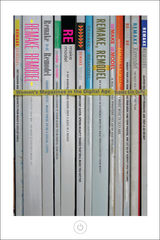 Remake, Remodel: Women's Magazines in the Digital Age
Brooke Erin Duffy
University of Illinois Press, 2013 What is a magazine? For decades, women's magazines were regularly published, print-bound guidebooks aimed at neatly defined segments of the female audience. Crisp pages, a well-composed visual aesthetic, an intimate tone, and a distinctive editorial voice were among the hallmarks of women's glossies up through the turn of this century. Yet amidst an era of convergent media technologies, participatory culture, and new demands from advertisers, questions about the identity of women's magazines have been cast up for reflection. Remake, Remodel: Women's Magazines in the Digital Age offers a unique glimpse inside the industry and reveals how executives and content creators are remaking their roles, their audiences, and their products at this critical historic juncture. Through in-depth interviews with women's magazine producers, an examination of hundreds of trade press reports, and in-person observations at industry summits, Brooke Erin Duffy chronicles a fascinating shift in print culture and technology from the magazine as object to the magazine as brand. She draws on these findings to contribute to timely debates about media producers' labor conditions, workplace hierarchies, and creative processes in light of transformed technologies and media economies.
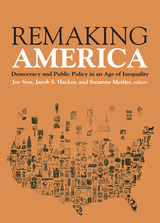 Remaking America: Democracy and Public Policy in an Age of Inequality
Joe Soss
Russell Sage Foundation, 2007 Over the past three decades, the contours of American social, economic, and political life have changed dramatically. The post-war patterns of broadly distributed economic growth have given way to stark inequalities of income and wealth, the GOP and its allies have gained power and shifted U.S. politics rightward, and the role of government in the lives of Americans has changed fundamentally. Remaking America explores how these trends are related, investigating the complex interactions of economics, politics, and public policy. Remaking America explains how the broad restructuring of government policy has both reflected and propelled major shifts in the character of inequality and democracy in the United States. The contributors explore how recent political and policy changes affect not just the social standing of Americans but also the character of democratic citizenship in the United States today. Lawrence Jacobs shows how partisan politics, public opinion, and interest groups have shaped the evolution of Medicare, but also how Medicare itself restructured health politics in America. Kimberly Morgan explains how highly visible tax policies created an opportunity for conservatives to lead a grassroots tax revolt that ultimately eroded of the revenues needed for social-welfare programs. Deborah Stone explores how new policies have redefined participation in the labor force—as opposed to fulfilling family or civic obligations—as the central criterion of citizenship. Frances Fox Piven explains how low-income women remain creative and vital political actors in an era in which welfare programs increasingly subject them to stringent behavioral requirements and monitoring. Joshua Guetzkow and Bruce Western document the rise of mass incarceration in America and illuminate its unhealthy effects on state social-policy efforts and the civic status of African-American men. For many disadvantaged Americans who used to look to government as a source of opportunity and security, the state has become increasingly paternalistic and punitive. Far from standing alone, their experience reflects a broader set of political victories and policy revolutions that have fundamentally altered American democracy and society. Empirically grounded and theoretically informed, Remaking America connects the dots to provide insight into the remarkable social and political changes of the last three decades.
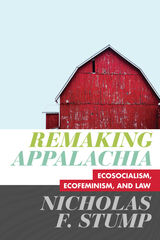 Remaking Appalachia: Ecosocialism, Ecofeminism, and Law
Nicholas F. Stump
West Virginia University Press, 2021 A critical legal scholar uses feminist and environmental theory to sketch alternate futures for Appalachia.
Environmental law has failed spectacularly to protect Appalachia from the ravages of liberal capitalism, and from extractive industries in particular. Remaking Appalachia chronicles such failures, but also puts forth hopeful paths for truly radical change.
Remaking Appalachia begins with an account of how, over a century ago, laws governing environmental and related issues proved fruitless against the rising power of coal and other industries. Key legal regimes were, in fact, explicitly developed to support favored industrial growth. Aided by law, industry succeeded in maximizing profits not just through profound exploitation of Appalachia’s environment but also through subordination along lines of class, gender, and race. After chronicling such failures and those of liberal development strategies in the region, Stump explores true system change beyond law “reform.” Ecofeminism and ecosocialism undergird this discussion, which involves bottom-up approaches to transcending capitalism that are coordinated from local to global scales.
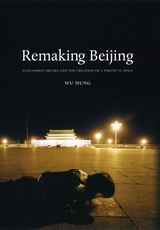 Remaking Beijing: Tiananmen Square and the Creation of a Political Space
Wu Hung
University of Chicago Press, 2005 In 1949, Beijing still retained nearly all of its time-honored character and magnificence. But when Chairman Mao rejected the proposal to build a new capital for the People's Republic of China and decided to stay in the ancient city, he initiated a long struggle to transform Beijing into a shining beacon of socialism. So began the remaking of the city into a modern metropolis rife with monuments, public squares, exhibition halls, and government offices.
Wu Hung grew up in Beijing and experienced much of the city's makeover firsthand. In this lavishly illustrated work, he offers a vivid, often personal account of the struggle over Beijing's reinvention, drawing particular attention to Tiananmen Square—the most sacred space in the People's Republic of China. Remaking Beijing considers the square's transformation from a restricted imperial domain into a public arena for political expression, from an epic symbol of socialism into a holy relic of the Maoist regime, and from an official and monumental complex into a site for unofficial and antigovernment demonstrations.
Wu Hung also explores how Tiananmen Square has become a touchstone for official art in modern China—as the site for Mao's monumental portrait, as the location of museums narrating revolutionary history, and as the grounds for extravagant National Day parades celebrating the revolutionary masses. He then shows how in recent years the square has inspired artists working without state sponsorship to create paintings, photographs, and even performances that reflect the spirit of the 1989 uprisings and pose a forceful challenge to official artworks and the sociopolitical system that supports them.
Remaking Beijing will reward anyone interested in modern Chinese history, society, and art, or, more generally, in how urban renewal becomes intertwined with cultural and national politics.
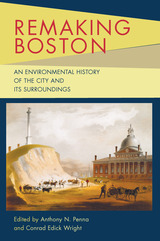 Remaking Boston: An Environmental History of the City and Its Surroundings
Anthony N. Penna
University of Pittsburgh Press, 2009 Since its settlement in 1630, Boston, its harbor, and outlying regions have witnessed a monumental transformation at the hands of humans and by nature. Remaking Boston chronicles many of the events that altered the physical landscape of Boston, while also offering multidisciplinary perspectives on the environmental history of one of America's oldest and largest metropolitan areas.
Situated on an isthmus, and blessed with a natural deepwater harbor and ocean access, Boston became an important early trade hub with Europe and the world. As its population and economy grew, developers extended the city's shoreline into the surrounding tidal mudflats to create more useable land. Further expansion of the city was achieved through the annexation of surrounding communities, and the burgeoning population and economy spread to outlying areas. The interconnection of city and suburb opened the floodgates to increased commerce, services and workforces, while also leaving a wake of roads, rails, bridges, buildings, deforestation, and pollution.
Profiling this ever-changing environment, the contributors tackle a variety of topics, including: the glacial formation of the region; physical characteristics and composition of the land and harbor; dredging, sea walling, flattening, and landfill operations in the reshaping of the Shawmut Peninsula; the longstanding controversy over the link between landfills and shoaling in shipping channels; population movements between the city and suburbs and their environmental implications; interdependence of the city and its suburbs; preservation and reclamation of the Charles River; suburban deforestation and later reforestation as byproducts of changing land use; the planned outlay of parks and parkways; and historic climate changes and the human and biological adaptations to them.
 Remaking China Policy: U.S.–China Relations and Government Decisionmaking
Richard Moorsteen and Morton Abramowitz
Harvard University Press, 1971 Authors Richard Moorsteen and Morton Abramowitz propose an innovative plan for improving U.S.–China relations. Dealing effectively with China requires both a long-term perspective and an approach that faces up to fundamental issues, going beyond “atmospherics” and gestures.
Yet such a goal must be achieved within the prevailing uncertainty about China’s intentions. It must be sought through an evolving process of exploratory steps that would enable policymakers to discover more about Chinese responses and to incorporate this knowledge into future policy: (1) a policy of “one China but not now” that could gradually move us toward Peking’s preferred “one China”; (2) a U.S. position on Chinese representation in the United Nations that would allow us to acquiesce in Peking’s admission; (3) quiet but explicit encouragement to both Bangkok and Peking for a modest improvement in relations between them; (4) an effort to convey U.S. views (and to explore Peking’s) on nuclear non-proliferation in Asia; (5) an approach to offset Chinese fears about the U.S.–Soviet Strategic Arms Limitation Talks.
The authors analyze deficiencies in the way the government now develops its China policy. To implement their new approach, they propose both organizational and procedural changes, including new modes of interaction between government China specialists and their policymaking superiors and the establishment of a policy group high enough in rank and broad enough in responsibility to deal with U.S.–China relations as a whole.
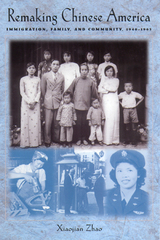 Remaking Chinese America: Immigration, Family, and Community, 1940-1965
Zhao, Xiaojian
Rutgers University Press, 2001 In Remaking Chinese America, Xiaojian Zhao explores the myriad forces that changed and unified Chinese Americans during a key period in American history. Prior to 1940, this immigrant community was predominantly male, but between 1940 and 1965 it was transformed into a family-centered American ethnic community. Zhao pays special attention to forces both inside and outside of the country in order to explain these changing demographics. She scrutinizes the repealed exclusion laws and the immigration laws enacted after 1940. Careful attention is also paid to evolving gender roles, since women constituted the majority of newcomers, significantly changing the sex ratio of the Chinese American population.
As members of a minority sharing a common cultural heritage as well as pressures from the larger society, Chinese Americans networked and struggled to gain equal rights during the cold war period. In defining the political circumstances that brought the Chinese together as a cohesive political body, Zhao also delves into the complexities they faced when questioning their personal national allegiances. Remaking Chinese America uses a wealth of primary sources, including oral histories, newspapers, genealogical documents, and immigration files to illuminate what it was like to be Chinese living in the United States during a period that—until now—has been little studied.
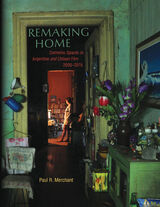 Remaking Home: Domestic Spaces in Argentine and Chilean Film, 2005-2015
Paul Merchant
University of Pittsburgh Press, 2022 Houses, in the Argentine and Chilean films of the early twenty-first century, provide much more than a backdrop to on-screen drama. Nor are they simply refuges from political turmoil or spaces of oppression. Remaking Home argues that domestic spaces are instead the medium through which new, fragile common identities are constructed. The varied documentary and fiction films analyzed here, which include an early work by Oscar winner Sebastián Lelio, use the domestic sphere as a laboratory in which to experiment with narrative, audiovisual techniques, and social configurations. Where previous scholarship has focused on the social fragmentation and political disillusionment visible in contemporary film, Remaking Home argues that in order to understand the political agency of contemporary cinema, it is necessary to move beyond deconstructive critical approaches to Latin American culture. In doing so, it expands the theoretical scope of studies in Latin American cinema by finding new points of contact between the cultural critique of Nelly Richard, the work of Bruno Latour, and theories of new materialism.
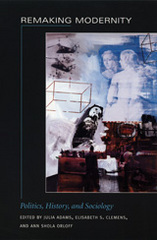 Remaking Modernity: Politics, History, and Sociology
Julia Adams, Elisabeth S. Clemens, Ann Shola Orloff, eds.
Duke University Press, 2005 A state-of-the-field survey of historical sociology, Remaking Modernity assesses the field’s past accomplishments and peers into the future, envisioning changes to come. The seventeen essays in this collection reveal the potential of historical sociology to transform understandings of social and cultural change. The volume captures an exciting new conversation among historical sociologists that brings a wider interdisciplinary project to bear on the problems and prospects of modernity. The contributors represent a wide variety of theoretical orientations and a broad spectrum of understandings of what constitutes historical sociology. They address such topics as religion, war, citizenship, markets, professions, gender and welfare, colonialism, ethnicity, bureaucracy, revolutions, collective action, and the modernist social sciences themselves. Remaking Modernity includes a significant introduction in which the editors consider prior orientations in historical sociology in order to analyze the field’s resurgence. They show how current research is building on and challenging previous work through attention to institutionalism, rational choice, the cultural turn, feminist theories and approaches, and colonialism and the racial formations of empire. Contributors
Julia Adams
Justin Baer
Richard Biernacki
Bruce Carruthers
Elisabeth Clemens
Rebecca Jean Emigh
Russell Faeges
Philip Gorski
Roger Gould
Meyer Kestnbaum
Edgar Kiser
Ming-Cheng Lo
Zine Magubane
Ann Shola Orloff
Nader Sohrabi
Margaret Somers
Lyn Spillman
George Steinmetz
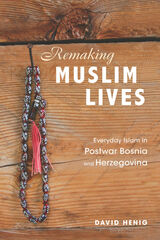 Remaking Muslim Lives: Everyday Islam in Postwar Bosnia and Herzegovina
David Henig
University of Illinois Press, 2020 The violent disintegration of Yugoslavia and the cultural and economic dispossession caused by the collapse of socialism continue to force Muslims in Bosnia and Herzegovina to reconfigure their religious lives and societal values. David Henig draws on a decade of fieldwork to examine the historical, social, and emotional labor undertaken by people to live in an unfinished past--and how doing so shapes the present. In particular, Henig questions how contemporary religious imagination, experience, and practice infuse and interact with social forms like family and neighborhood and with the legacies of past ruptures and critical events. His observations and analysis go to the heart of how societal and historical entanglements shape, fracture, and reconfigure religious convictions and conduct. Provocative and laden with eyewitness detail, Remaking Muslim Lives offers a rare sustained look at what it means to be Muslim and live a Muslim life in contemporary Bosnia and Herzegovina.
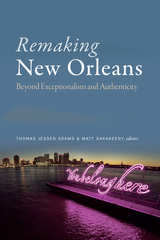 Remaking New Orleans: Beyond Exceptionalism and Authenticity
Thomas J. Adams and Matt Sakakeeny, editors
Duke University Press, 2019 Approached as a wellspring of cultural authenticity and historical exceptionality, New Orleans appears in opposition to a nation perpetually driven by progress. Remaking New Orleans shows how this narrative is rooted in a romantic cultural tradition, continuously repackaged through the twin engines of tourism and economic development, and supported by research that has isolated the city from comparison and left unquestioned its entrenched inequality. Working against this feedback loop, the contributors place New Orleans at the forefront of national patterns of urban planning, place-branding, structural inequality, and racialization. Nontraditional sites like professional wrestling matches, middle-class black suburbs, and Vietnamese gardens take precedence over clichéd renderings of Creole cuisine, voodoo queens, and hot jazz. Covering the city's founding through its present and highlighting changing political and social formations, this volume remakes New Orleans as a rich site for understanding the quintessential concerns of American cities.
Contributors. Thomas Jessen Adams, Vincanne Adams, Vern Baxter, Maria Celeste Casati Allegretti, Shannon Lee Dawdy, Rien Fertel, Megan French-Marcelin, Cedric G. Johnson, Alecia P. Long, Vicki Mayer, Toby Miller, Sue Mobley, Marguerite Nguyen, Aaron Nyerges, Adolph Reed Jr., Helen A. Regis, Matt Sakakeeny, Heidi Schmalbach, Felipe Smith, Bryan Wagner
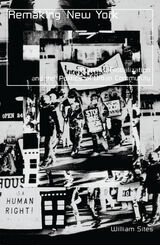 Remaking New York: Primitive Globalization And The Politics Of Urban Community
William Sites
University of Minnesota Press, 2003 Uses New York City to discuss the ways that policy has mismanaged the effects of globalization Inequality increases, instability grows, communities fragment: this is the fate of a city in the wake of globalization—but is globalization really the cause? Proposing a new perspective on politics, globalization, and the city, this provocative book argues that such urban problems result in part from U.S. policies that can be changed. William Sites develops the concept of primitive globalization, identifying a pattern of reactive politics—ad hoc measures to subsidize business, displace the urban poor, and dismantle the welfare state—that uproots social actors (corporations, citizens, urban residents) and facilitates a damaging, short-term-oriented type of international integration. In light of this theory, Sites examines the transformation of New York City since the 1970s, focusing on the logic of political action at national, local, and neighborhood levels. In the process, the story of late twentieth-century New York and its Lower East Side community emerges as something different: not a tale of globalist transformation or of local resurgence but a distinctly American case, one in which urban politics and the state, in their own right, exacerbate inequality and community fragmentation within the city.
 Remaking New Zealand and Australian Economic Policy: Ideas, Institutions and Policy Communities
Shaun Goldfinch
Georgetown University Press, 2000 During the 1980s and early 1990s, Australia and New Zealand extensively deregulated their economies to create two of the most open markets in the industrialized world. Drawing on interviews with more than 180 leading policymakers in Australia and New Zealand—including former prime ministers, ministers of finance, treasurers, and public servants—Shaun Goldfinch analyzes the factors that made the deregulation process different in each country. Describing specific policies—including liberalization of financial and capital markets, lowering of trade barriers, the floating of the exchange rate, and privatization—he compares the "crash-through" approach that characterized reform in New Zealand with the "bargained consensus" that underpinned change in Australia. In Australia, influences on policy were relatively diffuse and implementations open and decentralized. New Zealand’s more centralized government structure resulted in a concentration of influence and less deliberation. He contrasts rapid and gradual change, arguing that the latter may yield better policy results and prevent political instability. Shedding new light on the economic policymaking process, including the role of economic ideas, institutions, and policy elites, this book will appeal to both students and professionals in interested in public policy, comparative politics, and economics.
 Remaking Pacific Pasts: History, Memory, and Identity in Contemporary Theatre from Oceania
Diana Looser
University of Hawaii Press, 2014 Since the late 1960s, drama by Pacific Island playwrights has flourished throughout Oceania. Although many Pacific Island cultures have a broad range of highly developed indigenous performance forms—including oral narrative, clowning, ritual, dance, and song—scripted drama is a relatively recent phenomenon. Emerging during a period of region-wide decolonization and indigenous self-determination movements, most of these plays reassert Pacific cultural perspectives and performance techniques in ways that employ, adapt, and challenge the conventions and representations of Western theater.
Drawing together discussions in theater and performance studies, historiography, Pacific studies, and postcolonial studies, Remaking Pacific Pasts offers the first full-length comparative study of this dynamic and expanding body of work. It introduces readers to the field with an overview of significant works produced throughout the region over the past fifty years, including plays in English and in French, as well as in local vernaculars and lingua francas. The discussion traces the circumstances that have given rise to a particular modern dramatic tradition in each site and also charts routes of theatrical circulation and shared artistic influences that have woven connections beyond national borders.
This broad survey contextualizes the more detailed case studies that follow, which focus on how Pacific dramatists, actors, and directors have used theatrical performance to critically engage the Pacific’s colonial and postcolonial histories. Chapters provide close readings of selected plays from Hawai`i, Aotearoa/New Zealand, New Caledonia/Kanaky, and Fiji that treat events, figures, and legacies of the region’s turbulent past: Captain Cook’s encounters, the New Zealand Wars, missionary contact, the overthrow of the Hawaiian monarchy, and the Fiji coups. The book explores how, in their remembering and retelling of these pasts, theater artists have interrogated and revised repressive and marginalizing models of historical understanding developed through Western colonialism or exclusionary indigenous nationalisms, and have opened up new spaces for alternative historical narratives and ways of knowing. In so doing, these works address key issues of identity, genealogy, representation, political parity, and social unity, encouraging their audiences to consider new possibilities for present and future action. This study emphasizes the contribution of artistic production to social and political life in the contemporary Pacific, demonstrating how local play production has worked to facilitate processes of creative nation building and the construction of modern regional imaginaries.
Remaking Pacific Pasts makes valuable contributions to Pacific literature, world theater history, Pacific studies, and postcolonial studies. The book opens up to comparative critical discussion a geopolitical region that has received little attention from theater and performance scholars, extending our understanding of the form and function of theater in different cultural contexts. It enriches existing discussions in postcolonial studies about the decolonizing potential of literary and artistic endeavors, and it suggests how theater might function as a mode of historical enquiry and debate, adding to discussions about ways in which Pacific histories might be developed, challenged, or recalibrated. Consequently, the book stimulates new discussions in Pacific studies where theater has, to date, suffered from a lack of critical exposure. Carefully researched and original in its approach, Remaking Pacific Pasts will appeal to scholars, graduate students, and upper-level undergraduate students in theater and performance studies and Pacific Islands studies; it will also be of interest to cultural historians and to specialists in cultural studies and postcolonial studies.
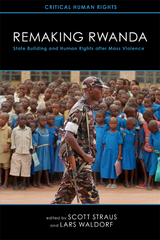 Remaking Rwanda: State Building and Human Rights after Mass Violence
Scott Straus
University of Wisconsin Press, 2011 In the mid-1990s, civil war and genocide ravaged Rwanda. Since then, the country’s new leadership has undertaken a highly ambitious effort to refashion Rwanda’s politics, economy, and society, and the country’s accomplishments have garnered widespread praise. Remaking Rwanda is the first book to examine Rwanda’s remarkable post-genocide recovery in a comprehensive and critical fashion. By paying close attention to memory politics, human rights, justice, foreign relations, land use, education, and other key social institutions and practices, this volume raises serious concerns about the depth and durability of the country’s reconstruction. Edited by Scott Straus and Lars Waldorf, Remaking Rwanda brings together experienced scholars and human rights professionals to offer a nuanced, historically informed picture of post-genocide Rwanda—one that reveals powerful continuities with the nation’s past and raises profound questions about its future. Best Special Interest Books, selected by the American Association of School Librarians Best Special Interest Books, selected by the Public Library Reviewers
 Remaking the American Mainstream: Assimilation and Contemporary Immigration
Richard Alba and Victor Nee
Harvard University Press, 2003 In this age of multicultural democracy, the idea of assimilation--that the social distance separating immigrants and their children from the mainstream of American society closes over time--seems outdated and, in some forms, even offensive. But as Richard Alba and Victor Nee show in the first systematic treatment of assimilation since the mid-1960s, it continues to shape the immigrant experience, even though the geography of immigration has shifted from Europe to Asia, Africa, and Latin America. Institutional changes, from civil rights legislation to immigration law, have provided a more favorable environment for nonwhite immigrants and their children than in the past.
Assimilation is still driven, in claim, by the decisions of immigrants and the second generation to improve their social and material circumstances in America. But they also show that immigrants, historically and today, have profoundly changed our mainstream society and culture in the process of becoming Americans.
Surveying a variety of domains--language, socioeconomic attachments, residential patterns, and intermarriage--they demonstrate the continuing importance of assimilation in American life. And they predict that it will blur the boundaries among the major, racially defined populations, as nonwhites and Hispanics are increasingly incorporated into the mainstream.
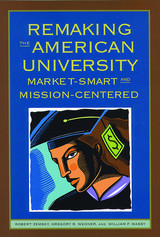 Remaking the American University: Market-Smart and Mission-Centered
Zemsky, Robert
Rutgers University Press, 2005 At one time, universities educated new generations and were a source of social change. Today colleges and universities are less places of public purpose, than agencies of personal advantage. Remaking the American University provides a penetrating analysis of the ways market forces have shaped and distorted the behaviors, purposes, and ultimately the missions of universities and colleges over the past half-century. The authors describe how a competitive preoccupation with rankings and markets published by the media spawned an admissions arms race that drains institutional resources and energies. Equally revealing are the depictions of the ways faculty distance themselves from their universities with the resulting increase in the number of administrators, which contributes substantially to institutional costs. Other chapters focus on the impact of intercollegiate athletics on educational mission, even among selective institutions; on the unforeseen result of higher education's "outsourcing" a substantial share of the scholarly publication function to for-profit interests; and on the potentially dire consequences of today's zealous investments in e-learning. A central question extends through this series of explorations: Can universities and colleges today still choose to be places of public purpose? In the answers they provide, both sobering and enlightening, the authors underscore a consistent and powerful lesson-academic institutions cannot ignore the workings of the markets. The challenge ahead is to learn how to better use those markets to achieve public purposes.
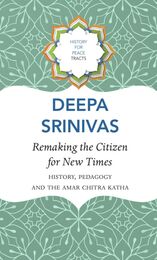 Remaking the Citizen for New Times: History, Pedagogy and the Amar Chitra Katha
Deepa Sreenivas
Seagull Books, 2024 An accessible cultural and literary critique of the right wing in India.
How does orthodoxy maintain its power over culture? In Remaking the Citizen for New Times, Deepa Sreenivas explores how the Amar Chitra Katha, a widely read comic series started in 1967 in India, influenced the historical and national consciousness of young readers in a conservative direction. Tacitly blaming Nehruvian welfarism of the time for the moral decline of the nation, the Amar Chitra Katha emerged as a literary articulation of the Indian right’s Hindu-nationalist ideology in a modern, bourgeois guise. To renew Hindutva hegemony, the comic series gave orthodox ideas a new sheen, both in its form and content, merging Western comic styles with Indian visual storytelling traditions on the one hand, and combining mythological characters with political figureheads into harmonious narratives on the other—making it difficult to sift history from myths and legends. Sreenivas deftly argues that these mythological-political tales emphasized the instructive rather than the informative potential of history, encouraging neoliberal values such as merit and hard work while ignoring caste or class as systemic issues.
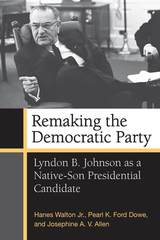 Remaking the Democratic Party: Lyndon B. Johnson as a Native-Son Presidential Candidate
Hanes Walton Jr., Pearl K. Ford Dowe, and Josephine A. V. Allen
University of Michigan Press, 2016 A continuation of Hanes Walton Jr.’s work on Southern Democratic presidents, Remaking the Democratic Party analyzes the congressional and presidential elections of Lyndon Baines Johnson. This study builds upon the general theory of the native-son phenomenon to demonstrate that a Southern native-son can win the presidency without the localism evident in the elections of Bill Clinton and Jimmy Carter.
Although ridiculed by contemporaries for his apparent lack of control over formal party politics and the national committee, Johnson excelled at leading the Democratic Party’s policy agenda. While a senator and as president, Johnson advocated for—and secured—liberal social welfare and civil rights legislation, forcing the party to break with its Southern tradition of elitism, conservatism, and white supremacy. In a way, Johnson set the terms for the continuing partisan battle because, by countering the Democrats’ new ideology, the Republican Party also underwent a transformation.
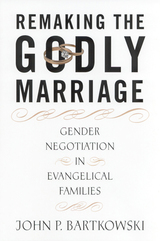 Remaking the Godly Marriage: Gender Negotiation in Evangelical Families
Bartkowski, John
Rutgers University Press, 2001 While religious leaders often have enormous influence over their members’ beliefs and how they translate their beliefs into action in everyday life, the individual family remains the place where religious values are practiced through and ultimately transferred to the next generation. As such, the family is an extremely important, though frequently overlooked, topic of study for sociologists of religion.
In Remaking the Godly Marriage, John Bartkowski studies evangelical Protestants and their views on marriage and gender relations and how they are lived within individual families. The author compares elite evangelical prescriptions for godly family living with the day-to-day practices in conservative Protestant households. He asks: How serious are the debates over gender and the family that are manifested within contemporary evangelicalism? What are the values that underlie this debate? Have these internecine disputes been altered by the emergence of new evangelical movements such as biblical feminism and the Promise Keepers? And given the fact that leading evangelicals advance competing visions of godly family life, how do conservative religious spouses make sense of their own family relationships and gender identities?
Through in-depth interviews with evangelical married couples and an exhaustive study of evangelical family advice manuals, Bartkowski explores the disputes and ambivalence concerning traditional gender roles and patriarchal models of family life, which derive from the tension between evangelical Protestantism as a religious subculture and the broader American secular culture in which it is embedded. Bartkowski reveals how evangelical men and women jointly negotiate gender roles within their families and selectively appropriate values of the larger culture even as they attempt to cope with the conflicting messages of their own faith.
Remaking the Urban Social Contract: Health, Energy, and the Environment
Edited by Michael A. Pagano
University of Illinois Press, 2016 This new volume draws from provocative discussions on the urban social contract among policy makers, researchers, public intellectuals, and citizens at the 2015 UIC Urban Forum. Michael A. Pagano presents papers that emphasize political agreements, disagreements, challenges, and controversies on health, energy, and environmental policies. Authors explore the substantive and philosophical changes in the urban social contract and offer proposals for remaking it in the new century. Topics range from big-picture analyses to specifics covering areas like public services, the smart cities movement, and greening strategies. Contributors: Alba Alexander, Megan Houston, Dennis R. Judd, Cynthia Klein-Banai, William C. Kling, Howard A. Learner, David A. McDonald, David C. Perry, Emily Stiehl, Anthony Townsend, Natalia Villamizar-Duarte, and Moira Zellner.
 Remaking Urban Heritage: Refugee Walking Tours in Berlin, Jaffa, and Tel Aviv
Michal Huss
Amsterdam University Press, 2025 This book follows the perspectives of refugee activists to examine cities shaped by layered histories of war, colonialism, and partition. Challenging the crisis-driven, state-centric frameworks that dominate migration and border studies – where refugees are often cast as passive victims or threats – the book foregrounds their agency in reimagining urban heritage. Moving beyond the edge of the state to the heritage sites of the urban sphere, Remaking Urban Heritage explores refugee-led walking tours in Berlin, Jaffa, and Tel Aviv, tracing the entangled geographies of the Middle East, Africa, and Europe. Through a participatory ‘walk-along’ ethnography grounded in artistic practice, the book reconceptualizes heritage-making as a dynamic, contested, and transcultural process. By centring refugee storytelling, performance, and spatial knowledge, it offers a critical intervention into memory, urban, and migration studies – urging scholars and practitioners to rethink the politics of belonging amid ongoing displacement and to attend to the fluidity of urban heritage.
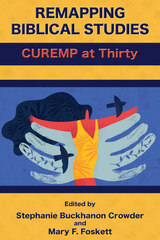 Remapping Biblical Studies: CUREMP at Thirty
Stephanie Buckhanon Crowder
SBL Press, 2023 For decades, scholars of African, African American, Asian, Asian American, Latino/a/x, and Native American heritage have employed their intellect, histories, and lived experience as a means to produce new and courageous scholarship and imagine greater in the Society of Biblical Literature. This volume celebrates the thirty years of service of SBL’s Committee on Underrepresented Racial and Ethnic Minorities in the Profession (CUREMP), a vital body in SBL dedicated to advancing the representation and work of racial and ethnic minoritized scholars in biblical studies. The volume includes the presidential addresses of groundbreaking scholars Brian K. Blount, Fernando F. Segovia, Vincent L. Wimbush, and Gale A. Yee. Gay L. Byron, Ahida Calderón Pilarski, Leslie D. Callahan, Jin Young Choi, Gregory L. Cuéllar, Jacqueline M. Hidalgo, Tat-siong Benny Liew, Velma E. Love, Andrew Mbuvi, Raj Nadella, Janette H. Ok, Angela N. Parker, Abraham Smith, Yak-hwee Tan, and Ekaputra Tupamahu provide reflections and responses that honor those who have led the way and point in new directions for future generations of scholars.
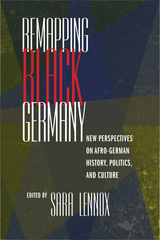 Remapping Black Germany: New Perspectives on Afro-German History, Politics, and Culture
Sara Lennox
University of Massachusetts Press, 2016 In 1984 at the Free University of Berlin, the African American poet Audre Lorde asked her Black, German-speaking women students about their identities. The women revealed that they had no common term to describe themselves and had until then lacked a way to identify their shared interests and concerns. Out of Lorde's seminar emerged both the term “Afro-German” (or “Black German”) and the 1986 publication of the volume that appeared in English translation as Showing Our Colors: Afro-German Women Speak Out. The book launched a movement that has since catalyzed activism and scholarship in Germany.
Remapping Black Germany collects thirteen pieces that consider the wide array of issues facing Black German groups and individuals across turbulent periods, spanning the German colonial period, National Socialism, divided Germany, and the enormous outpouring of Black German creativity after 1986.
In addition to the editor, the contributors include Robert Bernasconi, Tina Campt, Maria I. Diedrich, Maureen Maisha Eggers, Fatima El-Tayeb, Heide Fehrenbach, Dirk Göttsche, Felicitas Jaima, Katja Kinder, Tobias Nagl, Katharina Oguntoye, Peggy Piesche, Christian Rogowski, and Nicola Lauré al-Samarai.
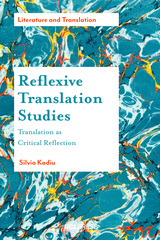 Re-Mapping Centre and Periphery: Asymmetrical Encounters in European and Global Contexts
Edited by Tessa Hauswedell, Axel Körner, and Ulrich Tiedau
University College London, 2019 Historians often assume a one-directional transmission of knowledge and ideas, leading to the establishment of spatial hierarchies defined as centers and peripheries. In recent decades, transnational and global historians have contributed to a more inclusive understanding of intellectual and cultural exchanges that profoundly challenges the ways we draw our mental maps. Covering the early modern and modern periods, Re-Mapping Centre and Periphery investigates the asymmetrical and multidirectional structure of such encounters within Europe as well as in a global context. The international team of contributors demonstrates how, as products of human agency, center and periphery are conditioned by mutual dependencies. Rather than representing absolute categories of analysis, they are subjective constructions determined by a constantly changing discursive context. Through its analysis, the volume develops and implements a conceptual framework for remapping centers and peripheries, based on conceptual history and discourse history
Remapping Emergent Islam: Texts, Social Settings, and Ideological Trajectories
Carlos A. Segovia
Amsterdam University Press, 2020 This multidisciplinary collective volume advances the scholarly discussion on the origins of Islam. It simultaneously focuses on three domains: texts, social contexts, and ideological developments relevant for the study of Islam’s beginnings -- taking the latter expression in its broadest possible sense. The intersections of these domains need to be examined afresh in order to obtain a clear picture of the concurrent phenomena that collectively enabled both the gradual emergence of a new religious identity and the progressive delimitation of its initially fuzzy boundaries.
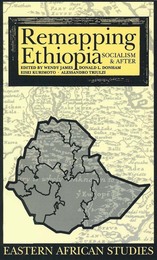 Remapping Ethiopia: Socialism & After
Wendy James
Ohio University Press, 2002 Governance everywhere is concerned with spatial relationships. Modern states “map” local communities, making them legible for the purposes of control. Ethiopia has gone through several stages of “mapping” in its imperial, revolutionary, and postrevolutionary phases. In 1986 The Southern Marches of Imperial Ethiopia, a cross-disciplinary collection edited by Don Donham and Wendy James, opened up the study of center/periphery relations in the Ethiopian empire until the fall of the monarchy in 1974. This new volume examines similar themes, taking the story forward through the major changes effected by the socialist regime from the revolution of 1974 to its overthrow in 1991, and then into the current period that has been marked by moves toward local democracy and political devolution. Topics include the changing fortunes of new and historic towns and cities, the impact of the Mengistu regime’s policies of villagization and resettlement, local aspects of the struggle against Mengistu and its aftermath, and the fate of border regions. Special attention is given to developments since 1991: to new local institutions and forms of autonomy, the links between the international diasporas of Ethiopia and the fortunes of their home areas. The collection draws on the work of established scholars as well as a new generation of Ethiopian and international researchers in the disciplines of anthropology, political science, history, and geography.
 Remapping Memory: The Politics of TimeSpace
Jonathan Boyarin, EditorAfterword by Charles Tilly
University of Minnesota Press, 1994 Remapping Memory was first published in 1994. Minnesota Archive Editions uses digital technology to make long-unavailable books once again accessible, and are published unaltered from the original University of Minnesota Press editions. The essays in this book focus on contested memories in relation to time and space. Within the context of several profound cultural and political conflicts in the contemporary world, the contributors analyze historical self-configurations of human groups, and the construction by these groups of the spaces they shape and that shape them. What emerges is a view of the state as a highly contingent artifact of groups vying for legitimacy-whether through their own sense of "insiderhood," their control of positions within hierarchies, or their control of geographical territories. Boyarin's lead essay shows how the supposedly "objective" categories of space and time are, in fact, specific products of European modernity. Each case study, in turn, addresses the (re)constitution of space, time, and memory in relation to an event either of historical significance, like the dropping of the atomic bomb on Hiroshima, or of cultural importance, like the Indian preoccupation with reincarnation. These ethnographic studies explore fundamental questions about the nature of memory, the limits of politics, and the complex links between them. By focusing on personal and collective identity as the site where constructions of memory and dimensionality are tested, shaped, and effected, the authors offer a new way of understanding how the politics of space, time and memory are negotiated to bring people to terms with their history. Contributors: Akhil Gupta, Stanford University; Charles R. Hale, University of California, Davis; Carina Perelli, PEITHO, Montevideo, Uruguay; Jennifer Schirmer, Center for European Studies, Harvard; Daniel A. Segal, Pitzer College, Claremont, California; Lisa Yoneyama, University of California, San Diego.
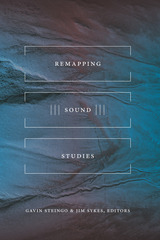 Remapping Sound Studies
Gavin Steingo and Jim Sykes, editors
Duke University Press, 2019 The contributors to Remapping Sound Studies intervene in current trends and practices in sound studies by reorienting the field toward the global South. Attending to disparate aspects of sound in Africa, South and Southeast Asia, Latin America, the Middle East, Micronesia, and a Southern outpost in the global North, this volume broadens the scope of sound studies and challenges some of the field's central presuppositions. The contributors show how approaches to and uses of technology across the global South complicate narratives of technological modernity and how sound-making and listening in diverse global settings unsettle familiar binaries of sacred/secular, private/public, human/nonhuman, male/female, and nature/culture. Exploring a wide range of sonic phenomena and practices, from birdsong in the Marshall Islands to Zulu ululation, the contributors offer diverse ways to remap and decolonize modes of thinking about and listening to sound.
Contributors
Tripta Chandola, Michele Friedner, Louise Meintjes, Jairo Moreno, Ana María Ochoa Gautier, Michael Birenbaum Quintero, Jeff Roy, Jessica Schwartz, Shayna Silverstein, Gavin Steingo, Jim Sykes, Benjamin Tausig, Hervé Tchumkam
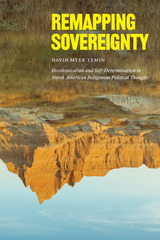 Remapping Sovereignty: Decolonization and Self-Determination in North American Indigenous Political Thought
David Myer Temin
University of Chicago Press, 2023 An examination of anticolonial thought and practice across key Indigenous thinkers. Accounts of decolonization routinely neglect Indigenous societies, yet Native communities have made unique contributions to anticolonial thought and activism. Remapping Sovereignty examines how twentieth-century Indigenous activists in North America debated questions of decolonization and self-determination, developing distinctive conceptual approaches that both resonate with and reformulate key strands in other civil rights and global decolonization movements. In contrast to decolonization projects that envisioned liberation through state sovereignty, Indigenous theorists emphasized the self-determination of peoples against sovereign state supremacy and articulated a visionary politics of decolonization as earthmaking. Temin traces the interplay between anticolonial thought and practice across key thinkers, interweaving history and textual analysis. He shows how these insights broaden the political and intellectual horizons open to us today.
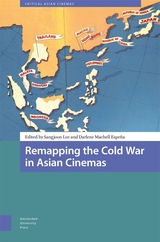 Remapping the Cold War in Asian Cinemas
Sangjoon Lee
Amsterdam University Press, 2024 This book is about cinema and the cultural Cold War in Asia, set against the larger history of the cultural, political, and institutional linkages between the US, Europe, and Asia at the height of the Cold War. From the popularity of CIA-sponsored espionage films in Hong Kong and South Korea to the enduring Cold War rhetoric of brotherly relations in contemporary Sino-Indian co-production, cinema has always been a focal point of the cultural Cold War in Asia. Historically, both the United States and the Soviet Union viewed cinema as a powerful weapon in the battle to win hearts and minds—not just in Europe, but also in Asia. The Cold War in Asia was, properly speaking, a hot war, with proxy military confrontations between the United States, on one side, and the Soviet Union and China on the other. Amid this political and military turbulence, cataclysmic shifts occurred in the culture and history of Asian cinemas as well as in the latitude of US cultural diplomacy in Asia. The collection of essays in this volume sheds light on the often-forgotten history of the cultural Cold War in Asia. Taken together, the volume’s fifteen chapters examine film cultures and industries in Asia to showcase the magnitude and depth of the Cold War’s impact on Asian cinemas, societies, and politics. By shifting the lens to Asia, the contributors to this volume re-examine the dominant narratives about the global Cold War and highlight the complex and unique ways in which Asian societies negotiated, contested, and adapted to the politics and cultural manifestations of the Cold War.
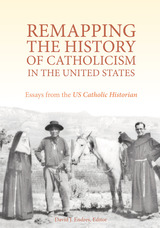 Remapping the History of Catholicism in the United States
David J. Endres
Catholic University of America Press, 2017 For more than thirty years, the U.S. Catholic Historian has mapped the diverse terrain of American Catholicism. This collection of recent essays tells the story of Catholics previously underappreciated by historians: women, African Americans, Latinos, Asian Americans, and those on the frontier and borderlands.
Timothy Matovina’s opening essay sets the theme for the volume, encouraging a remapping of U.S. Catholic history to more widely encompass its various localities and peoples, especially the significance of non-European ethnic groups and the role of Catholics in the American Southwest. Jeanne Petit explores Catholic womanhood’s strength and organizational zeal in the post-World War I era, noting the obstacles and successes of women’s attempts to be recognized fully as American citizens and members of the Church. Anne Klejment weaves together the lives of Dorothy Day and Cesar Chavez to illustrate their use of nonviolence and “weapons of the spirit” to respond to societal injustice. Amanda Bresie provides a window into the life of Mother Katharine Drexel, noting the generosity of the millionaire heiress, but also her meticulous record keeping and close supervision of her funding of educational and evangelization eorts among Native and African Americans. Kristine Ashton Gunnell analyzes the ways in which the Daughters of Charity crossed cultural boundaries to offer charitable assistance to Mexican and Japanese communities in Los Angeles. Matthew Cressler explores the intersection of Black Power and distinctive African American-inspired liturgies, arguing that the liturgy became a site of struggle as black self-determination and nationalism impacted worship and black Catholic identity. Finally, Joseph Chinnici offers an important essay on re-envisioning post-conciliar U.S. Catholicism in its global context, offering a new approach to how we consider the American Catholic narrative and write its history.
Together these path-breaking studies serve as a model for historians seeking to engage in the cartographic task of remapping the U.S. Catholic experience.
Remapping Travel Narratives, 1000-1700: To the East and Back Again
Montserrat Piera
Arc Humanities Press, 2018 With a specific focus on travel narratives, this collection looks at how various Islamic and eastern cultural threads weaved themselves, through travel and trading networks, into Western European/Christian visual culture and discourse and, ultimately, into the artistic explosion which has been labeled the "Renaissance." Scholars from across humanities disciplines examine Islamic, Jewish, Spanish, Italian, and English works from a truly comparative and non-parochial perspective, to explore the transfer through travel of cultural and religious values and artistic and scientific practices, from the eleventh to the seventeenth centuries.
A Remarkable Curiosity: Dispatches from a New York City Journalist's 1873 Railroad Trip across the American West
Jerald T. Milanich
University Press of Colorado, 2008 Collected in this volume for the first time are Cummings's portraits of a land and its assortment of characters unlike anything back East. Characters like Pedro Armijo, the New Mexican sheep tycoon who took Denver by storm, and more prominently the Mormon prophet Brigham Young and one of his wives, Ann Eliza Young, who was filing for divorce at the time of Cummings's arrival. Although today he is virtually unknown, during his lifetime Cummings was one of the most famous newspapermen in the United States, in part because of stories like these. Complete with a biographical sketch and historical introduction, A Remarkable Curiosity is an enjoyable read for anybody interested in the American West in the latter half of the nineteenth century.
 The Remarkable Life of William Beebe: Explorer and Naturalist
Carol Grant Gould
Island Press, 2004 When William Beebe needed to know what was going on in the depths of the ocean, he had himself lowered a half-mile down in a four-foot steel sphere to see-five times deeper than anyone had ever gone in the 1930s. When he wanted to trace the evolution of pheasants in 1910, he trekked on foot through the mountains and jungles of the Far East to locate every species. To decipher the complex ecology of the tropics, he studied the interactions of every creature and plant in a small area from the top down, setting the emerging field of tropical ecology into dynamic motion. William Beebe's curiosity about the natural world was insatiable, and he did nothing by halves. As the first biographer to see the letters and private journals Beebe kept from 1887 until his death in 1962, science writer Carol Grant Gould brings the life and times of this groundbreaking scientist and explorer compellingly to light. From the Galapagos Islands to the jungles of British Guiana, from the Bronx Zoo to the deep seas, Beebe's biography is a riveting adventure. A best-selling author in his own time, Beebe was a fearless explorer and thoughtful scientist who put his life on the line in pursuit of knowledge. The unique glimpses he provided into the complex web of interactions that keeps the earth alive and breathing have inspired generations of conservationists and ecologists. This exciting biography of a great naturalist brings William Beebe at last to the recognition he deserves.
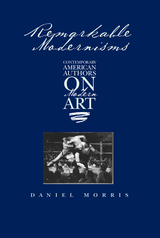 Remarkable Modernisms: Contemporary American Authors on Modern Art
Daniel Morris
University of Massachusetts Press, 2009 For the authors discussed in Remarkable Modernisms—poets John Yau, Charles Simic, and Mark Strand, and novelists Ann Beattie and Joyce Carol Oates—writing about modern art not only helps to illuminate the work of the artist but also serves as a stimulus to verbal self-portraiture. By revealing as much about their own lives and works as they do about the visual objects reviewed—pieces, for example by Jasper Johns, Andy Warhol, Joseph Cornell, Alex Katz, Edward Hopper, and George Bellows—the authors studied by Daniel Morris extend the scope of their analysis. In all five cases, writing about art becomes a critical inquiry into the nature of public acts of witnessing and private acts of seeing and not seeing.
While challenging older, rigidly formalist approaches, these authors also diverge from the strictly contextual approaches favored by many contemporary academic critics. As poets and novelists, they remain sensitive to the value of compositional techniques when they address a visual artifact, and they reject the shibboleth of "content" versus "formalist" approaches to art. They reveal that this dichotomy fails to account for the "semantics of form"— the interwoven relationship between the "how" and the "what" of a work of art. Indebted to visual art as a basis for their own compositional discoveries in words, these authors' writings on art have the effect of turning pictures into a language that extends our frame of reference beyond the flat surface of the picture plane to each author's version of contemporary society as social text.
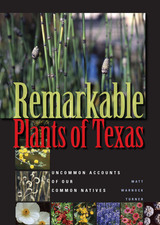 Remarkable Plants of Texas: Uncommon Accounts of Our Common Natives
By Matt Warnock Turner
University of Texas Press, 2009 With some 6,000 species of plants, Texas has extraordinary botanical wealth and diversity. Learning to identify plants is the first step in understanding their vital role in nature, and many field guides have been published for that purpose. But to fully appreciate how Texas's native plants have sustained people and animals from prehistoric times to the present, you need Remarkable Plants of Texas. In this intriguing book, Matt Warnock Turner explores the little-known facts—be they archaeological, historical, material, medicinal, culinary, or cultural—behind our familiar botanical landscape. In sixty-five entries that cover over eighty of our most common native plants from trees, shrubs, and wildflowers to grasses, cacti, vines, and aquatics, he traces our vast array of connections with plants. Turner looks at how people have used plants for food, shelter, medicine, and economic subsistence; how plants have figured in the historical record and in Texas folklore; how plants nourish wildlife; and how some plants have unusual ecological or biological characteristics. Illustrated with over one hundred color photos and organized for easy reference, Remarkable Plants of Texas can function as a guide to individual species as well as an enjoyable natural history of our most fascinating native plants.
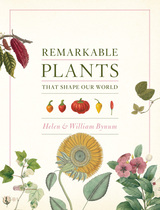 Remarkable Plants That Shape Our World
Helen Bynum and William Bynum
University of Chicago Press, 2014 Imagine a typical morning--munching on a bowl of cereal, sipping coffee, dressing for the day, riding to work. Every moment of this common routine draws on the power of plants, and the centuries of development that brought wheat, coffee beans, cotton, and rubber--among many others--into our daily lives.
Remarkable Plants celebrates the wonder and utility of the green kingdom, taking a detailed look at how plants have shaped our world. It focuses on eighty key species and richly explores their history, highlighting their importance and bringing to light surprising stories. Organized thematically into eight sections, the book starts with “Transformers” (including rice, beans, olives) and moves through sections such as “Heal and Harm” (poppy, aloe, strychnos) and “Revered and Adored” (lotus, frankincense, rose). Each species is introduced with its common and scientific names and followed by an exploration of its cultural, historical, botanical, and symbolic associations. Hundreds of botanical illustrations show full plants as well as highlight distinctive leaves, blooms, and fruits.
Rooted in one of the world’s most important and renowned temples of greenery, the Royal Botanic Gardens, Kew, Remarkable Plants is a symbiotic balance of science and art that will open readers’ eyes to the deep influence of the natural world on our modern one.
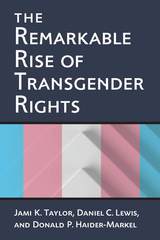 The Remarkable Rise of Transgender Rights
Jami K. Taylor, Daniel C. Lewis, and Donald P. Haider-Markel
University of Michigan Press, 2018 While medical identification and treatment of gender dysphoria have existed for decades, the development of transgender as a “collective political identity” is a recent construct. Over the past twenty-five years, the transgender movement has gained statutory nondiscrimination protections at the state and local levels, hate crimes protections in a number of states, inclusion in a federal law against hate crimes, legal victories in the courts, and increasingly favorable policies in bureaucracies at all levels. It has achieved these victories despite the relatively small number of trans people and despite the widespread discrimination, poverty, and violence experienced by many in the transgender community. This is a remarkable achievement in a political system where public policy often favors those with important resources that the transgender community lacks: access, money, and voters. The Remarkable Rise of Transgender Rights explains the growth of the transgender rights movement despite its marginalized status within the current political opportunity structure.
 Remarkable Trees
Christina Harrison and Tony Kirkham
University of Chicago Press, 2019 Throughout our history trees have been central to our existence. They provide us with vital ingredients for life—food, medicine, materials, even the oxygen we breathe. Ecologically, they are crucial in controlling pollution and moderating the climate, and culturally they are important to our religions, folklore and art. It has also been shown that as well as greening our lives they can improve our health and mental well-being.
Remarkable Trees tells the unique story of more than sixty species, each selected for its resonance and connection with people. In portraits that combine vivid cultural and historical narrative with a firm scientific grounding, Christina Harrison and Tony Kirkham reveal fascinating details of trees from the world’s major environmental zones and habitats. Some are obvious superstars such as oaks, redwoods and coconut, while others are more surprising: we learn of the monkey puzzle, a tree native to Chile that “can grow for 1,000 years,” and of the manchineel, a tree that contains sap so toxic to human skin that it’s a risk to stand beneath it on a rainy day. In these pages are trees that are healers and killers, trees that serve as foundations of great buildings and grand feasts, and trees that leave us with a sense of wonder and of worry for their survival.
In a tribute to the artists and botanists who have been inspired by trees for centuries, this book is filled with 240 delightful illustrations. The varied and beautiful images come from the unrivalled archive at the Royal Botanic Gardens, Kew, and they bring this enlightening and enchanting volume to life.
While trees have supported us for millennia, we have recently lost that direct, deep connection with them. Harrison and Kirkham remind us that we do not have to look far to reestablish that relationship and that we can still cherish the splendor and significance of these quiet giants.
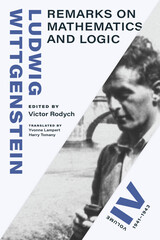 Remarks on Mathematics and Logic: Volume IV, 1941–1943
Ludwig Wittgenstein
University of Chicago Press The first of five planned volumes, this book collects Wittgenstein’s unabridged writings on mathematics and logic composed between 1941 and 1943.
In 1956, a significant but abridged portion of Ludwig Wittgenstein’s 1937–1944 writings for a continuation of what became Philosophical Investigations was published as Remarks on the Foundations of Mathematics. Now, in the five German-English facing pages volumes of Remarks on Mathematics and Logic, these writings are presented in full as Wittgenstein wrote them: in chronological order, without editorial omissions, selections, or rearrangements.
Volume IV contains materials from 1941 to 1943, including one previously unpublished manuscript and three manuscripts from which selections were made for the previous abridgment. The topics covered in this volume include the philosophy of mathematics, mathematical foundationalism, surveyability in mathematics, language-games and proof-networks, Gödelian undecidability, pictures in mathematics, Cantorian diagonal proofs, applied mathematics without pure mathematics, and mathematics and chess, among others.
This German-English facing pages edition presents Wittgenstein’s writings in their original context—as Wittgenstein wrote them, in chronological order, and without editorial omissions, selections, or rearrangements.
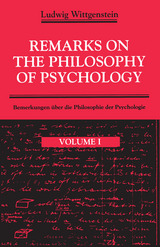 Remarks on the Philosophy of Psychology, Volume 1
Ludwig Wittgenstein
University of Chicago Press, 1980 Wittgenstein finished part 1 of the Philosophical Investigations in the spring of 1945. From 1946 to 1949 he worked on the philosophy of psychology almost without interruption. The present two-volume work comprises many of his writings over this period. Some of the remarks contained here were culled for part 2 of the Investigations; others were set aside and appear in the collection known as Zettel. The great majority, however, although of excellent quality, have hitherto remained unpublished.
This bilingual edition of the Remarks on the Philosophy of Psychology presents the first English translation of an essential body of Wittegenstein's work. It elaborates Wittgenstein's views on psychological concepts such as expectation, sensation, knowing how to follow a rule, and knowledge of the sensations of other persons. It also shows strong emphasis on the "anthropological" aspect of Wittgenstein's thought. Philosophers, as well as anthropologists, psychologists, and sociologists will welcome this important publication.
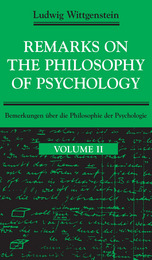 Remarks on the Philosophy of Psychology, Volume 2
Ludwig Wittgenstein
University of Chicago Press, 1980 Wittgenstein finished part 1 of the Philosophical Investigations in the spring of 1945. From 1946 to 1949 he worked on the philosophy of psychology almost without interruption. The present two-volume work comprises many of his writings over this period. Some of the remarks contained here were culled for part 2 of the Investigations; others were set aside and appear in the collection known as Zettel. The great majority, however, although of excellent quality, have hitherto remained unpublished.
This bilingual edition of the Remarks on the Philosophy of Psychology presents the first English translation of an essential body of Wittgenstein's work. It elaborates Wittgenstein's views on psychological concepts such as expectation, sensation, knowing how to follow a rule, and knowledge of the sensations of other persons. It also shows strong emphasis on the "anthropological" aspect of Wittgenstein's thought. Philosophers, as well as anthropologists, psychologists, and sociologists will welcome this important publication.
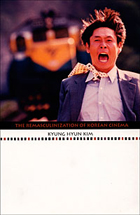 The Remasculinization of Korean Cinema
Kyung Hyun Kim
Duke University Press, 2004 In one of the first English-language studies of Korean cinema to date, Kyung Hyun Kim shows how the New Korean Cinema of the past quarter century has used the trope of masculinity to mirror the profound sociopolitical changes in the country. Since 1980, South Korea has transformed from an insular, authoritarian culture into a democratic and cosmopolitan society. The transition has fueled anxiety about male identity, and amid this tension, empowerment has been imagined as remasculinization. Kim argues that the brutality and violence ubiquitous in many Korean films is symptomatic of Korea’s on-going quest for modernity and a post-authoritarian identity. Kim offers in-depth examinations of more than a dozen of the most representative films produced in Korea since 1980. In the process, he draws on the theories of Jacques Lacan, Slavoj Zizek, Gilles Deleuze, Rey Chow, and Kaja Silverman to follow the historical trajectory of screen representations of Korean men from self-loathing beings who desire to be controlled to subjects who are not only self-sufficient but also capable of destroying others. He discusses a range of movies from art-house films including To the Starry Island (1993) and The Day a Pig Fell into the Well (1996) to higher-grossing, popular films like Whale Hunting (1984) and Shiri (1999). He considers the work of several Korean auteurs—Park Kwang-su, Jang Sun-woo, and Hong Sang-su. Kim argues that Korean cinema must begin to imagine gender relations that defy the contradictions of sexual repression in order to move beyond such binary struggles as those between the traditional and the modern, or the traumatic and the post-traumatic.
Rembrandt
Jakob Rosenberg
Harvard University Press
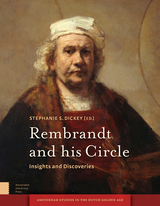 Rembrandt and his Circle: Insights and Discoveries
Edited by Stephanie S. Dickey
Amsterdam University Press, 2017 This collection brings together art historians, museum professionals, conservators, and conservation scientists whose work involves Rembrandt van Rijn and associated artists such as Gerrit Dou, Jan Lievens, and Ferdinand Bol. The range of subjects considered is wide: from the presentation of convincing evidence that Rembrandt and his contemporary Frans Hals rubbed elbows in the Amsterdam workshop of Hendrick Uylenburgh to critical reassessments of the role of printmaking in Rembrandt's studio, his competition with Lievens as a landscape painter, his reputation as a collector, and much more. Developed from a series of international conferences devoted to charting new directions in Rembrandt research, these essays illuminate the current state of Rembrandt studies and suggest avenues for future inquiry.
"Skilfully chosen and edited by Stephanie Dickey, these papers were presented at the highly successful conferences on Rembrandt and his pupils held at Herstmonceaux Castle in recent years. This is cutting-edge Rembrandt scholarship full of valuable insights and new discoveries." -- Christopher Brown, Professor of Netherlandish Art, University of Oxford
"[This book] contains a wealth of fresh and lucidly argued insights, not only into Rembrandt's art, thinking and practice: notably, a significant place is reserved for such artists as Jan Lievens, Ferdinand Bol, Gerrit Dou, Johannes van Vliet and, unexpectedly, Frans Hals. In these thoughtful reflections on the artist and his milieu, the reader will find many generally accepted notions critically revised." - Eric Jan Sluijter, emeritus professor of Art History at the University of Amsterdam
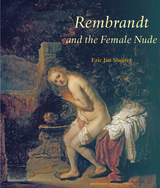 Rembrandt and the Female Nude
Eric van Sluijter
Amsterdam University Press, 2007 Rembrandt’s extraordinary paintings of female nudes—Andromeda,Susanna, Diana and her Nymphs, Danaë, Bathsheba—as well as his etchings of nude women, have fascinated many generations of art lovers and art historians. But they also elicited vehement criticism when first shown, described as against-the-grain, anticlassical—even ugly and unpleasant. However, Rembrandt chose conventional subjects, kept close to time-honored pictorial schemes, and was well aware of the high prestige accorded to the depiction of the naked female body. Why, then, do these works deviate so radically from the depictions of nude women by other artists? To answer this question Eric Jan Sluijter, in Rembrandt and the Female Nude, examines Rembrandt’s paintings and etchings against the background of established pictorial traditions in the Netherlands and Italy. Exploring Rembrandt’s intense dialogue with the works of predecessors and peers, Sluijter demonstrates that, more than any other artist, Rembrandt set out to incite the greatest possible empathy in the viewer, an approach that had far-reaching consequences for the moral and erotic implications of the subjects Rembrandt chose to depict.
In this richly illustrated study, Sluijter presents an innovative approach to Rembrandt’s views on the art of painting, his attitude towards antiquity and Italian art of the Renaissance, his sustained rivalry with the works of other artists, his handling of the moral and erotic issues inherent in subjects with female nudes, and the nature of his artistic choices.
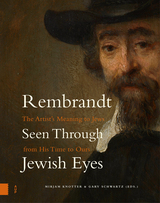 Rembrandt Seen Through Jewish Eyes: The Artist’s Meaning to Jews from His Time to Ours
Mirjam Knotter
Amsterdam University Press, 2024 The earliest painting by Rembrandt whose owner is documented depicts the prophet Balaam, on his way to blessing Israel. The man who bought it was a Sephardi Jew in the service of Cardinal Richelieu of France. The first known buyer of an etching plate by Rembrandt, depicting Abraham Dismissing Hagar and Ishmael, was a Sephardi Jew of Amsterdam. Seen through their eyes, Rembrandt was the creator of images with a special meaning to Jews. They have been followed through the centuries by Jewish collectors, Jewish art historians, Jewish artists who saw their own deepest concerns modelled in his art and life, and even prominent rabbis, one of whom said that Rembrandt was a Tzadik, a holy man blessed by God.
This book is the first study in depth of the potent bond between Rembrandt and Jews, from his time to ours, a bond that has penetrated the image of the artist and the people alike.
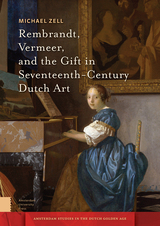 Rembrandt, Vermeer, and the Gift in Seventeenth-Century Dutch Art
Michael Zell
Amsterdam University Press, 2021 Rembrandt, Vermeer, and the Gift in Seventeenth-Century Dutch Art offers a new perspective on the art of the Dutch Golden Age by exploring the interaction between the gift's symbolic economy of reciprocity and obligation and the artistic culture of early modern Holland. Gifts of art were pervasive in seventeenth-century Europe, and many Dutch artists, like their counterparts elsewhere, embraced gift giving to cultivate relations with patrons, art lovers, and other members of their social networks. Rembrandt also created distinctive works to function within a context of gift exchange, and both Rembrandt and Vermeer engaged the ethics of the gift to identify their creative labor as motivated by what contemporaries called a "love of art," not materialistic gain. In the merchant republic’s vibrant market for art, networks of gift relations and the anti-economic rhetoric of the gift mingled with the growing dimension of commerce, revealing a unique chapter in the interconnected history of gift giving and art making.
Rembrandt's Enterprise: The Studio and the Market
Svetlana Alpers
University of Chicago Press, 1990 "Singularly interesting and stimulating. . . . A passionate and original work of scholarship."—Richard Wollheim, Times Literary Supplement
"With the publication [of Rembrandt's Enterprise], Svetlana Alpers has firmly established herself in the front ranks of art historians at work today. . . . The book is not a long one. Yet, there is more perceptive scholarship packed into its four chapters than is typically found in a whole shelf of the more common outpourings of academic writers. Rembrandt's Enterprise is less a book of archival discoveries than of fresh interpretation of the revered artist and his milieu. . . . Alpers makes us see how Rembrandt's complex and enormously popular art has embedded itself in our ways of thinking about who we are and how we live, even in the late 20th century."—Christopher Knight, Los Angeles Herald Examiner
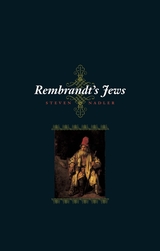 Rembrandt's Jews
Steven Nadler
University of Chicago Press, 2004 There is a popular and romantic myth about Rembrandt and the Jewish people. One of history's greatest artists, we are often told, had a special affinity for Judaism. With so many of Rembrandt's works devoted to stories of the Hebrew Bible, and with his apparent penchant for Jewish themes and the sympathetic portrayal of Jewish faces, it is no wonder that the myth has endured for centuries.
Rembrandt's Jews puts this myth to the test as it examines both the legend and the reality of Rembrandt's relationship to Jews and Judaism. In his elegantly written and engrossing tour of Jewish Amsterdam—which begins in 1653 as workers are repairing Rembrandt's Portuguese-Jewish neighbor's house and completely disrupting the artist's life and livelihood—Steven Nadler tells us the stories of the artist's portraits of Jewish sitters, of his mundane and often contentious dealings with his neighbors in the Jewish quarter of Amsterdam, and of the tolerant setting that city provided for Sephardic and Ashkenazic Jews fleeing persecution in other parts of Europe. As Nadler shows, Rembrandt was only one of a number of prominent seventeenth-century Dutch painters and draftsmen who found inspiration in Jewish subjects. Looking at other artists, such as the landscape painter Jacob van Ruisdael and Emmanuel de Witte, a celebrated painter of architectural interiors, Nadler is able to build a deep and complex account of the remarkable relationship between Dutch and Jewish cultures in the period, evidenced in the dispassionate, even ordinary ways in which Jews and their religion are represented—far from the demonization and grotesque caricatures, the iconography of the outsider, so often found in depictions of Jews during the Middle Ages and the Renaissance.
Through his close look at paintings, etchings, and drawings; in his discussion of intellectual and social life during the Dutch Golden Age; and even through his own travels in pursuit of his subject, Nadler takes the reader through Jewish Amsterdam then and now—a trip that, under ever-threatening Dutch skies, is full of colorful and eccentric personalities, fiery debates, and magnificent art.
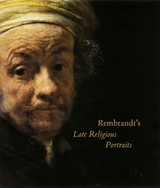 Rembrandt's Late Religious Portraits
Arthur K. Wheelock Jr.
University of Chicago Press, 2005 One of the most fascinating aspects of Rembrandt's extraordinary artistic career is his suite of brooding half-length portraits of religious figures from the late 1650s and early 1660s. Painted during a difficult time in the artist's life—when he no longer enjoyed a ready market for his works and may have turned to his deep religious convictions for solace—these images are among the most evocative Rembrandt created. For years scholars have debated whether these paintings were intended as a series, yet until now these works have, unbelievably, never been shown together.
An exhibition by the National Gallery of Art and this accompanying catalog assemble seventeen of the paintings for the first time, finally giving the powerful images their due. Many of these subtle and wondrous paintings have been identified as images of apostles and evangelists, but among them are also representations of Christ, the Virgin, and still-unidentified saints and monks. In Rembrandt's typical fashion, the men and women in these portraits peer out of the dark recesses of dimly lit interiors as though burdened by the weight of their spiritual and emotional concerns. Yet recent archival research has raised questions about their attribution, the relationships among the paintings, and, in a broader sense, Rembrandt's life and career—issues addressed by the contributors to this volume. With its lavish color images and state-of-the-field research, Rembrandt's Late Religious Portraits will make a profound contribution to the understanding of this unique and provocative body of work.
Rembrandt's Reading: The Artist's Bookshelf of Ancient Poetry and History
Amy Golahny
Amsterdam University Press, 2003 Although Rembrandt's study of the Bible has long been recognized as intense, his interest in secular literature has been relatively neglected. Yet Philips Angel (1641) praised Rembrandt for "diligently seeking out the knowledge of histories from old musty books." Amy Golahny elaborates on this observation, reconstructing Rembrandt's library on the evidence of the 1656 inventory and discerning anew how Rembrandt's reading of histories contributed to his creative process. Golahny places Rembrandt in the learned vernacular culture of seventeenth-century Holland and shows the painter to have been a pragmatic reader whose attention to historical texts strengthened his early rivalry with Rubens for visual drama and narrative erudition.
Remediating McLuhan
Richard Cavell
Amsterdam University Press, 2016 While current scholarly interest has assured McLuhan's foundational status as media theorist, it has by no means exhausted the import of his writings, which take on additional layers in the current digital moment. This collection of essays argues that it was McLuhan's confrontation of the bios that was the distinguishing feature of his media theory and the source of its most consistent problematic. Holding that media were extensions of the human, McLuhan also posited that the human was a product of technology. Remediating McLuhan ranges over media theory, art history, bio-technology and deep history in addressing this problematic, and discusses McLuhan in the context of Flusser and Turing, Carl Woese and Daniel Lord Smail.
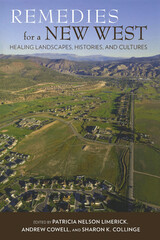 Remedies for a New West: Healing Landscapes, Histories, and Cultures
Edited by Patricia Nelson Limerick, Andrew Cowell, and Sharon K. Collinge
University of Arizona Press, 2009 This wide-ranging collection of essays is intended to provoke both thought and action. The pieces collected here explore a variety of issues facing the American West—disappearing Native American languages, deteriorating air quality, suburban sprawl, species loss, grassland degradation, and many others—and suggest steps toward “healing.” More than “dealing with” or “solving,” according to the editors, healing addresses not just symptoms but their underlying causes, offering not just a temporary cure but a permanent one.
The signs of illness and trauma can seem omnipresent in today’s West: land and soil disrupted from mining, overgrazing, logging, and farming; wildlife habitat reduced and fragmented; native societies disturbed and threatened; open space diminished by cities and suburbs; wilderness destroyed by roads and recreation-seekers. But as these essays suggest, the “treatment program” for healing the West has many healthful side effects. Engaging in the kinds of projects suggested by contributors is therapeutic not only for the environment but for participants as well. Restoration, repair, and recovery can counter symptoms of despair with concentrated doses of promise and possibility.
The more “lesions” the West has, this book suggests, the more opportunities there are for westerners to revive and ultimately cure the ailing patient they have helped to create. The very idea of restoring the West to health, contributors and editors contend, unleashes our imaginations, sharpens our minds, and gives meaning to the ways we choose to live our lives. At the same time, acknowledging the profound difficulties of the work that lies ahead immunizes us against our own arrogance as we set about the task of healing the West.
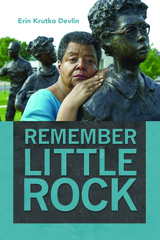 Remember Little Rock
Erin Krutko Devlin
University of Massachusetts Press, 2017 In Remember Little Rock Erin Krutko Devlin explores public memories surrounding the iconic Arkansas school desegregation crisis of 1957 and shows how these memories were vigorously contested and sometimes deployed against the cause. Delving into a wide variety of sources, from memoirs to televised docudramas, commemoration ceremonies, and the creation of Little Rock High museums, Devlin reveals how many white moderates proclaimed Little Rock a victory for civil rights and educational equality even as segregation persisted. At the same time, African American activists, students, and their families asserted their own stories in the ongoing fight for racial justice.
Devlin also demonstrates that public memory directly bears on law and policy. She argues that the triumphal narrative of civil rights has been used to stall school desegregation, support tokenism, and to roll back federal court oversight of school desegregation, voter registration, and efforts to promote diversity in public institutions. Remember Little Rock examines the chasm between the rhetoric of the "post–civil rights" era and the reality of enduring racial inequality.
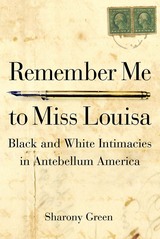 Remember Me to Miss Louisa: Hidden Black-White Intimacies in Antebellum America
Sharony Green
Northern Illinois University Press, 2015 It is generally recognized that antebellum interracial relationships were “notorious” at the neighborhood level. But we have yet to fully uncover the complexities of such relationships, especially from freedwomen’s and children’s points of view. While it is known that Cincinnati had the largest per capita population of mixed race people outside the South during the antebellum period, historians have yet to explore how geography played a central role in this outcome. The Mississippi and Ohio Rivers made it possible for Southern white men to ferry women and children of color for whom they had some measure of concern to free soil with relative ease.
Some of the women in question appear to have been “fancy girls,” enslaved women sold for use as prostitutes or “mistresses.” Green focuses on women who appear to have been the latter, recognizing the problems with the term “mistress,” given its shifting meaning even during the antebellum period. Remember Me to Miss Louisa, among other things, moves the life of the fancy girl from New Orleans, where it is typically situated, to the Midwest. The manumission of these women and their children—and other enslaved women never sold under this brand—occurred as America’s frontiers pushed westward, and urban life followed in their wake. Indeed, Green’s research examines the tensions between the urban Midwest and the rising Cotton Kingdom. It does so by relying on surviving letters, among them those from an ex-slave mistress who sent
her “love” to her former master. This relationship forms the crux of the first of three case studies. The other two concern a New Orleans young woman who was the mistress of an aging white man, and ten Alabama children who received from a white planter a $200,000 inheritance (worth roughly $5.1 million in today’s currency). In each case, those freed people faced the challenges characteristic of black life in a largely hostile America.
While the frequency with which Southern white men freed enslaved women and their children is now generally known, less is known about these men’s financial and emotional investments in them. Before the Civil War, a white Southern man’s pending marriage, aging body, or looming death often compelled him to free an African American woman and their children. And as difficult as it may be for the modern mind to comprehend, some kind of connection sometimes existed between these individuals. This study argues that such men—though they hardly stand excused for their ongoing claims to privilege—were hidden actors in freedwomen’s and children’s attempts to survive the rigors and challenges of life as African Americans in the years surrounding the Civil War. Green examines many facets of this phenomenon in the hope of revealing new insights about the era of slavery.
Historians, students, and general readers of US history, African American studies, black urban history, and antebellum history will find much of interest in this fascinating study.
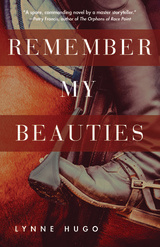 Remember My Beauties
Lynne Hugo
Northern Illinois University Press, 2016 Imagine a hawk’s view of the magnificent bluegrass pastures of Kentucky horse country. Circle around the remnants of a breeding farm, four beautiful horses grazing just beyond the paddock. Inside the ramshackle house, a family is falling apart.
Hack, the patriarch breeder and trainer, is aged and blind, and his wife, Louetta, is confined by rheumatoid arthritis. Their daughter, Jewel, struggles to care for them and the horses while dealing with her own home and job—not to mention her lackluster second husband, Eddie, and Carley, her drug-addicted daughter. Many days, Jewel is only sure she loves the horses. But she holds it all together. Until her brother, Cal, shows up again. Jewel already has reason to hate Cal, and when he meets up with Carley, he throws the family into crisis—and gives Jewel reason to pick up a gun.
Every family has heartbreaks, failures, a black sheep or two. And some families end in tatters. But some stumble on the secret of survival: if the leader breaks down, others step up and step in. In this lyrical novel, when the inept, the addict, and the ex-con join to weave the family story back together, either the barn will burn to the ground or something bigger than any of them will emerge, shining with hope. Remember My Beauties grows large and wide as it reveals what may save us.
For more information, visit: http://www.lynnehugo.com/books/novels/remember-my-beauties/
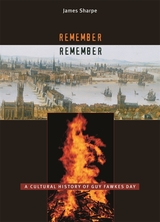 Remember, Remember: A Cultural History of Guy Fawkes Day
James Sharpe
Harvard University Press, 2005 In the early hours of November 5, 1605, Guy Fawkes, an English Catholic who had served with the Spanish army in Flanders, was discovered in a storeroom under the Palace of Westminster—and with him, thirty-six barrels of gunpowder earmarked to obliterate England’s royal family, top officials, and members of Parliament gathered for Parliament’s opening day. Had it succeeded, this Gunpowder Plot—a Catholic conspiracy against the recently crowned Protestant King James I and his government—English history would have been shaped by a terrorist act of unprecedented proportions.
Today Guy Fawkes—whose name has long stood for the conspiracy—is among the most notorious figures in English history; and Bonfire Night, observed every November 5th to memorialize the narrowly foiled Gunpowder Plot, is one of the country’s most festive occasions. Why has the memory of this act of treason and terrorism persisted for 400 years? In Remember, Remember James Sharpe takes us back to 1605 and teases apart the tangled web of religion and politics that gave rise to the plot. And, with considerable wit, he shows how celebration of that fateful night, and the representation of Guy Fawkes, has changed over the centuries.
James Sharpe’s colorfully told story has wide implications. The plot of 1605 has powerful resonances today, in a time of heightened concern about ideological conflict, religious fanaticism, and terrorism. And his account of the festivities marking the momentous event comments on the role of rituals in constructing national histories.
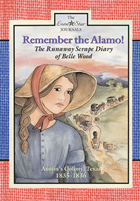 Remember the Alamo!: The Runaway Scrape Diary of Belle Wood, Austin's Colony, 1835–1836
Lisa Waller Rogers
Texas Tech University Press, 2003 Late in 1835, the Mexican army surrendered San Antonio and retreated across the Rio Grande. Texas colonists, including young Belle Wood, rejoiced. No one expected more trouble from Mexico. So when Belle’s brother, Mac, followed Colonel Travis to the Alamo in January as “a precautionary measure,” Belle didn’t worry.
Three weeks later, General Santa Anna reentered San Antonio with thousands of troops, taking the 150 doomed Alamo men by surprise. “The news came upon me like a clap of thunder,” Belle wrote. “My brother, Mac, is dead.”
As Santa Anna marched eastward, panic ensued. All over Texas, people either joined the fight for independence or fled for safety in the mass exodus known as the Runaway Scrape. Belle tells how her family joins the throng pushing to the U.S. border on foot or in every kind of vehicle imaginable. Theirs is a perilous, tragic journey in rain and cold, across sodden prairies and deep mud.
Despite all their trials and difficulties, however, the Texians push on, and throughout Belle’s diary runs the story of a proud people determined to save their families from the ravages of war and to rebuild their homes in this new nation—
Texas.
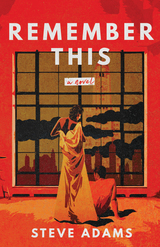 Remember This
Steve Adams
University of Wisconsin Press, 2022 John Martin, a talented graphic designer employed as a word processor for a prestigious New York investment bank, has happily left behind Texas and his alcoholic, emotionally absent mother. It is the height of the personal computer revolution and the AIDS epidemic, and gentrification is sweeping the city. Alena Marino, John’s supervisor, is an Italian immigrant who shares his hustle and grit, aggressively building a new life for herself. As their affair begins, John imagines himself the perfect lover for Alena, fulfilling her desires without expectation that she leave her husband. But when his oldest sister arrives in town unannounced, he is forced to confront his damaged past and serial history of relationships with stunningly gorgeous, emotionally complex women.
John’s journey to understand the roots of his compulsion to “save” those around him is both aided and thwarted by his relationship with his colleague Jeremy Crawford. Alena’s closest confidant, Jeremy shares an intimacy with her that fuels John's jealousy. Meanwhile, Jeremy finds himself drawn to John and, as his confidant too, participates in the drama of John and Alena’s relationship. As John slowly begins to understand the flawed and wounded experience of love that has followed him through life, he learns how to open himself to true friendship—and to true loss. Set in the midst of cultural upheaval, this powerful novel reverberates across the decades.
 Remember This: The Lesson of Jan Karski
Clark Young and Derek Goldman. With Madeleine Albright, Stuart Eizenstat, Aminatta Forna, Azar Nafisi, Leo J. O'Donovan, Samantha Power, Cynthia Schneider, Timothy Snyder, David Strathairn, and Deborah Tannen
Georgetown University Press, 2023 A powerful remembrance of the lessons and legacy of Jan Karski, who risked his life to share the truth with the world—and a cautionary tale for our times. Richly illustrated with stills from the black-and-white film adaptation of the acclaimed stage play, Remember This: The Lesson of Jan Karski tells the story of World War II hero, Holocaust witness, and Georgetown University professor Jan Karski.
A messenger of truth, Karski risked his life to carry his harrowing reports of the Holocaust from war-torn Poland to the Allied nations and, ultimately, the Oval Office, only to be ignored and disbelieved. Despite the West's unwillingness to act, Karski continued to tell others about the atrocities he saw, and, after a period of silence, would do so for the remainder of his life. This play carries forward his legacy of bearing witness so that future generations might be inspired to follow his example and "shake the conscience of the world." Accompanying the text of the stage play in this volume are essays and conversations from leading diplomats, thinkers, artists, and writers who reckon with Karski's legacy, including Secretary of State Madeleine Albright, Ambassador Stuart Eizenstat, award-winning author Aminatta Forna, best-selling author Azar Nafisi, President Emeritus of Georgetown Leo J. O'Donovan, SJ, Ambassador Samantha Power, Ambassador Cynthia P. Schneider, historian Timothy Snyder, Academy Award nominated actor David Strathairn, and best-selling author Deborah Tannen.
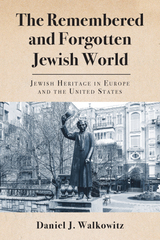 The Remembered and Forgotten Jewish World: Jewish Heritage in Europe and the United States
Daniel J. Walkowitz
Rutgers University Press, 2018 In the late nineteenth and early twentieth centuries, the Jewish socialist movement played a vital role in protecting workers’ rights throughout Europe and the Americas. Yet few traces of this movement or its accomplishments have been preserved or memorialized in Jewish heritage sites.
The Remembered and Forgotten Jewish World investigates the politics of heritage tourism and collective memory. In an account that is part travelogue, part social history, and part family saga, acclaimed historian Daniel J. Walkowitz visits key Jewish museums and heritage sites from Berlin to Belgrade, from Krakow to Kiev, and from Warsaw to New York, to discover which stories of the Jewish experience are told and which are silenced. As he travels to thirteen different locations, participates in tours, displays, and public programs, and gleans insight from local historians, he juxtaposes the historical record with the stories presented in heritage tourism. What he finds raises provocative questions about the heritage tourism industry and its role in determining how we perceive Jewish history and identity. This book offers a unique perspective on the importance of collective memory and the dangers of collective forgetting.
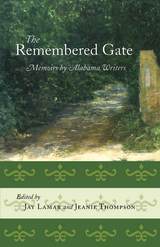 The Remembered Gate: Memoirs by Alabama Writers
Jay Lamar
University of Alabama Press, 2002 Showcases nineteen nationally known writers who have roots in Alabama
In The Remembered Gate, nationally prominent fiction writers, essayists, and poets recall how their formative years in Alabama shaped them as people and as writers. The essays range in tone from the pained and sorrowful to the wistful and playful, in class from the privileged to the poverty-stricken, in geography from the rural to the urban, and in time from the first years of the 20th century to the height of the Civil Rights era and beyond.
In all the essays we see how the individual artists came to understand something central about themselves and their art from a changing Alabama landscape. Whether from the perspective of C. Eric Lincoln, beaten for his presumption as a young black man asking for pay for his labors, or of Judith Hillman Paterson, floundering in her unresolved relationship with her troubled family, these personal renderings are intensely realized visions of a writer's sense of being a writer and a human being. Robert Inman tells of exploring his grandmother's attic, and how the artifacts he found there fired his literary imagination. William Cobb profiles the lasting influence of the town bully, the diabolical Cletus Hickey. And in “Growing up in Alabama: A Meal in Four Courses, Beginning with Dessert,” Charles Gaines chronicles his upbringing through the metaphor of southern cooking.
What emerges overall is a complex, richly textured portrait of men and women struggling with, and within, Alabama’s economic and cultural evolution to become major voices of our time.
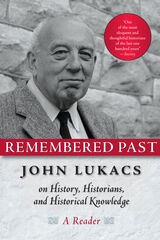 Remembered Past: John Lukacs On History Historians & Historical Knowledg
John Lukacs
Intercollegiate Studies Institute, 2005 Among the most accomplished historians of his generation, John Lukacs has written more than twenty books and hundreds of essays and reviews. His scholarship encompasses the history of the modern age, focusing especially on the political, ideological, intellectual, and military struggles of the twentieth century. Integral to that project has been Lukacs's effort to clarify and interpret the evolution of thought and consciousness during the approximately 500 years that constitute "modern" history. As the modern age passes, as the institutions, ideas, values, and experiences that composed the life of the era recede and disappear, Lukacs has assumed the responsibility to "think about thinking." And for Lukacs, no aspect of thought is more important to understanding the modern age than the emergence of historical consciousness. Remembered Past: John Lukacs on History, Historians, and Historical Knowledge: A Reader draws together Lukacs's scattered and diverse writings on history. The volume serves at once as an introduction to this essential aspect of Lukacs's thought and an indispensable compendium of his most important writings on the subject. In the essays, reviews, commentaries, and book chapters collected in Remembered Past, Lukacs addresses the problem of historical knowledge, evaluates the contributions of historians and writers who have used, and often abused, history, and examines the significance of place in developing a sense of the past. He concludes with a consideration of the twentieth century and the task of reading, writing, and teaching history. Significantly, this authorized "reader" also includes a complete bibliography of Lukacs?s writings through 2003.
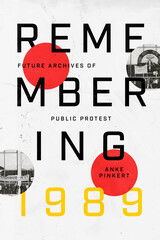 Remembering 1989: Future Archives of Public Protest
Anke Pinkert
University of Chicago Press, 2024 This account of the “laboratory of radical democracy” in the months before East Germany’s absorption in the West challenges memories of Germany’s reunification.
For many, 1989 is an iconic date, one we associate with the fall of the Berlin Wall and the end of the Cold War. The year prompts some to rue the defeat of socialism in the East, while others celebrate a victory for democracy and capitalism in the reunified Germany. Remembering 1989 focuses on a largely forgotten interregnum: the months between the outbreak of protests in the German Democratic Republic in 1989 and its absorption by the West in 1990. Anke Pinkert, who herself participated in those protests, recalls these months as a volatile but joyous “laboratory of radical democracy,” and tells the story of how and why this “time out of joint” has been erased from Germany’s national memory.
Remembering 1989 argues that in order to truly understand Germany’s historic transformation, we must revisit protesters’ actions across a wide range of minor, vernacular, and often transient sources. Drawing on rich archives including videotapes of untelevised protests, illegally printed petitions by Church leaders, audio recordings of dissident meetings, and interview footage with military troops, Pinkert opens the discarded history of East European social uprisings to new interpretations and imagines alternatives to Germany’s neoliberal status quo. The result is a vivid, unexpected contribution to memory studies and European history.
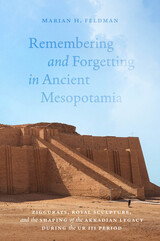 Remembering and Forgetting in Ancient Mesopotamia: Ziggurats, Royal Sculpture, and the Shaping of the Akkadian Legacy During the Ur III Period
Marian H. Feldman
University of Chicago Press, 2025 A study of how our understanding of Akkadian history has been shaped by subsequent dynasties.
In this innovative new study of ancient Mesopotamian art and architecture, Marian H. Feldman examines the complex legacy of the Akkadian dynasty, which spanned ca. 2350-2150 BCE in the region now known as southern Iraq. The Akkadian state played an essential role in the formation and expression of subsequent political entities in the region, yet our understanding of this period is based primarily on the historical lens of their successors, in particular the rulers of the Third Dynasty of Ur (ca. 2100-1000 BCE). Focusing on four remaining ziggurats in Ur, Eridu, Uruk, and Nippur, as well as surviving statues and steles, Feldman examines how the Ur III rulers selectively curated and erased Akkadian structures and monuments to serve their own political ambitions. Analyzing the archaeological evidence of Ur III building practices and the display of Akkadian royal sculpture, she considers the role of sacred spaces in our knowledge of the period and imagines how the cultivation of the Akkadian narrative helped the Ur III dynasty centralize its power. In so doing, this book proposes a new way to understand the impact of the survival—or erasure—of architectural and artistic remains on collective and historical memory.
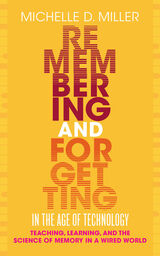 Remembering and Forgetting in the Age of Technology: Teaching, Learning, and the Science of Memory in a Wired World
Michelle D Miller
West Virginia University Press, 2022 What does memory mean for learning in an age of smartphones and search engines? Human minds are made of memories, and today those memories have competition. Biological memory capacities are being supplanted, or at least supplemented, by digital ones, as we rely on recording—phone cameras, digital video, speech-to-text—to capture information we’ll need in the future and then rely on those stored recordings to know what happened in the past. Search engines have taken over not only traditional reference materials but also the knowledge base that used to be encoded in our own brains. Google remembers, so we don’t have to. And when we don’t have to, we no longer can. Or can we? Remembering and Forgetting in the Age of Technology offers concise, nontechnical explanations of major principles of memory and attention—concepts that all teachers should know and that can inform how technology is used in their classes. Teachers will come away with a new appreciation of the importance of memory for learning, useful ideas for handling and discussing technology with their students, and an understanding of how memory is changing in our technology-saturated world.
Remembering and Repeating: On Milton's Theology and Poetics
Regina M. Schwartz
University of Chicago Press, 1993 In this graceful and compelling book, Regina Schwartz presents a powerful reading of Paradise Lost by tracing the structure of the poem to the pattern of "repeated beginnings" found in the Bible. In both works, the world order is constantly threatened by chaos. By drawing on both the Bible and the more contemporary works of, among others, Freud, Lacan, Ricoeur, Said, and Derrida, Schwartz argues that chaos does not simply threaten order, but rather, chaos inheres in order.
"A brilliant study that quietly but powerfully recharacterizes many of the contexts of discussion in Milton criticism. Particularly noteworthy is Schwartz's ability to introduce advanced theoretical perspectives without ever taking the focus of attention away from the dynamics and problematics of Milton's poem."—Stanley Fish
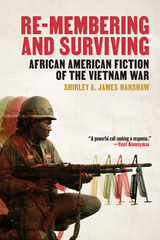 Re-Membering and Surviving: African American Fiction of the Vietnam War
Shirley A. James Hanshaw
Michigan State University Press, 2020 The first book-length critical study of the black experience in the Vietnam War and its aftermath, this text interrogates the meaning of heroism based on models from African and African American expressive culture. It focuses on four novels: Captain Blackman (1972) by John A. Williams, Tragic Magic (1978) by Wesley Brown, Coming Home (1971) by George Davis, and De Mojo Blues (1985) by A. R. Flowers. Discussions of the novels are framed within the historical context of all wars prior to Vietnam in which Black Americans fought. The success or failure of the hero on his identity quest is predicated upon the extent to which he can reconnect with African or African American cultural memory. He is engaged therefore in “re-membering,” a term laden with the specificity of race that implies a cultural history comprised of African retentions and an interdependent relationship with the community for survival. The reader will find that a common history of racism and exploitation that African Americans and Vietnamese share sometimes results in the hero’s empathy with and compassion for the so-called enemy, a unique contribution of the black novelist to American war literature.
 Remembering Archaeological Fieldwork in Mexico and Peru, 1961-2003: A Photographic Essay
Jeffrey R. Parsons
University of Michigan Press, 2019 Half a century ago, when archaeologist Jeffrey R. Parsons began fieldwork in Mexico and Peru, he could not know that many of the sites he studied were on the brink of destruction. The rural landscapes through which he traveled were, in many cases, destined to be plowed under and paved over. In Remembering Archaeological Fieldwork in Mexico and Peru, 1961–2003, Parsons offers readers a chance to see archaeological sites that were hundreds or thousands of years old and have since vanished or been irrevocably altered. Hundreds of photographs, accompanied by descriptions, illustrate the sites, the people, and the landscapes that Parsons encountered during four decades of research in these regions. Parsons is now emeritus professor of anthropology at the University of Michigan and has published many archaeological monographs as well as ethnographic research on salt, fish, and other items used for traditional subsistence in Mexico. Foreword by Richard I. Ford.
 Remembering Awatovi: The Story of an Archaeological Expedition in Northern Arizona, 1935–1939
Hester A. Davis
Harvard University Press, 2008 Remembering Awatovi is the engaging story of a major archaeological expedition on the Hopi Reservation in northern Arizona. Centered on the large Pueblo village of Awatovi, with its Spanish mission church and beautiful kiva murals, the excavations are renowned not only for the data they uncovered but also for the interdisciplinary nature of the investigations. In archaeological lore they are also remembered for the diverse, fun-loving, and distinguished cast of characters who participated in or visited the dig.
Hester Davis’s lively account—part history of archaeology, part social history—is told largely in the words of the participants, among whom were two of Davis’s siblings, artist Penny Davis Worman and archaeologist Mott Davis. Life in the remote field camp abounded with delightful storytelling, delicious food, and good-natured high-jinks. Baths were taken in a stock tank, beloved camp automobiles were given personal names, and a double bed had to be trucked across the desert and up a mesa to celebrate a memorable wedding.
Remembering Awatovi is illustrated with over 160 portraits and photographs of camp life. Essays by Eric Polingyouma and Brian Fagan enrich the presentation.
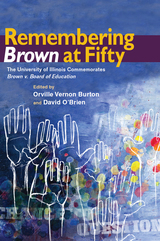 Remembering Brown at Fifty: The University of Illinois Commemorates Brown v. Board of Education
Edited by Orville Vernon Burton and David O'Brien
University of Illinois Press, 2009 Inspired by the University of Illinois's celebration of the Brown v. Board of Education decision's fiftieth anniversary, this collection addresses the significance of Brown in the contributors' lives or work in education and civil rights. Several authors describe their personal roles in the Brown case or similar cases, while others examine and illustrate events, performances, and exhibitions that were part of the anniversary commemoration. The book not only explores the repercussions of the Brown decision, but also stands as a historic document in its own right, preserving the reactions of many prominent intellectuals, artists, and activists fifty years after the decision.
Contributors are Kal Alston, Margaret L. Andersen, Kathryn H. Anthony, Nathaniel C. Banks, Bernice McNair Barnett, Christopher Benson, Ed Blankenheim, Julian Bond, Orville Vernon Burton, Jason Chambers, Constance Curry, Joseph A. De Laine Jr., Mary L. Dudziak, Joe R. Feagin, John Hope Franklin, Ophelia De Laine Gona, Lani Guinier, Darlene Clark Hine, Freeman A. Hrabowski III, John Jennings, Ralph Lemon, George Lipsitz, Jim Loewen, Laughlin McDonald, David O'Brien, James C. Onderdonk, Sekou Sundiata, Christopher Teal, Nicholas Watkins, Carrie Mae Weems, Juan Williams, and Joy Ann Williamson.
 Remembering Bulldog Turner: Unsung Monster of the Midway
Michael Barr; foreword by Lew Freedman
Texas Tech University Press, 2013 Clyde “Bulldog” Turner rose from the West Texas plains to become an early lynchpin of the Chicago Bears and the NFL and one of the greatest linemen of the pre-television era. Fame, however, did not stick to Bulldog Turner because the positions he played rarely made headlines. Bulldog played center and linebacker, while the recognition, glory, and money went to those who scored touchdowns. Like Pudge Heffelfinger, Fats Henry, Ox Emerson, George Trafton, Bruiser Kinard, Adolph Shultz, or Mel Hein, Bulldog Turner is a ghostly character from football’s leather helmet days.
Still, no man played his positions better than Bulldog Turner. He was the ideal combination of size and speed, and every coach’s dream: a lineman who could block like a bulldozer, run like a halfback, and catch like a receiver.
Despite his talents, Bulldog never made much money playing football, and what he did earn slipped through his fingers like sand. When he retired, his iconic nickname faded from memory. He died in relative obscurity on what remained of his Texas ranch. Remembering Bulldog Turner brings an NFL great into the limelight he never enjoyed as a football player.
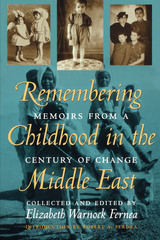 Remembering Childhood in the Middle East: Memoirs from a Century of Change
Collected and edited by Elizabeth Warnock Fernea
University of Texas Press, 2002 Growing up is a universal experience, but the particularities of homeland, culture, ethnicity, religion, family, and so on make every childhood unique. To give Western readers insight into what growing up in the Middle East was like in the twentieth century, this book gathers thirty-six original memoirs written by Middle Eastern men and women about their own childhoods. Elizabeth Warnock Fernea, a well-known writer of books and documentary films about women and the family in the Middle East, has collected stories of childhoods spent in Egypt, Iran, Iraq, Israel, Jordan, Kuwait, Lebanon, Morocco, Palestine, Saudi Arabia, Sudan, Syria, Tunisia, and Turkey. The accounts span the entire twentieth century, a full range of ethnicities and religions, and the social spectrum from aristocracy to peasantry. They are grouped by eras, for which Fernea provides a concise historical sketch, and include a brief biography of each contributor. The introduction by anthropologist Robert A. Fernea sets the memoirs in the larger context of Middle Eastern life and culture. As a collection, the memoirs offer an unprecedented opportunity to look at the same period in history in the same region of the world from a variety of very different remembered experiences. At times dramatic, humorous, or tragic, and always deeply felt, the memoirs document the diversity and richness of people's lives in the modern Middle East.
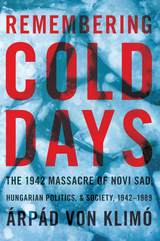 Remembering Cold Days: The 1942 Massacre of Novi Sad and Hungarian Politics and Society, 1942-1989
Arpad von Klimo
University of Pittsburgh Press, 2018 Between three and four thousand civilians, primarily Serbian and Jewish, were murdered in the Novi Sad massacre of 1942. Hungarian soldiers and gendarmes carried out the crime in the city and surrounding areas, in territory Hungary occupied after the German attack on Yugoslavia. The perpetrators believed their acts to be a contribution to a new order in Europe, and as a means to ethnically cleanse the occupied lands.
In marked contrast to other massacres, the Horthy regime investigated the incident and tried and convicted the commanding officers in 1943-44. Other trials would follow. During the 1960s, a novel and film telling the story of the massacre sparked the first public open debate about the Hungarian Holocaust.
This book examines public contentions over the Novi Sad massacre from its inception in 1942 until the final trial in 2011. It demonstrates how attitudes changed over time toward this war crime and the Holocaust through different political regimes and in Hungarian society. The book also views how the larger European context influenced Hungarian debates, and how Yugoslavia dealt with memories of the massacre.
 Remembering Communism: Private and Public Recollections of Lived Experience in Southeast Europe
Contributors: Simina Bădica, Iskra Baeva, Tanya Boneva, Corina Cimpoieru, Liliana Deyanova, Albena Hranova, Nataliya Hristova, Petya Kabakchieva, Evgenia Kalinova, Anny Kirilova, Thomas Lindenberger, Tamás Lőnhárt, Izabella Main, Tsvetana Manova, Iliiana Marcheva, Vasil Markov, Andi Mihalache, Cătălina Mihalache, Milla Mineva, Cristina Petrescu, Dragoş Petrescu, Vania Stoyanova, Virgiliu Ţârău, Nikolai Vukov, Smaranda Vultur
Central European University Press, 2014 Remembering Communism examines the formation and transformation of the memory of communism in the post-communist period. The majority of the articles focus on memory practices in the post-Stalinist era in Bulgaria and Romania, with occasional references to the cases of Poland and the GDR. Based on an interdisciplinary approach, including history, anthropology, cultural studies and sociology, the volume examines the mechanisms and processes that influence, determine and mint the private and public memory of communism in the post-1989 era. The common denominator to all essays is the emphasis on the process of remembering in the present, and the modalities by means of which the present perspective shapes processes of remembering, including practices of commemoration and representation of the past. The volume deals with eight major thematic blocks revisiting specific practices in communism such as popular culture and everyday life, childhood, labor, the secret police, and the perception of “the system”.
 Re-membering Culture: Erasure and Renewal in Hmong American Education
Bic Ngo
University of Minnesota Press, 2024 The untold stories of resilience in Hmong American education
Re-membering Culture is a deep exploration of the intricate dynamics of cultural memory and education, centering the experiences of Hmong American students and educators. Arguing that the school, as a product of coloniality, perpetuates the marginalization and erasure of non-Western epistemologies, author Bic Ngo sheds light on the subtle yet impactful process of structured forgetting within the American education system. This politics of forgetting, in turn, contributes to the fragmentation of Hmong cultural heritage, identity, and community. Based on a high school in an urban center with a considerable Hmong immigrant community, Ngo’s work draws on extensive ethnographic research with Hmong American community leaders, school administrators, parents, teachers, staff, and high school students to understand how they navigate the terrain of Western pedagogy while attempting to retain and preserve Hmong knowledge systems. Exploring a range of school experiences, Ngo traverses students’ challenges in balancing school with family life and the everyday cultural racism encountered in the classroom as well as grassroots efforts to preserve culture, including the establishment of a Hmong Cultural Club. Highlighting these experiences and voices, Ngo provides a nuanced understanding of the challenges Hmong Americans face within an assimilationist society while contesting the dominant anti-immigrant narratives of refugee suffering and poverty. Through these practices of (re)storytelling, resurgence, and refusal, she underscores the agency of the Hmong American community, illuminating how the critical consciousness fostered by re-membering serves as a powerful tool in confronting white hegemonic ideologies in education. Retail e-book files for this title are screen-reader friendly.
Remembering Elizabeth Bishop: An Oral Biography
Gary Fountain
University of Massachusetts Press, 1994 This book interweaves more than 120 interviews with relatives, friends, colleagues, and students of Elizabeth Bishop (1911-1979), one of America's finest poets. Among the interviewees are numerous intellectual and artistic figures, including John Ashbery, Robert Fitzgerald, Robert Giroux, Clement Grenberg, Thom Gunn, John Hollander, Mary McCarthy, James Merrill, Katha Pollitt, Ned Rorem, Lloyd Schwartz, Anne Stevenson, Rosalyn Turek, Helen Vendler, and Richard Wilber.
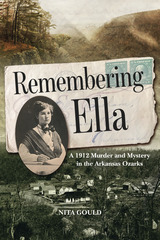 Remembering Ella: A 1912 Murder and Mystery in the Arkansas Ozarks
Nita Gould
Butler Center for Arkansas Studies, 2018 In November 1912, popular and pretty eighteen-year-old Ella Barham was raped, murdered, and dismembered in broad daylight near her home in rural Boone County, Arkansas. The brutal crime sent shockwaves through the Ozarks and made national news. Authorities swiftly charged a neighbor, Odus Davidson, with the crime. Locals were determined that he be convicted, and threats of mob violence ran so high that he had to be jailed in another county to ensure his safety. But was there enough evidence to prove his guilt? If so, had he acted alone? What was his motive?
This examination of the murder of Ella Barham and the trial of her alleged killer opens a window into the meaning of community and due process during a time when politicians and judges sought to professionalize justice, moving from local hangings to state-run executions. Davidson’s appeal has been cited as a precedent in numerous court cases and his brief was reviewed by the lawyers in Georgia who prepared Leo Frank’s appeal to the U.S. Supreme Court in 1915.
Author Nita Gould is a descendant of the Barhams of Boone County and Ella Barham’s cousin. Her tenacious pursuit to create an authoritative account of the community, the crime, and the subsequent legal battle spanned nearly fifteen years. Gould weaves local history and short biographies into her narrative and also draws on the official case files, hundreds of newspaper accounts, and personal Barham family documents. Remembering Ella reveals the truth behind an event that has been a staple of local folklore for more than a century and still intrigues people from around the country.
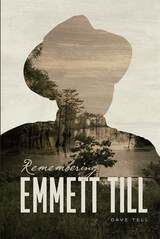 Remembering Emmett Till
Dave Tell
University of Chicago Press, 2019 Take a drive through the Mississippi Delta today and you’ll find a landscape dotted with memorials to major figures and events from the civil rights movement. Perhaps the most chilling are those devoted to the murder of Emmett Till, a tragedy of hate and injustice that became a beacon in the fight for racial equality. The ways this event is remembered have been fraught from the beginning, revealing currents of controversy, patronage, and racism lurking just behind the placid facades of historical markers.
In Remembering Emmett Till, Dave Tell gives us five accounts of the commemoration of this infamous crime. In a development no one could have foreseen, Till’s murder—one of the darkest moments in the region’s history—has become an economic driver for the Delta. Historical tourism has transformed seemingly innocuous places like bridges, boat landings, gas stations, and riverbeds into sites of racial politics, reminders of the still-unsettled question of how best to remember the victim of this heinous crime. Tell builds an insightful and persuasive case for how these memorials have altered the Delta’s physical and cultural landscape, drawing potent connections between the dawn of the civil rights era and our own moment of renewed fire for racial justice.
 Remembering Ezra Vogel
Martin K. Whyte and Mary C. Brinton
Harvard University Press, 2022 Ezra F. Vogel (July 11, 1930–December 20, 2020) was one of America’s foremost experts on Asia, mastering the Japanese and Chinese languages and contributing important scholarly works on both countries, and on their relationships with each other and with the world. Starting from modest roots in an immigrant family in a small town in Ohio, he came to Harvard in 1953 to train as a sociologist. He then shifted his focus to Asia, spending almost the entirety of his life at Harvard.
Vogel had a dramatic impact around the world, not only through his scholarship and the students he trained, but also through his friendship and mentoring of journalists, diplomats, business executives, and foreign leaders as well as through his public policy advice and devotion to institution building, at Harvard as well as nationally and internationally. Active until the end, his sudden death provoked outpourings of gratitude and grief from countless people whose lives he had affected. The present volume, containing fond reminiscences from 155 diverse individuals, conveys what was so extraordinary about the character and life of Ezra Vogel.
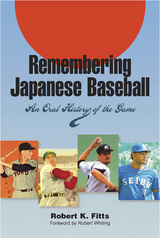 Remembering Japanese Baseball: An Oral History of the Game
Robert K. Fitts. Foreword by Robert Whiting
Southern Illinois University Press, 2005 Remembering Japanese Baseball: An Oral History of the Game transports us onto diamonds and into dugouts on the other side of the globe, where the vigorous sportsmanship of the game and the impassioned devotion of its fans transcend cultural and geographic borders and prove that baseball is fast becoming an international pastime. Called Yakyu, baseball has been played in Japan since the 1890s but has only recently gained a substantial global following. Robert K. Fitts chronicles the nation’s distinctive version of the sport as recounted by twenty-five of its players. Fitts’s careful choice of subjects represents the experiences of a mix of American and Japanese players—including stars, titleholders, and members of the Japanese Hall of Fame. Informal, candid, and remarkably specific, these recollections describe teammates and opponents, corporate owners and loyal fans, triumphs and frustrations, collectively capturing all the spirit and emotion engendered by the game from decidedly personal vantage points. Throughout, readers glimpse the unique traits of baseball in Japan and discern how the game has evolved since its inception as well as how it differs from its American counterpart. An unparalleled introduction for an American audience, Remembering Japanese Baseball is augmented by photos of its twenty-five interviewees and a timeline demarking milestone moments in the game’s Japanese history. Robert Whiting, author of You Gotta Have Wa! and The Meaning of Ichiro, provides the foreword.
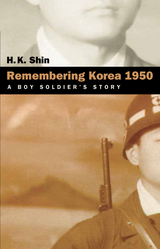 Remembering Korea 1950: A Boy Soldier's Story
H. K. Shin
University of Nevada Press, 2001 Hyung K. Shin was sixteen years old when the North Korean army invaded South Korea in June 1950. Fleeing his home, Shin soon found himself alone in Pusan, a refugee without resources or any means of support. To save himself from destitution, he lied about his age and volunteered for service in the South Korean army. Shin’s account of the months that followed is a moving record of the Korean War from the perspective of an ordinary ROK soldier. He recounts his hasty training and subsequent experiences as a battlefield soldier in North Korea, as a guard in a prisoner-of-war camp, and as a refugee again in the massive flight of civilians and ROK military personnel retreating before the onslaught of the Chinese invasion. Through it all, Shin struggles to retain his humanity and pursue his education. In the process, the naïve schoolboy becomes a man. Today, Hyung K. Shin is an internationally respected chemist, but in the pages of this memoir he carries us back to Korea during a pivotal moment in that country’s history. This is the first account in English that describes the war from the perspective of a Korean who lived through and fought in it. Shin’s detailed and lively narrative is a stirring monument to the survival of human decency and kindness in the midst of terror, cruelty, despair, and the destruction of a proud nation.
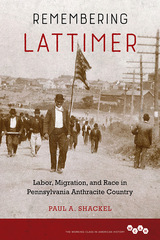 Remembering Lattimer: Labor, Migration, and Race in Pennsylvania Anthracite Country
Paul A. Shackel
University of Illinois Press, 2018 On September 10, 1897, a group of 400 striking coal miners--workers of Polish, Slovak, and Lithuanian descent or origin--marched on Lattimer, Pennsylvania. There, law enforcement officers fired without warning into the protesters, killing nineteen miners and wounding thirty-eight others. The bloody day quickly faded into history. Paul A. Shackel confronts the legacies and lessons of the Lattimer event. Beginning with a dramatic retelling of the incident, Shackel traces how the violence, and the acquittal of the deputies who perpetrated it, spurred membership in the United Mine Workers. By blending archival and archaeological research with interviews, he weighs how the people living in the region remember--and forget--what happened. Now in positions of power, the descendants of the slain miners have themselves become rabidly anti-union and anti-immigrant as Dominicans and other Latinos change the community. Shackel shows how the social, economic, and political circumstances surrounding historic Lattimer connect in profound ways to the riven communities of today. Compelling and timely, Remembering Lattimer restores an American tragedy to our public memory.
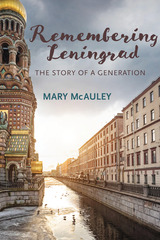 Remembering Leningrad: The Story of a Generation
Mary McAuley
University of Wisconsin Press, 2019 Englishwoman Mary McAuley first arrived in Leningrad in the early 1960s, eager to study labor relations for her thesis. Staying at a hostel, she met a number of Soviet students, many born under the rule of Joseph Stalin. Over the half-century that followed, McAuley traced their varying paths and the changing face of the former imperial capital.
Remembering Leningrad captures the story of a beautiful city and lifelong friendships. We follow McAuley as she walks through the streets downtown and examines politics in the 1960s, describes the hazards of furnishing an apartment in the 1990s, and learns about the challenges her friends have faced during these turbulent years. By weaving history and anecdotes to create a picture of Russia’s cultural center, McAuley underscores the impact of time and place on the Russian intelligentsia who lived through the transition from Soviet to post-Soviet life. The result is a remarkable group portrait of a generation.
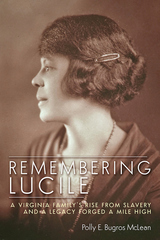 Remembering Lucile: A Virginia Family's Rise from Slavery and a Legacy Forged a Mile High
Polly E. Bugros McLean
University Press of Colorado, 2021 In 1918 Lucile Berkeley Buchanan Jones received her bachelor’s degree from the University of Colorado, becoming its first female African American graduate (though she was not allowed to "walk" at graduation, nor is she pictured in the 1918 CU yearbook). In Remembering Lucile, author Polly McLean depicts the rise of the African American middle class through the historical journey of Lucile and her family from slavery in northern Virginia to life in the American West, using their personal story as a lens through which to examine the greater experience of middle-class Blacks in the early twentieth century. The first-born daughter of emancipated slaves, Lucile refused to be defined by the racist and sexist climate of her times, settling on a career path in teaching that required great courage in the face of pernicious Jim Crow laws. Embracing her sister’s dream for higher education and W. E. B. Du Bois’s ideology, she placed education and intelligence at the forefront of her life, teaching in places where she could most benefit African American students. Over her 105 years she was an eyewitness to spectacular, inspiring, and tragic moments in American history, including horrific lynchings and systemic racism in housing and business opportunities, as well as the success of women's suffrage and Black-owned businesses and educational institutions. Remembering Lucile employs a unique blend of Black feminist historiography and wider discussions of race, gender, class, religion, politics, and education to illuminate major events in African American history and culture, as well as the history of the University of Colorado and its relationship to Black students and alumni, as it has evolved from institutional racism to welcoming acceptance. This extensive biography paints a vivid picture of a strong, extraordinary Black woman who witnessed an extraordinary time in America and rectifies her omission from CU’s institutional history. The book fills an important gap in the literature of the history of Blacks in the Rocky Mountain region and will be of significance to anyone interested in American history. Media:
Denver Post
Daily Camera
Colorado Arts & Sciences Magazine
|
|
